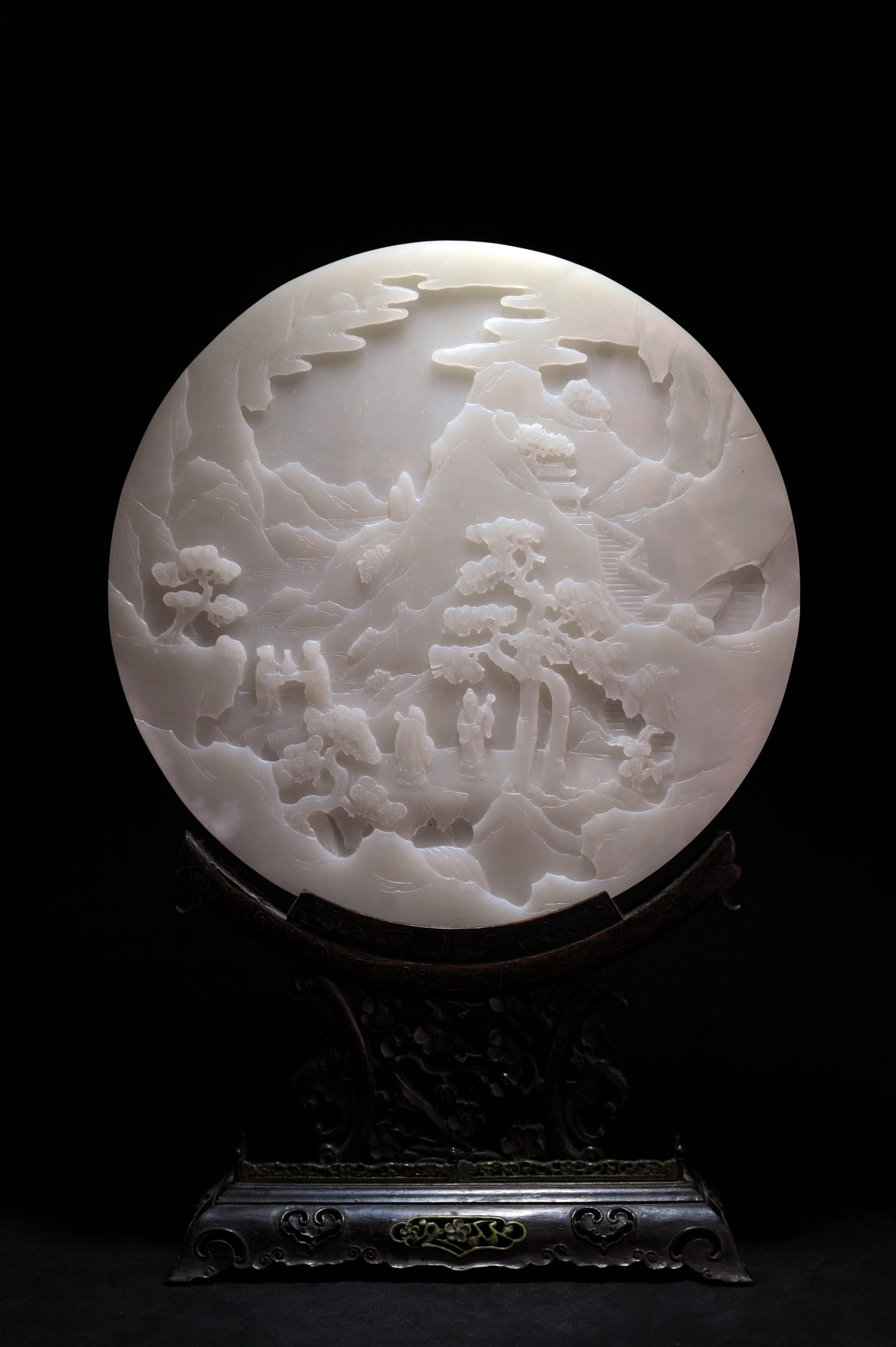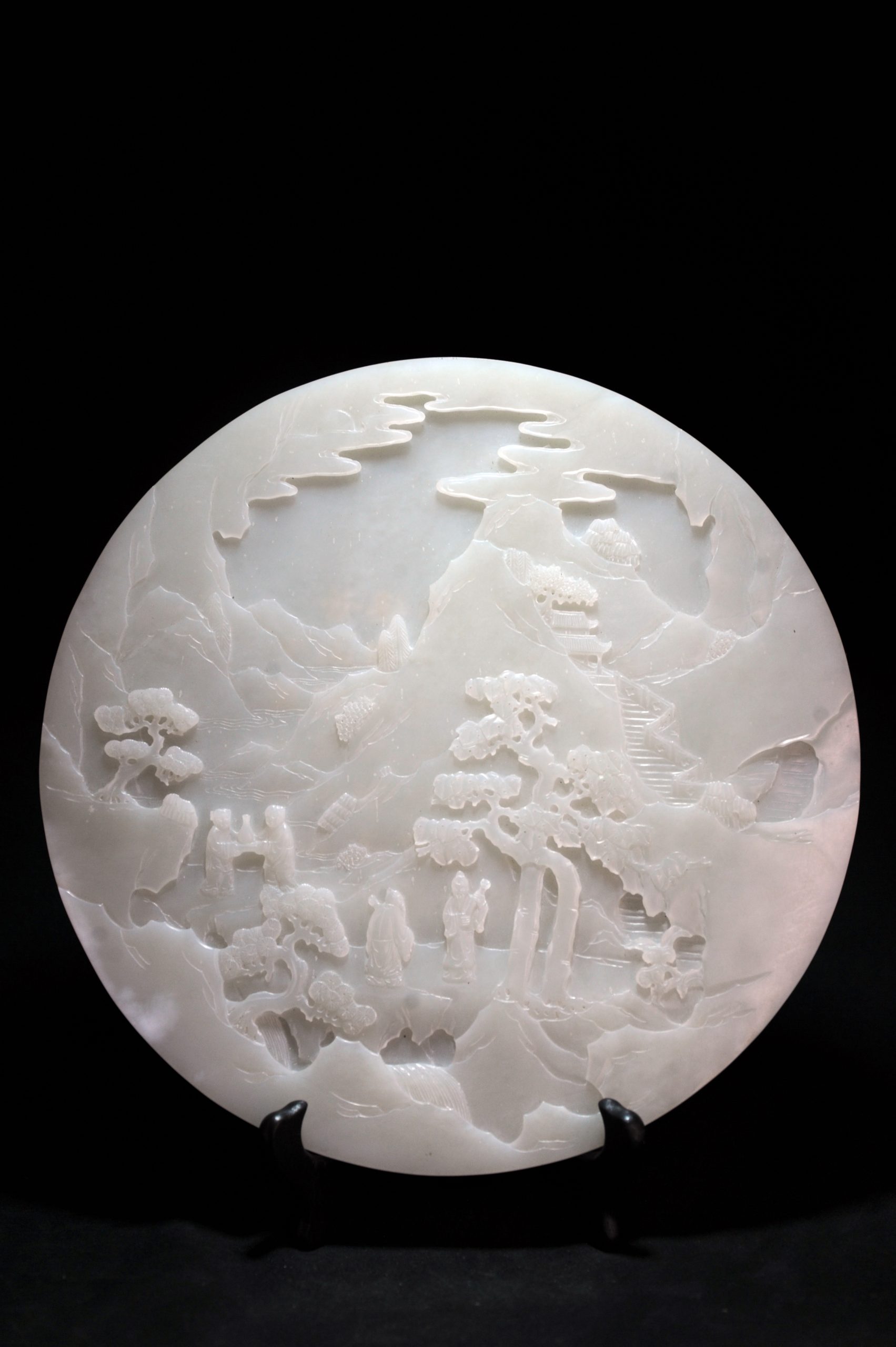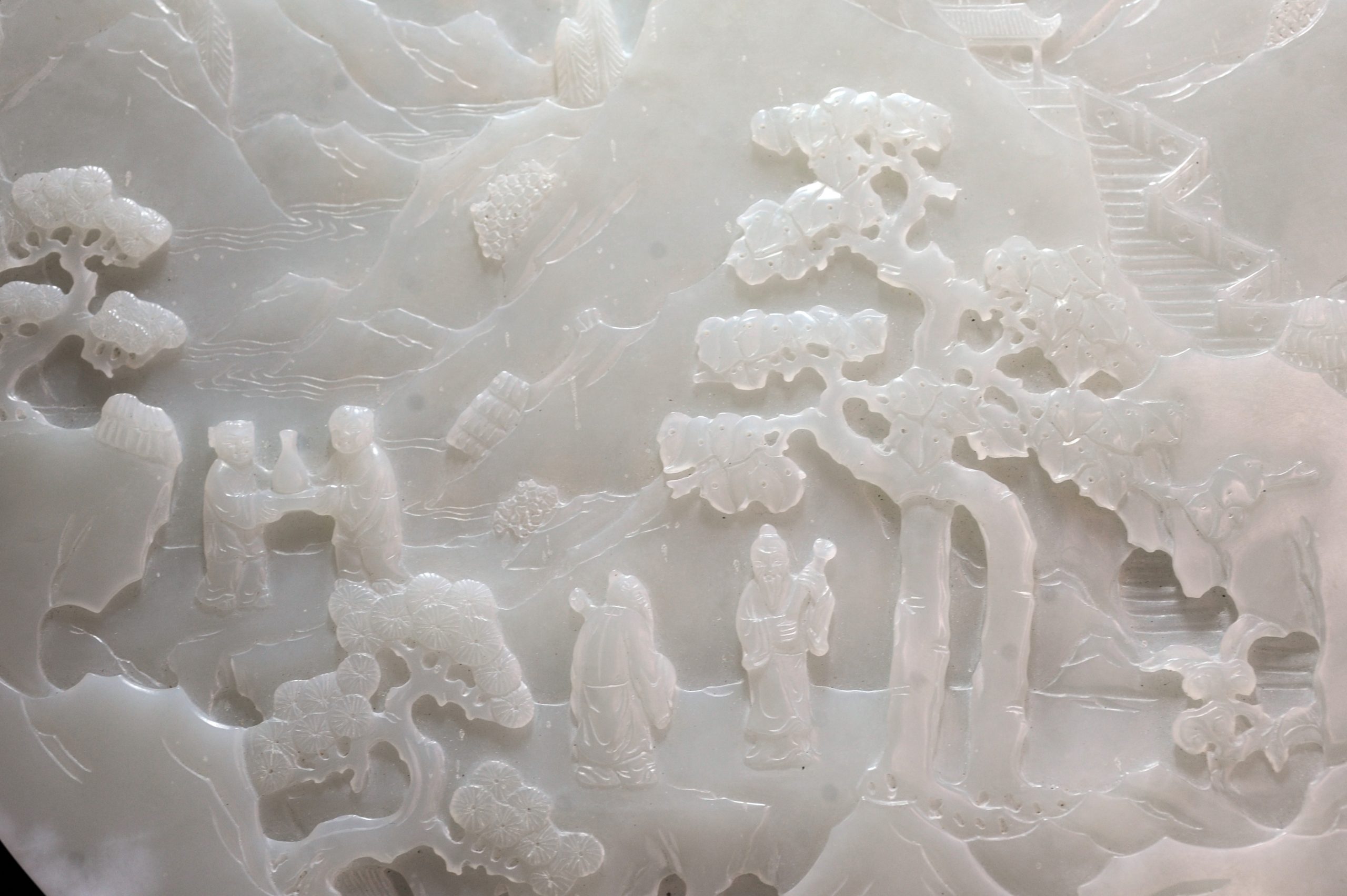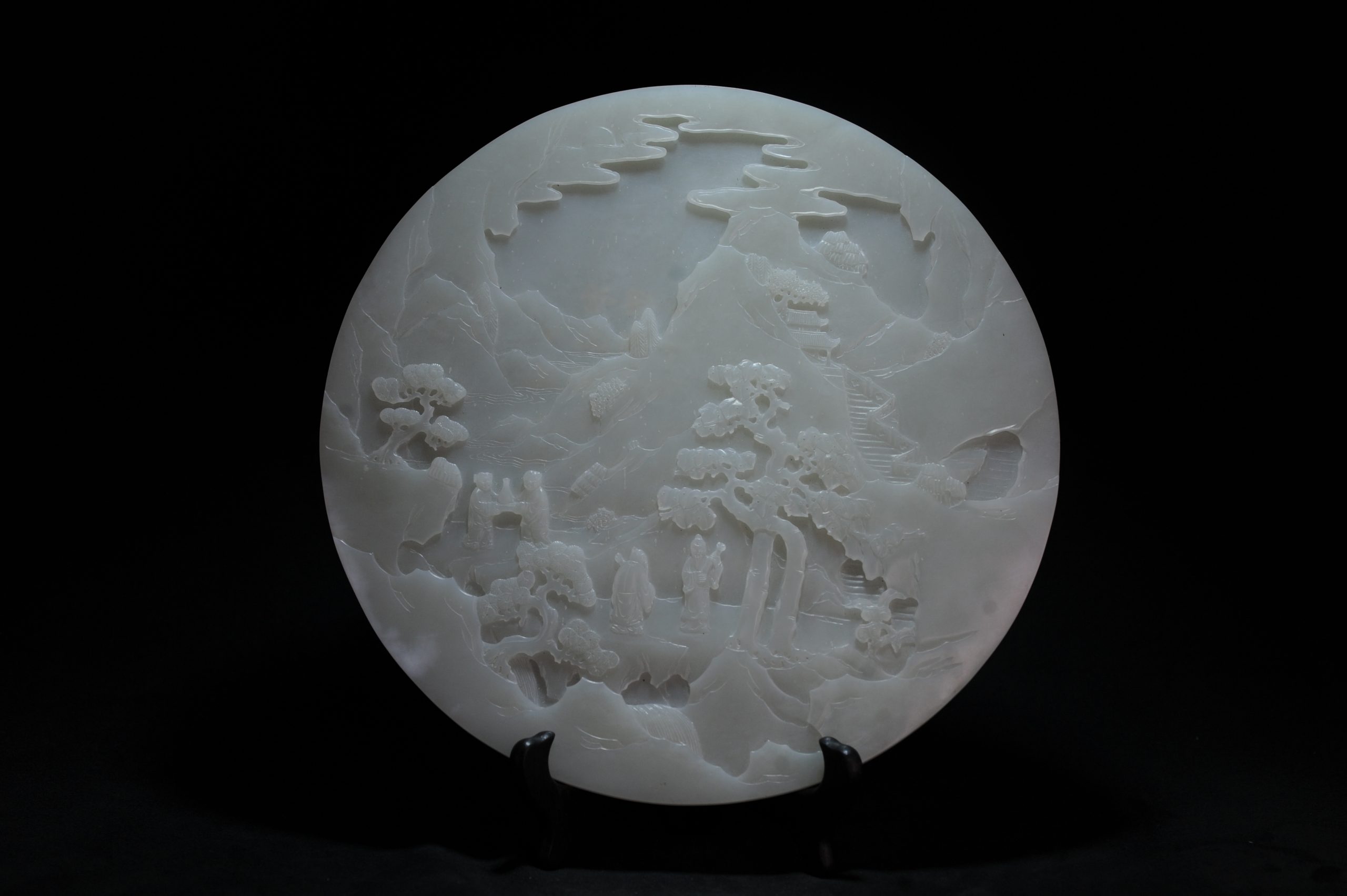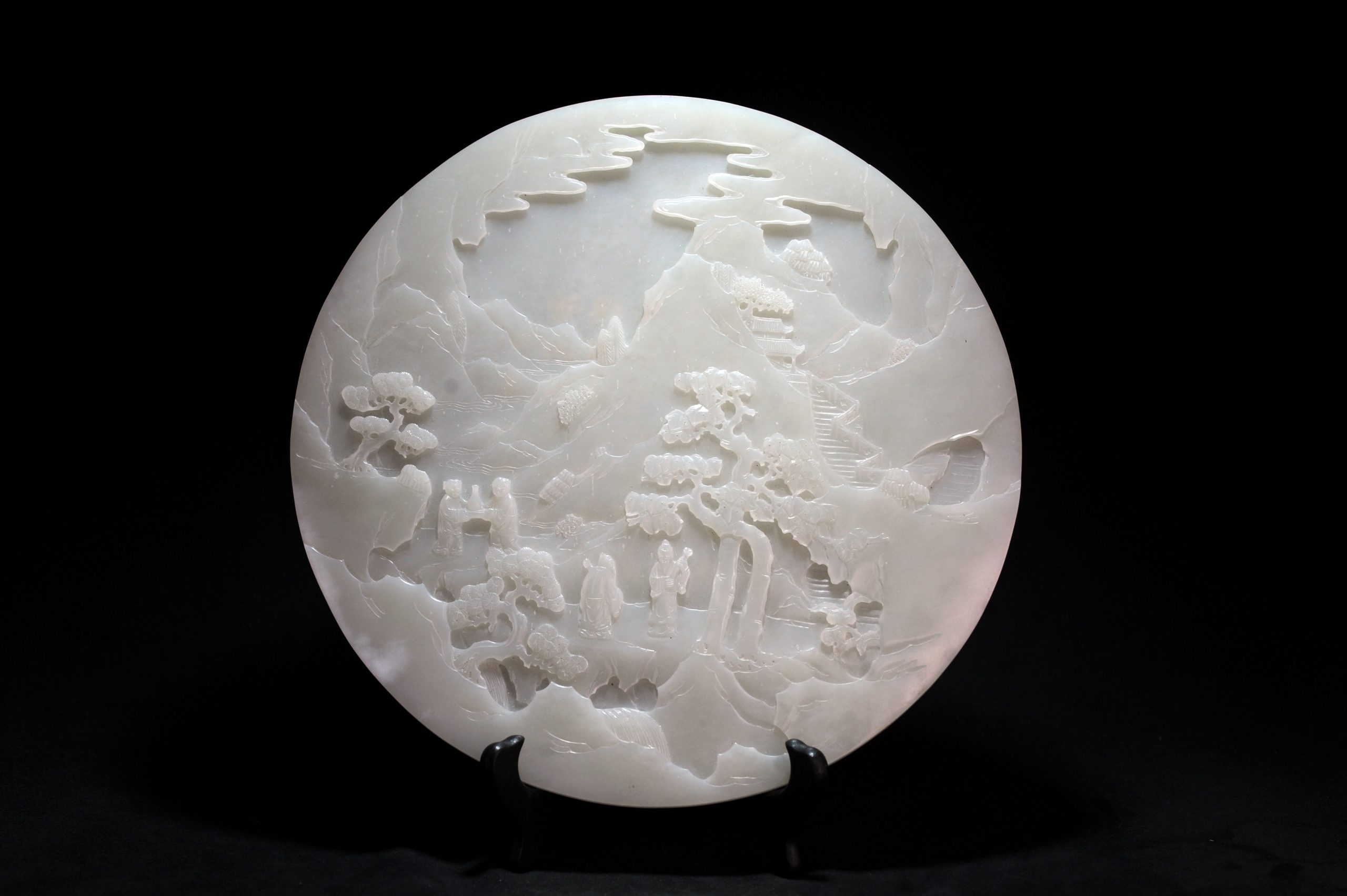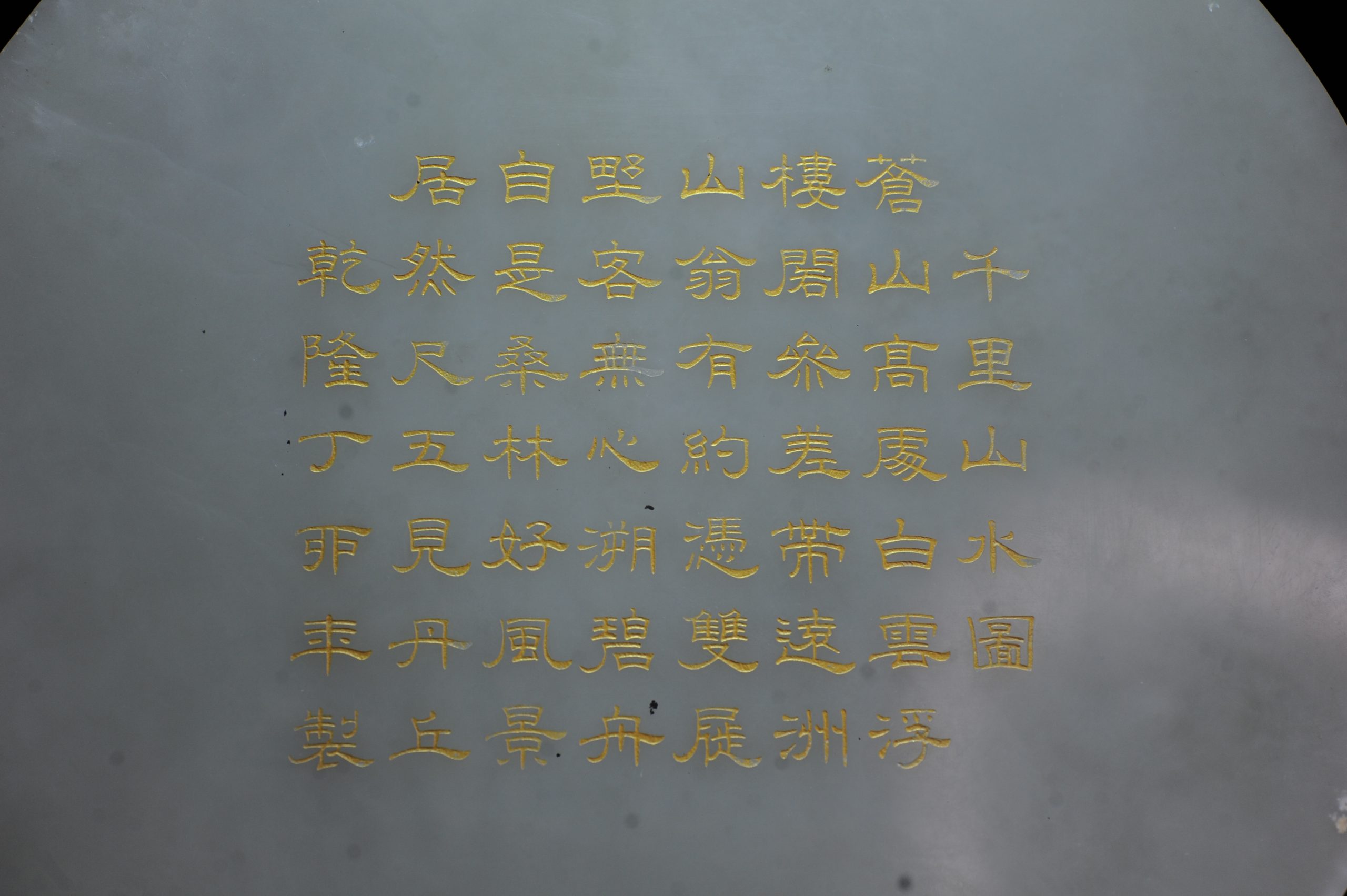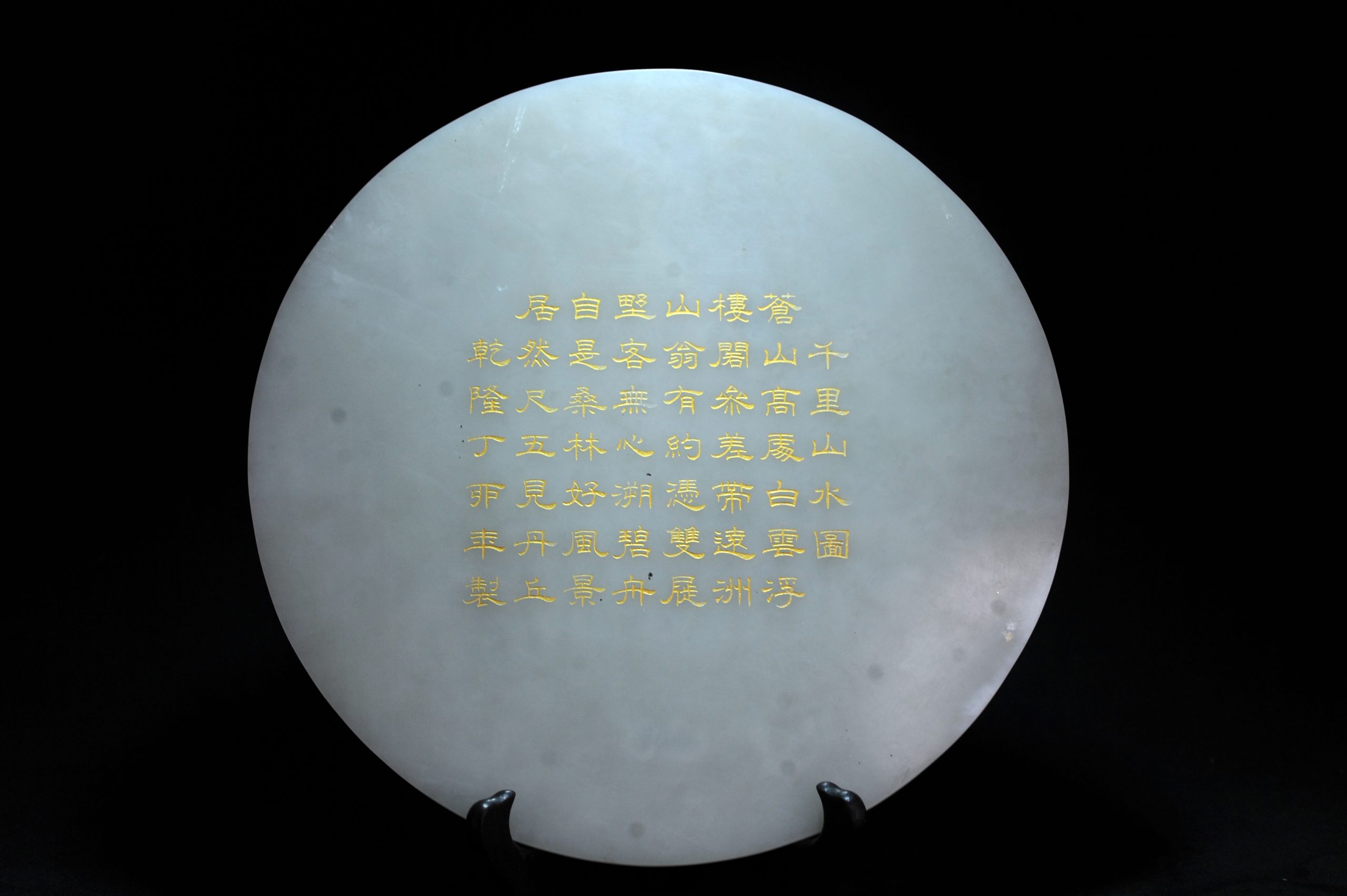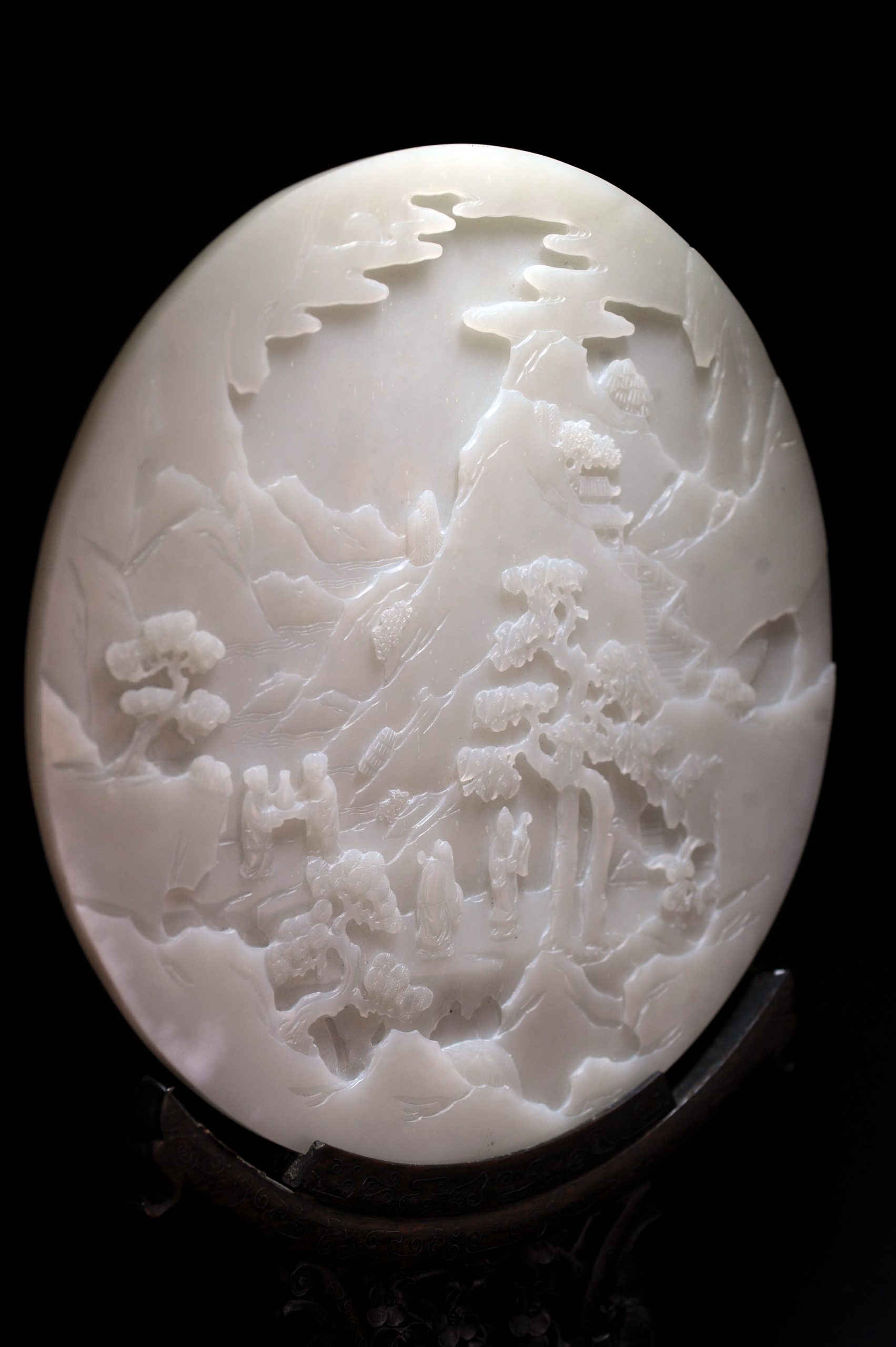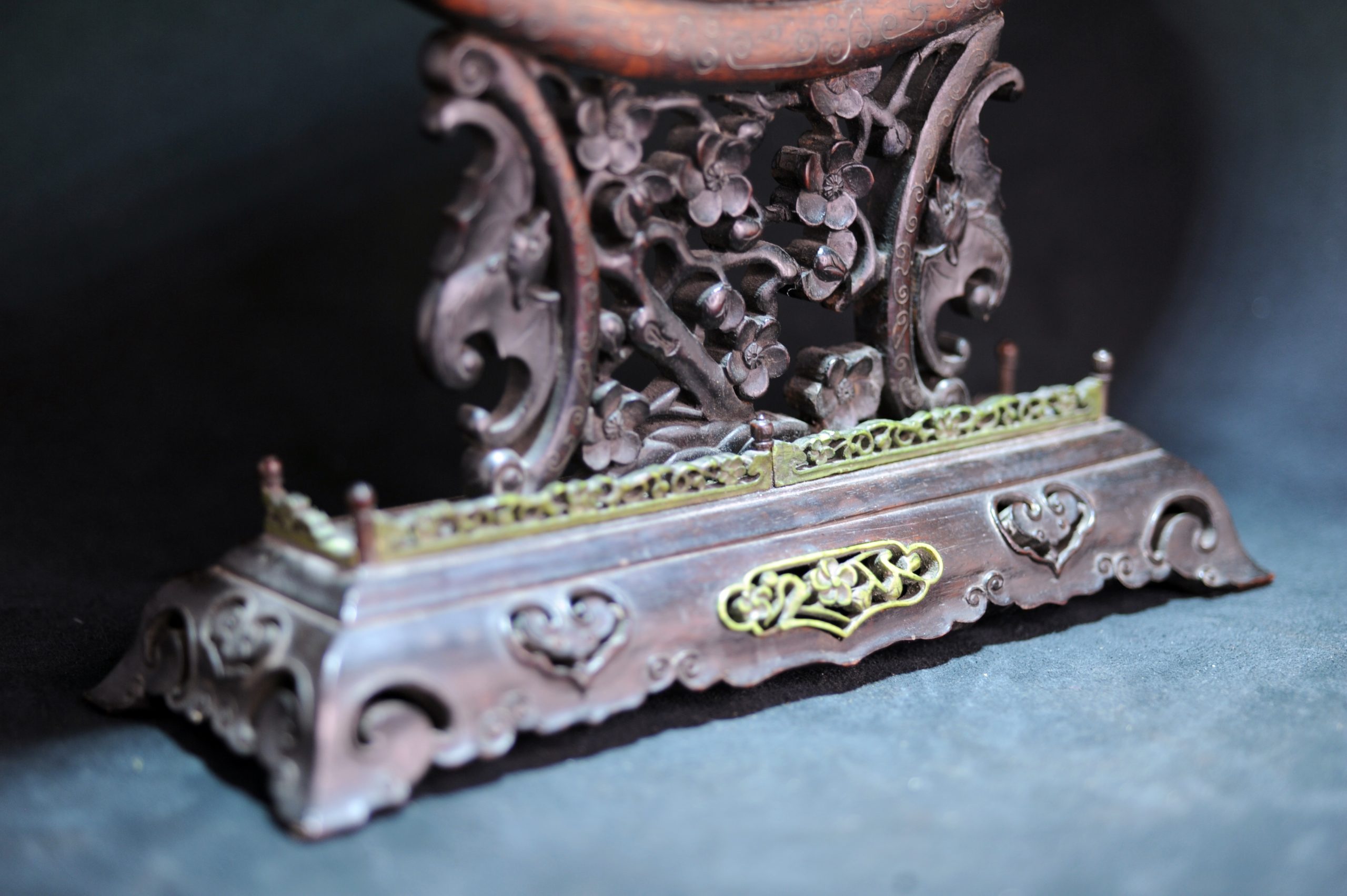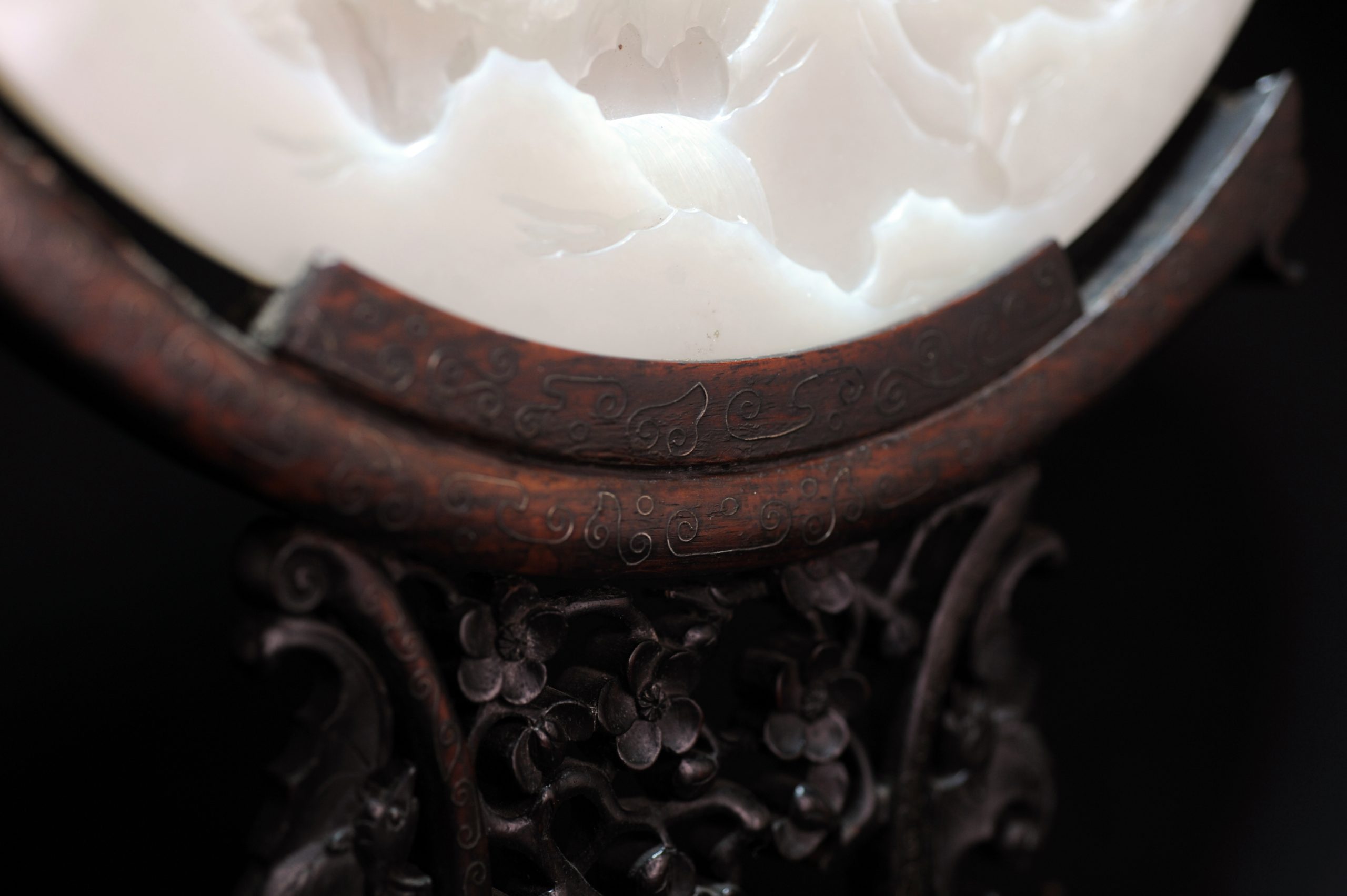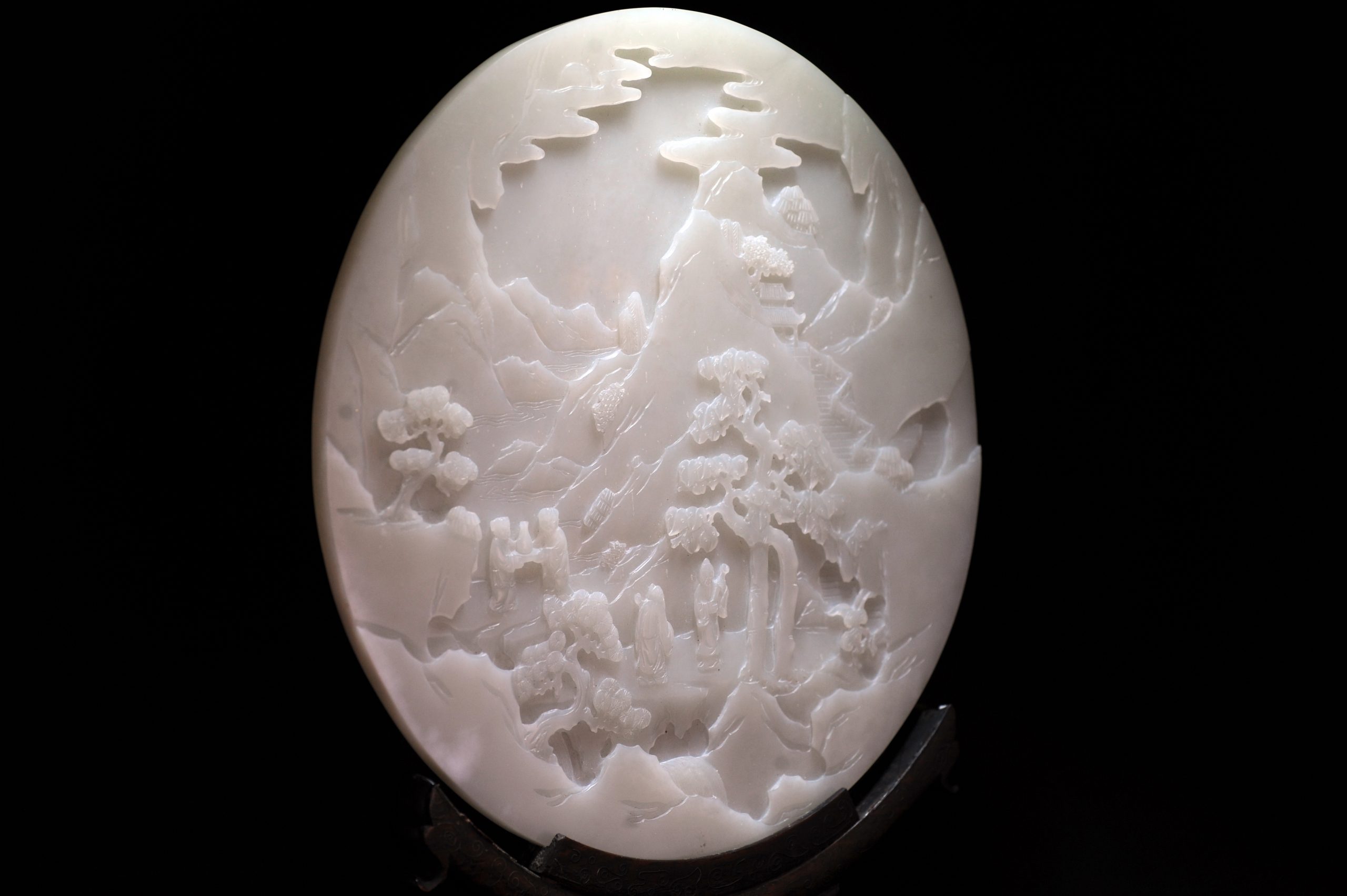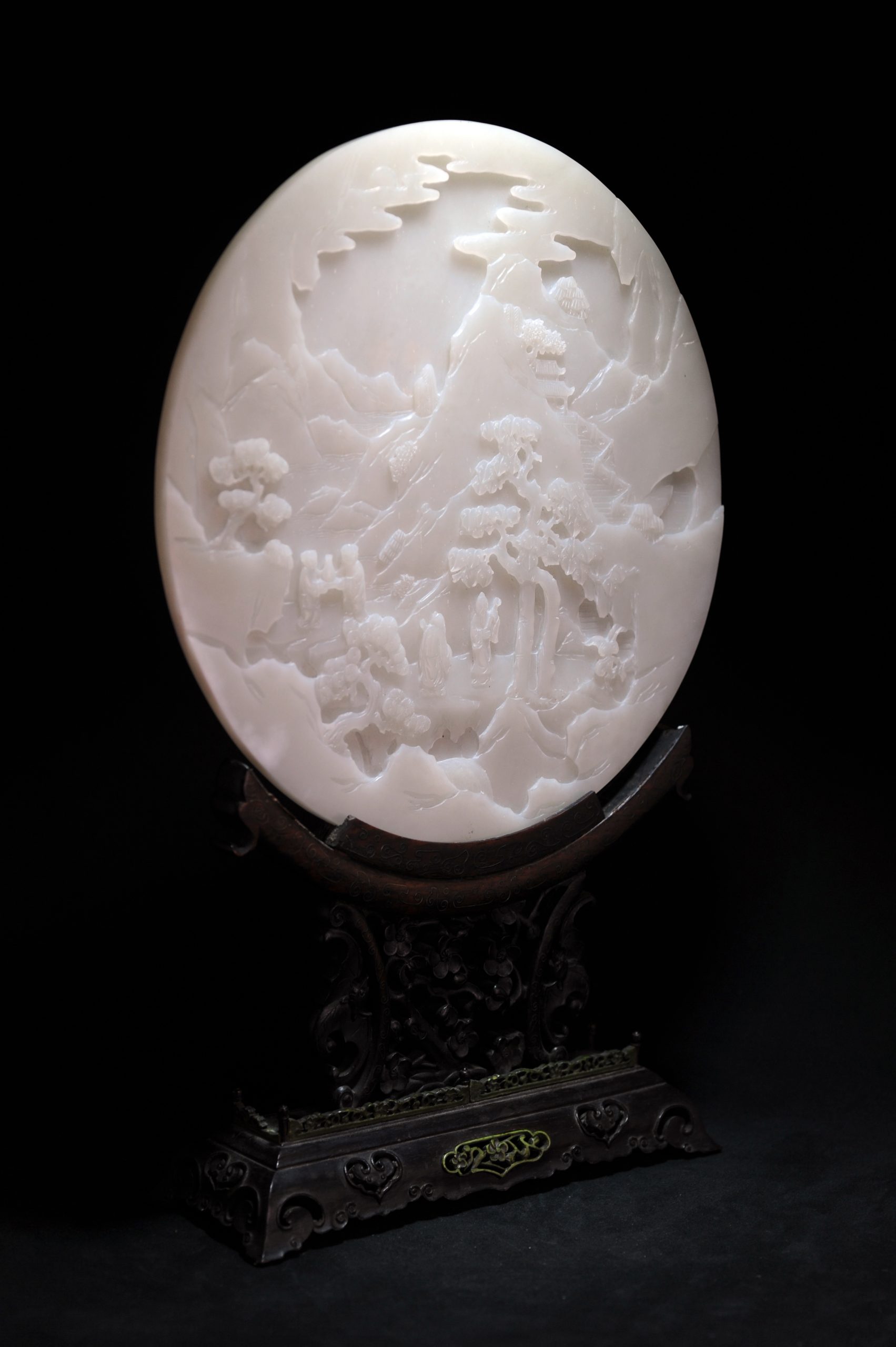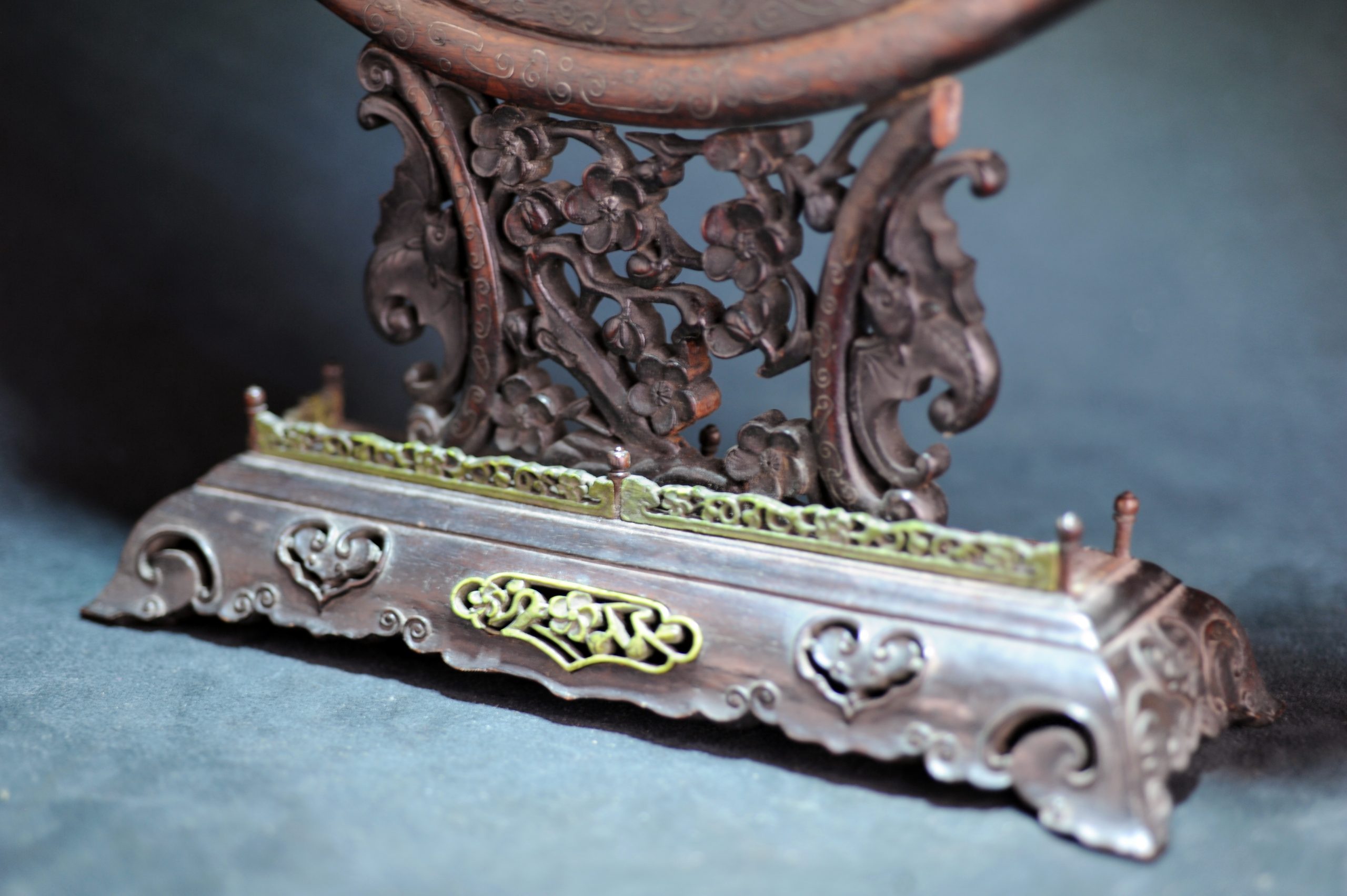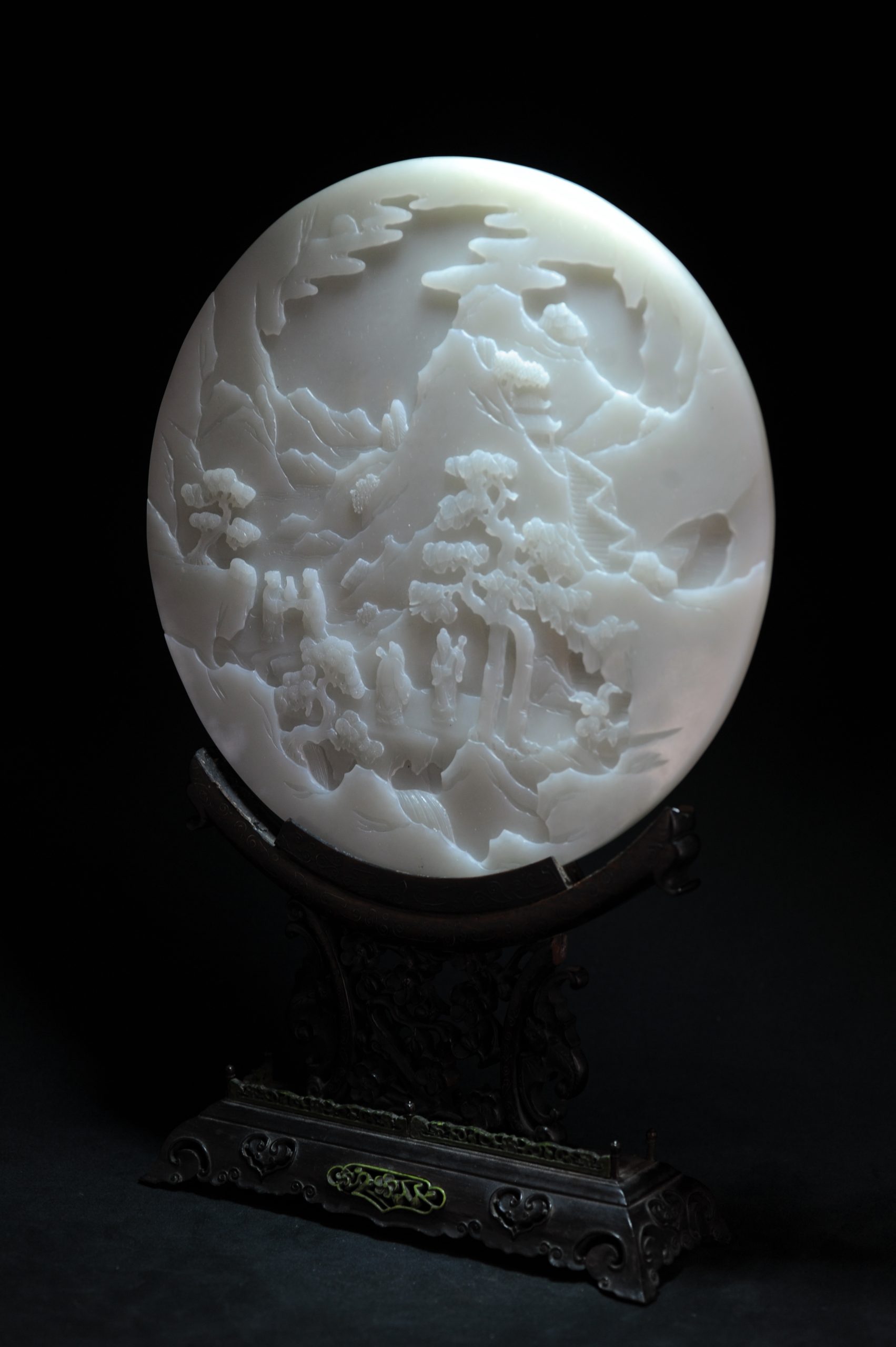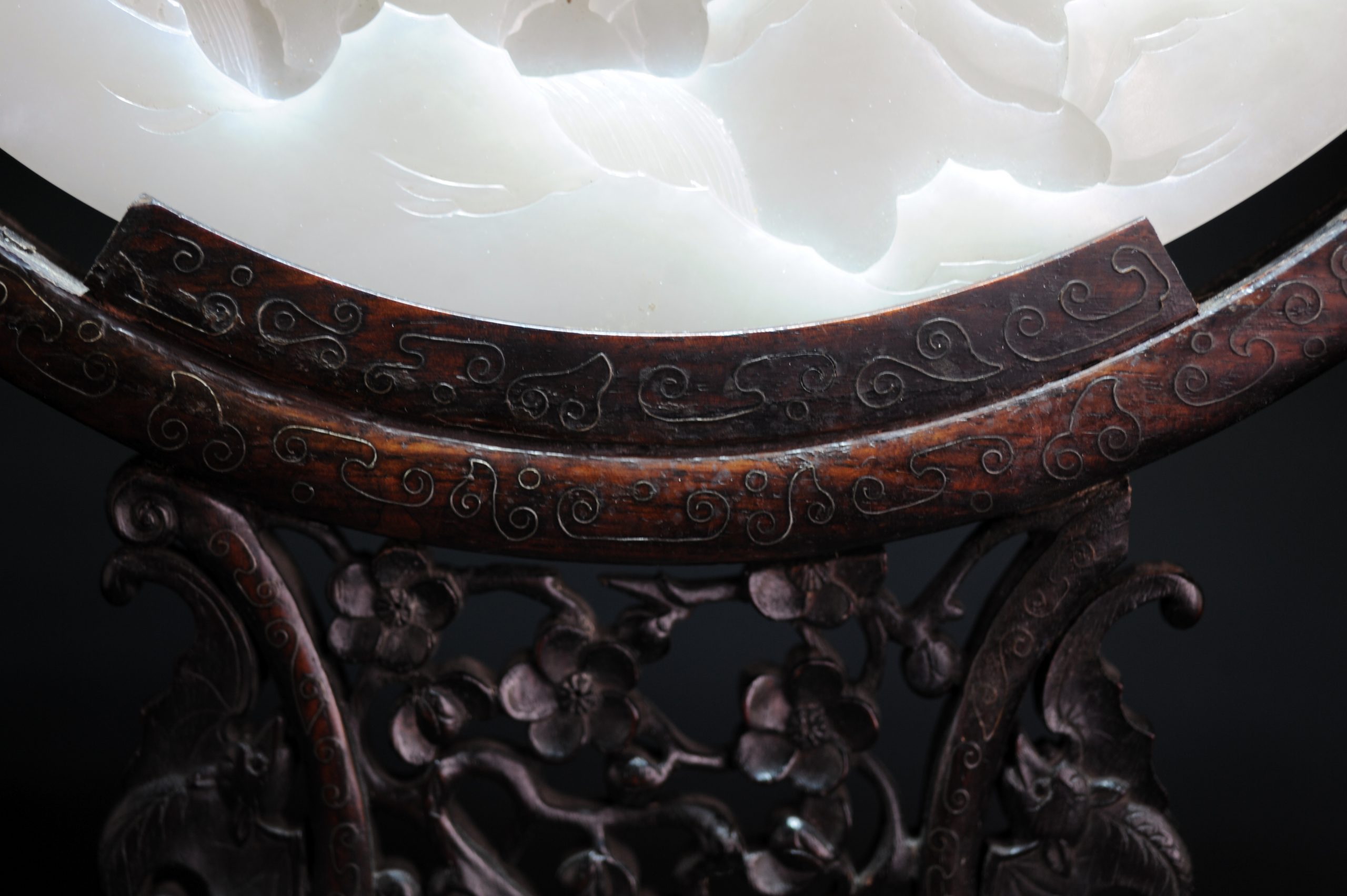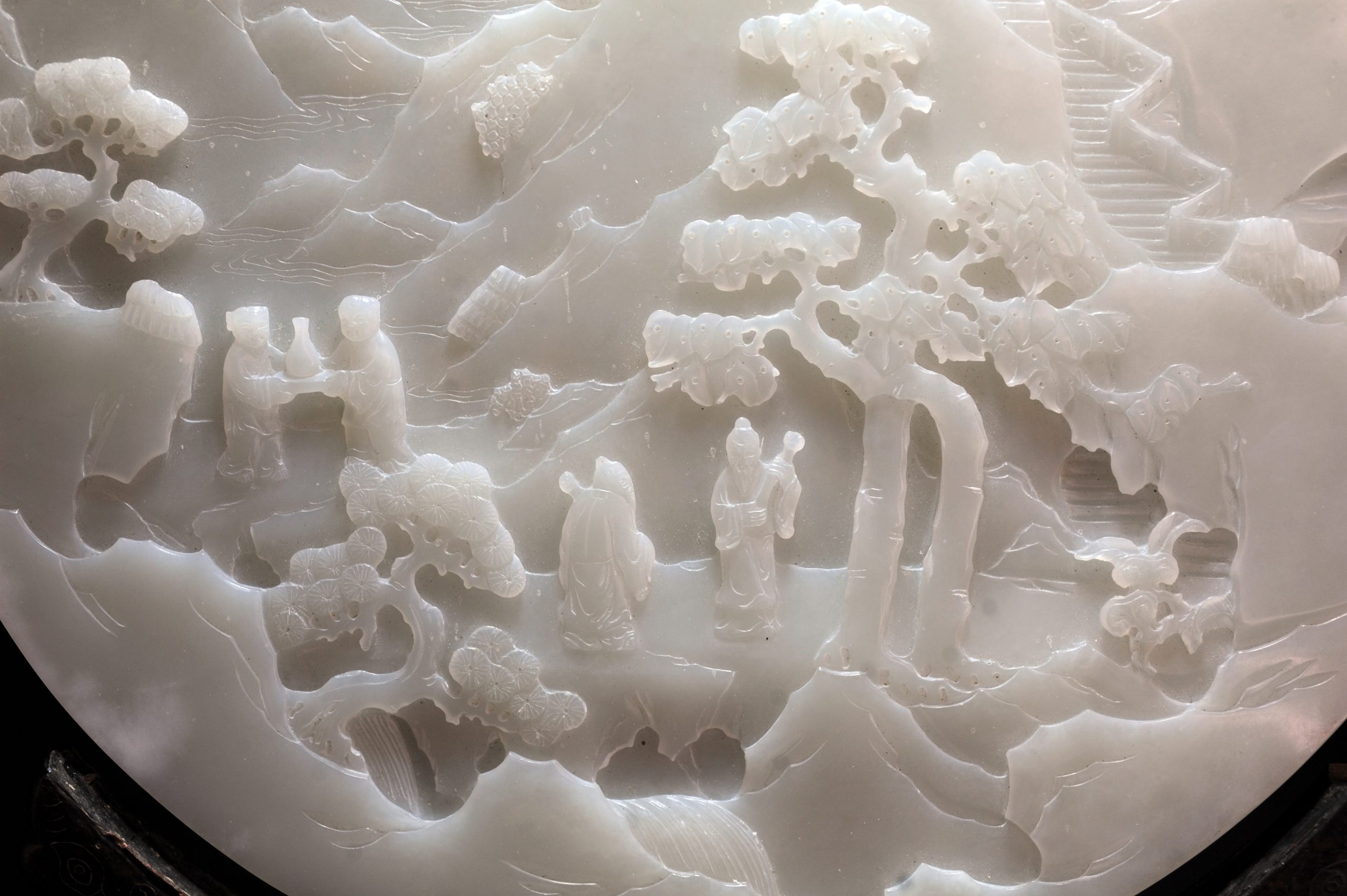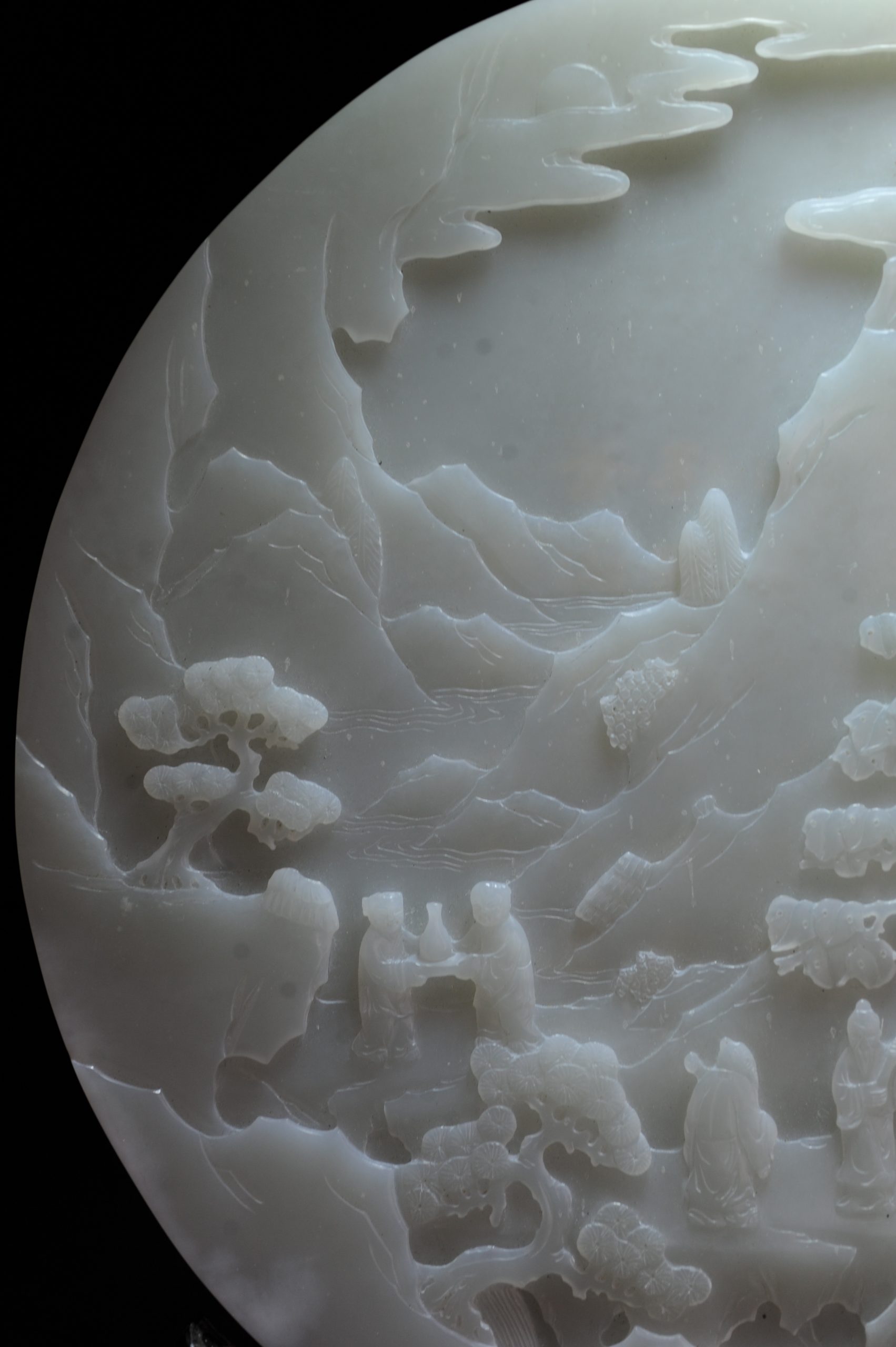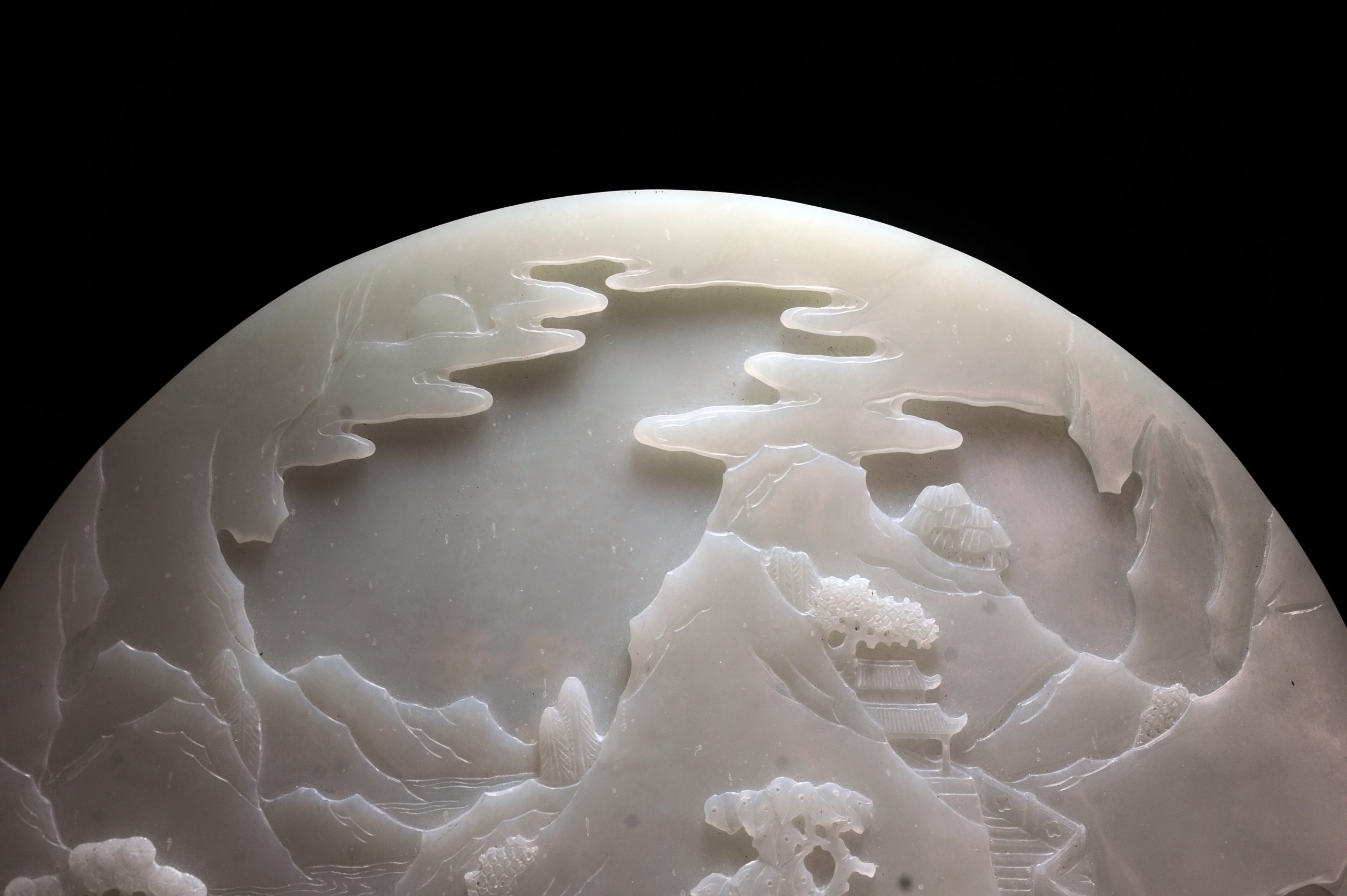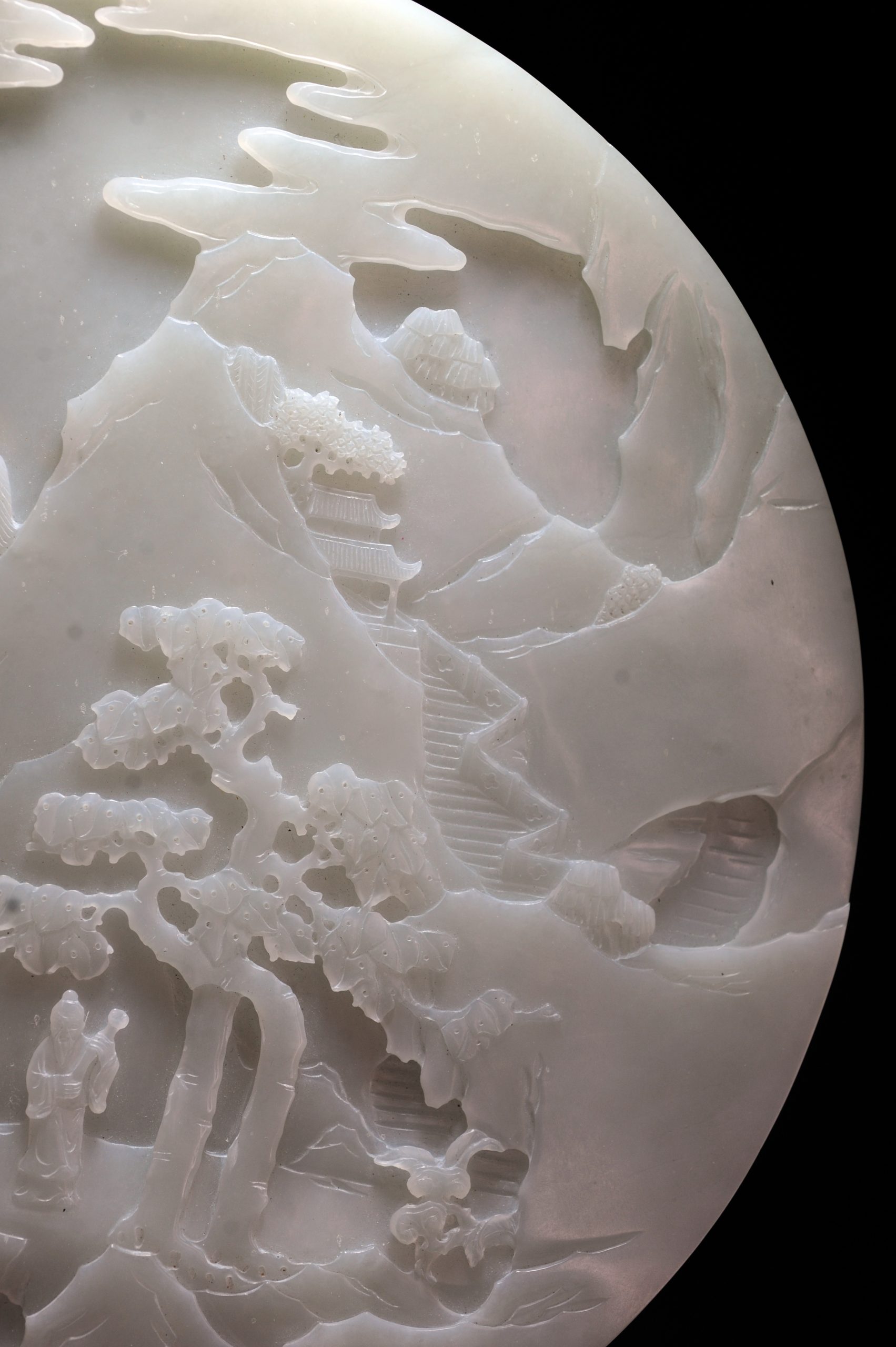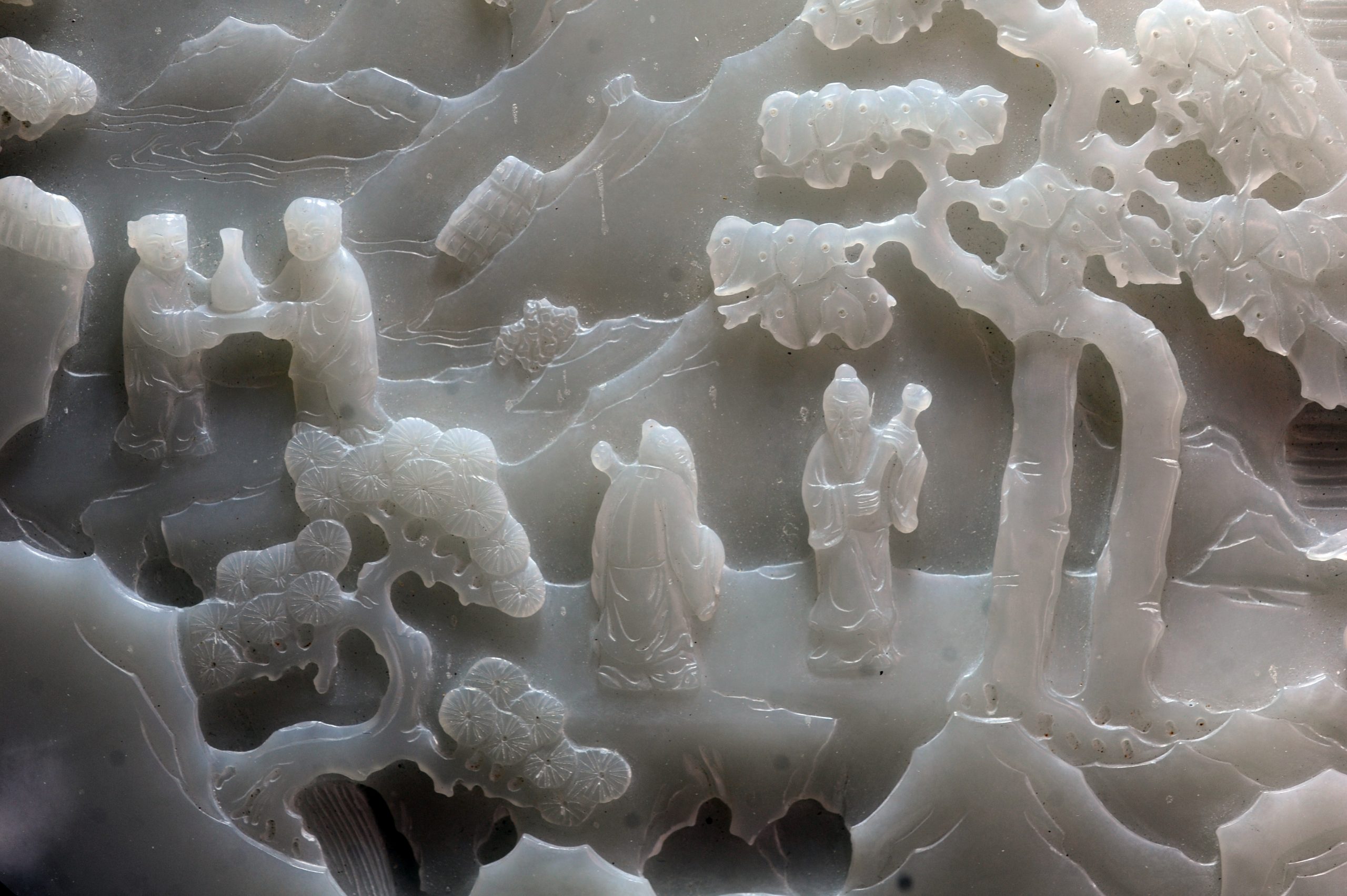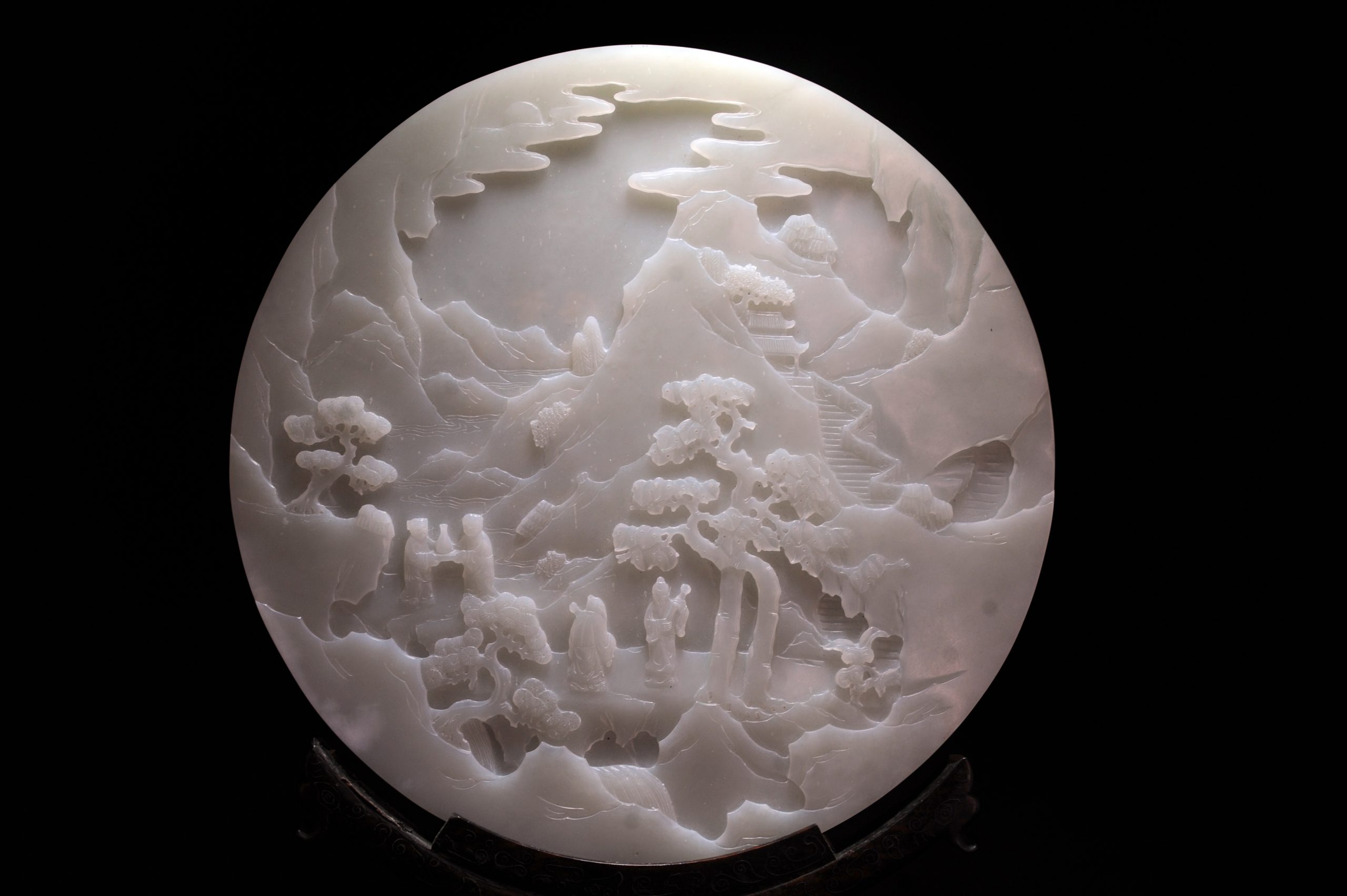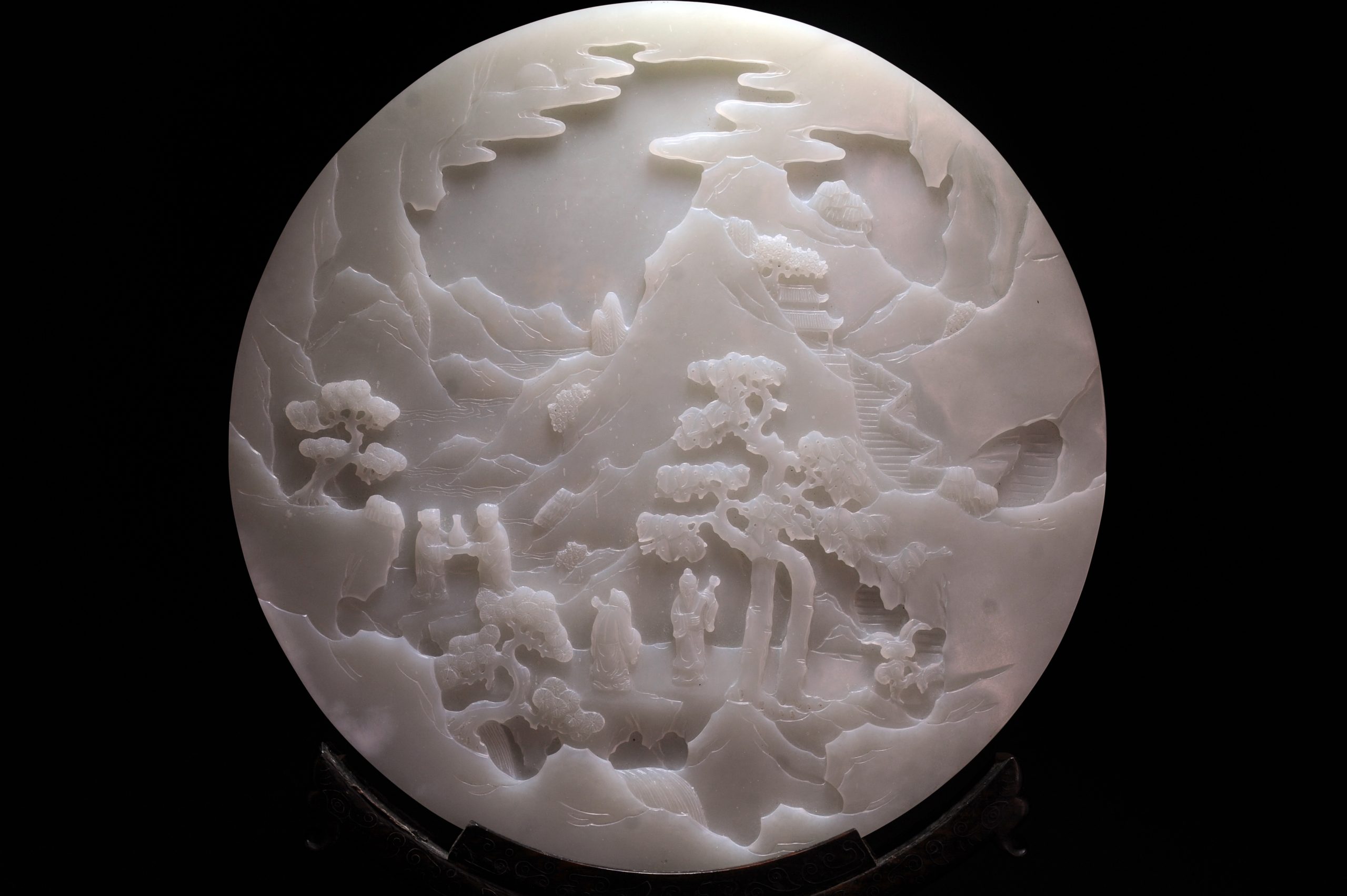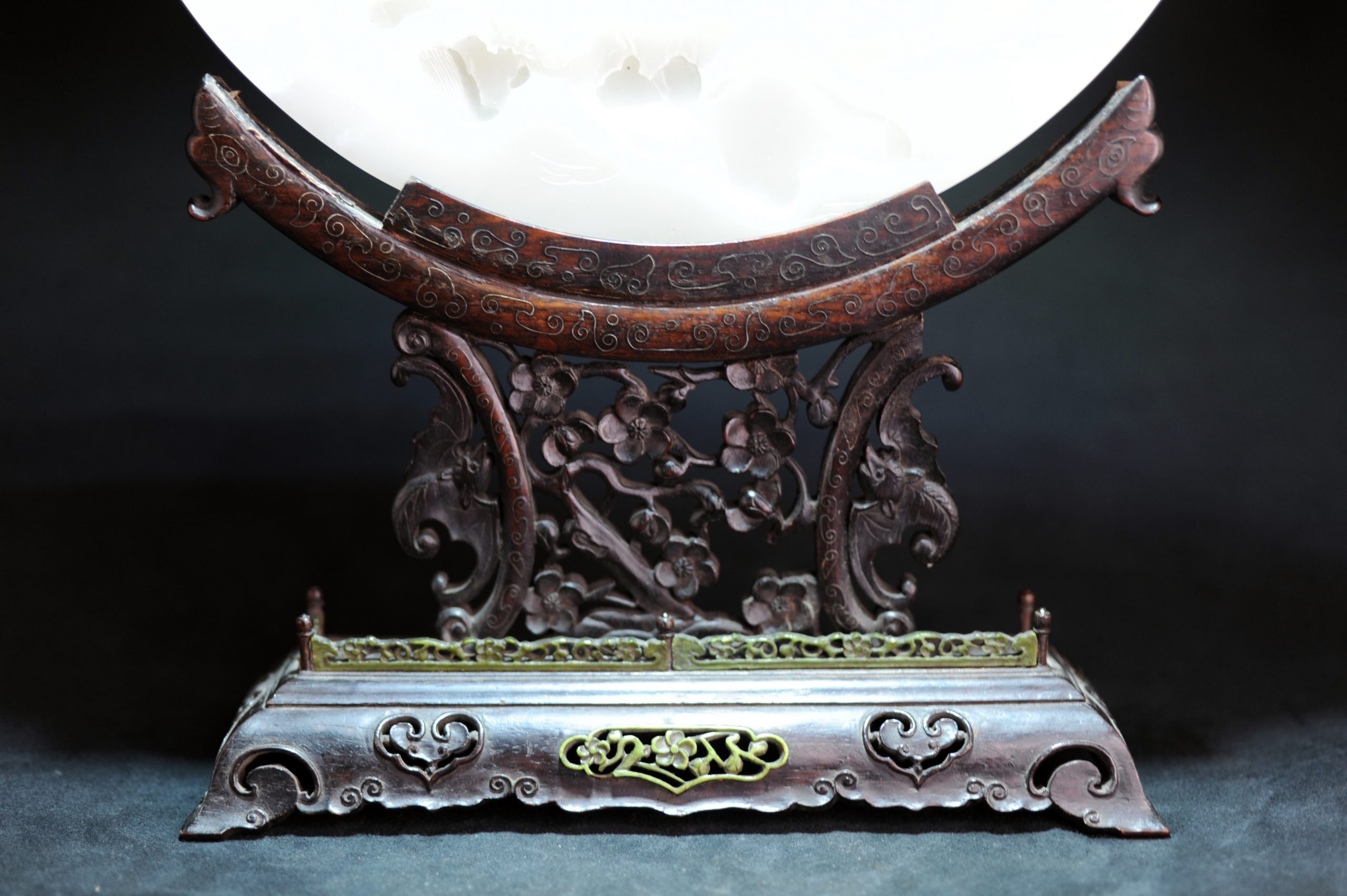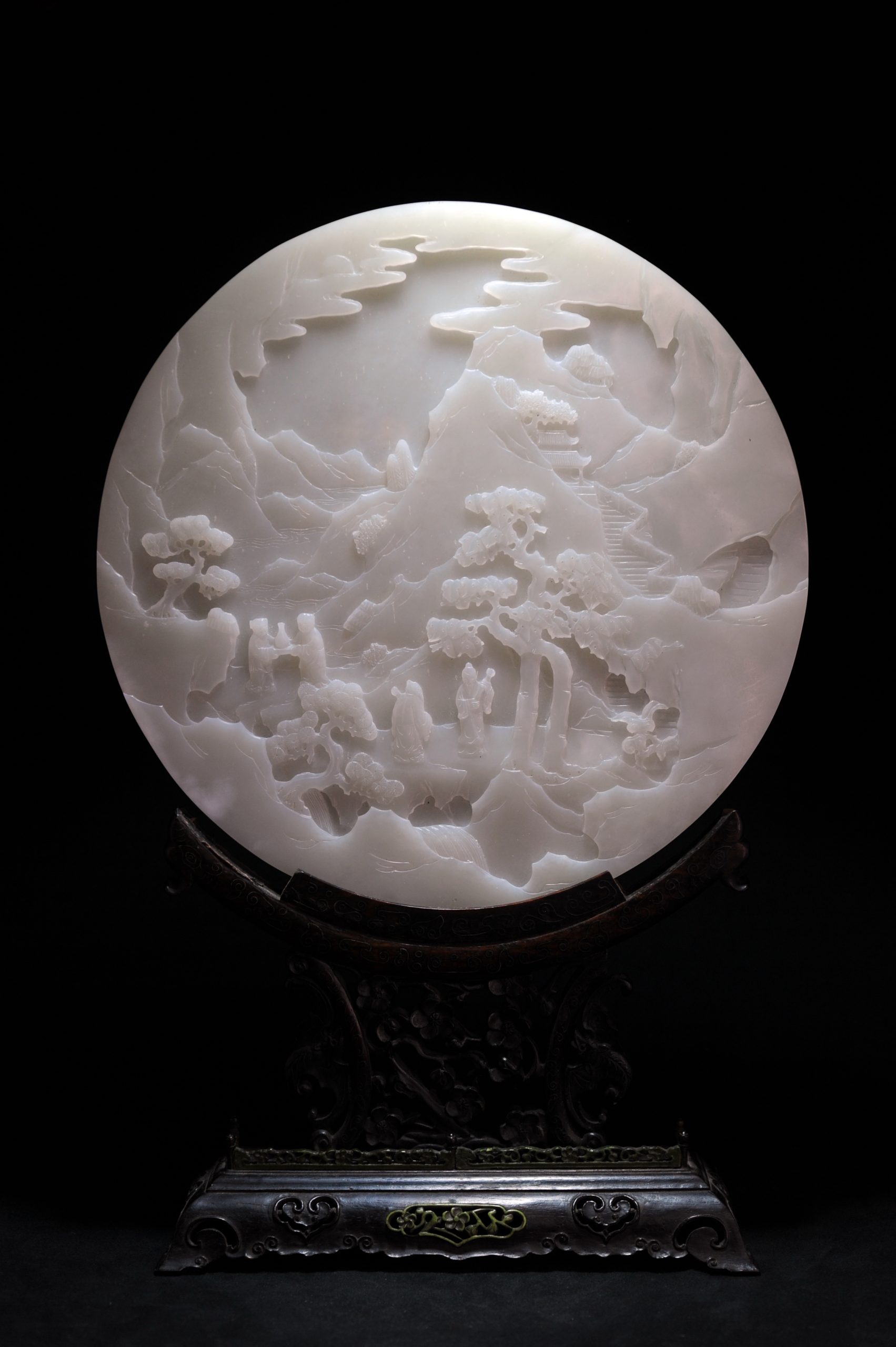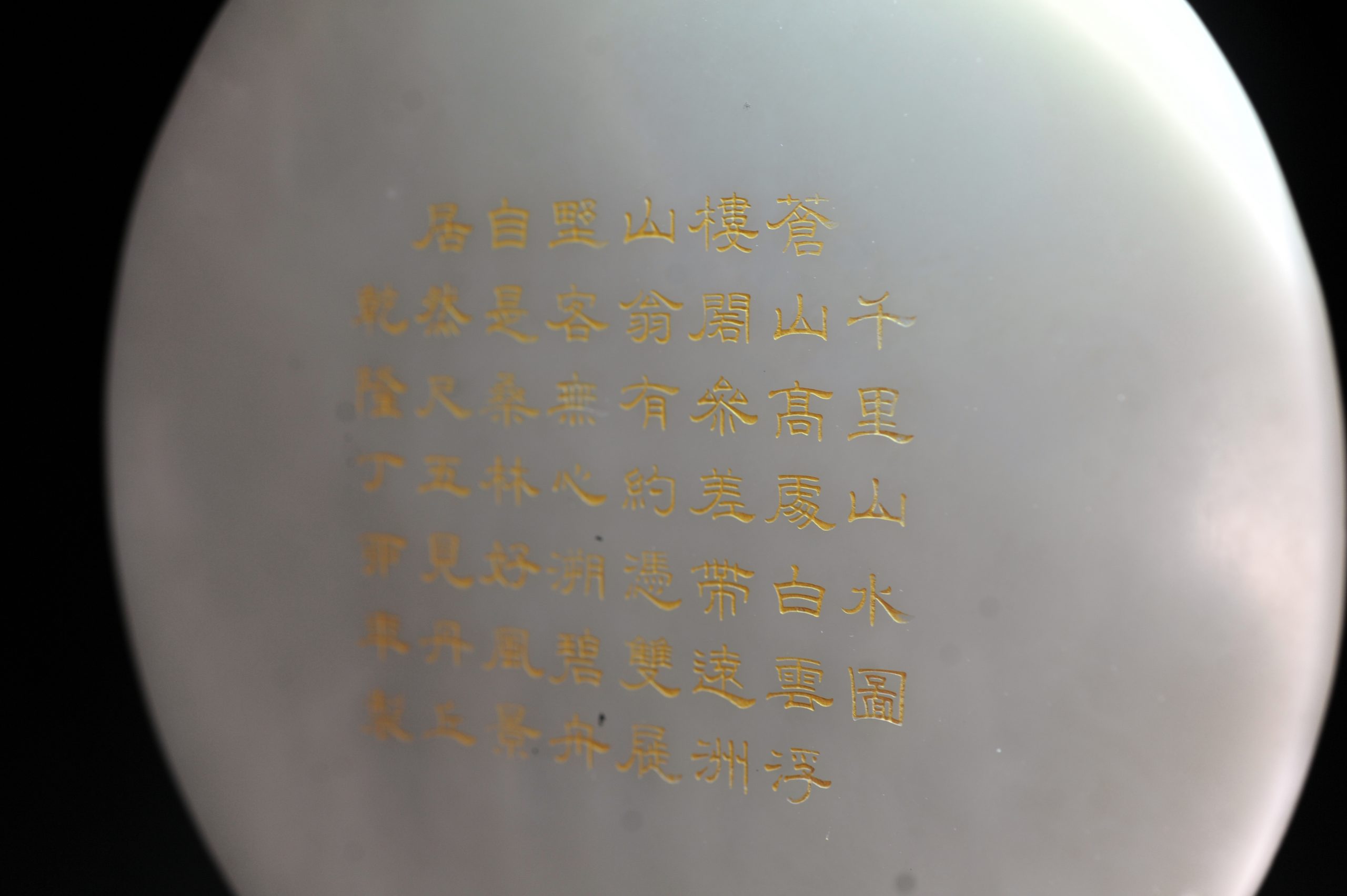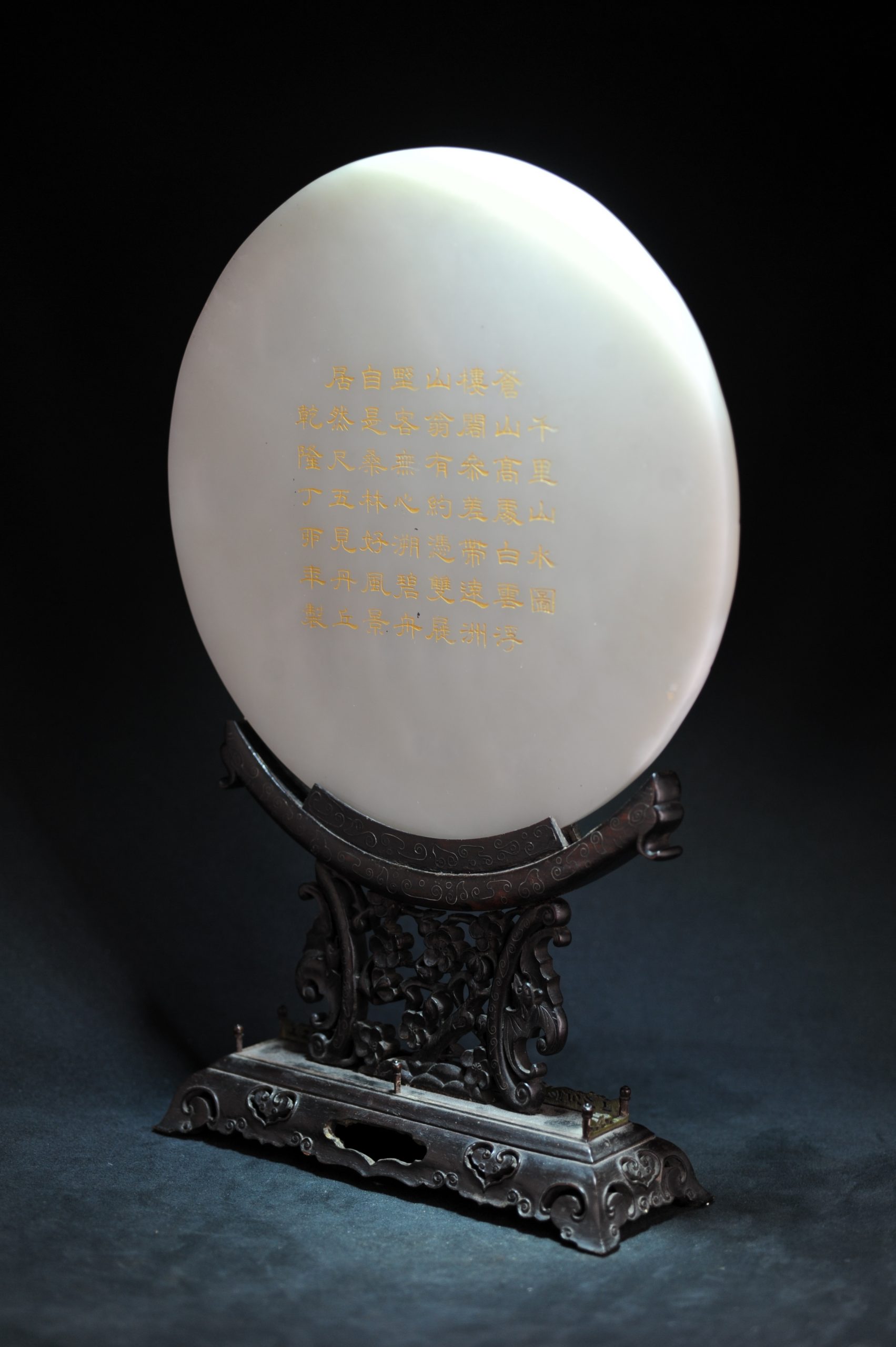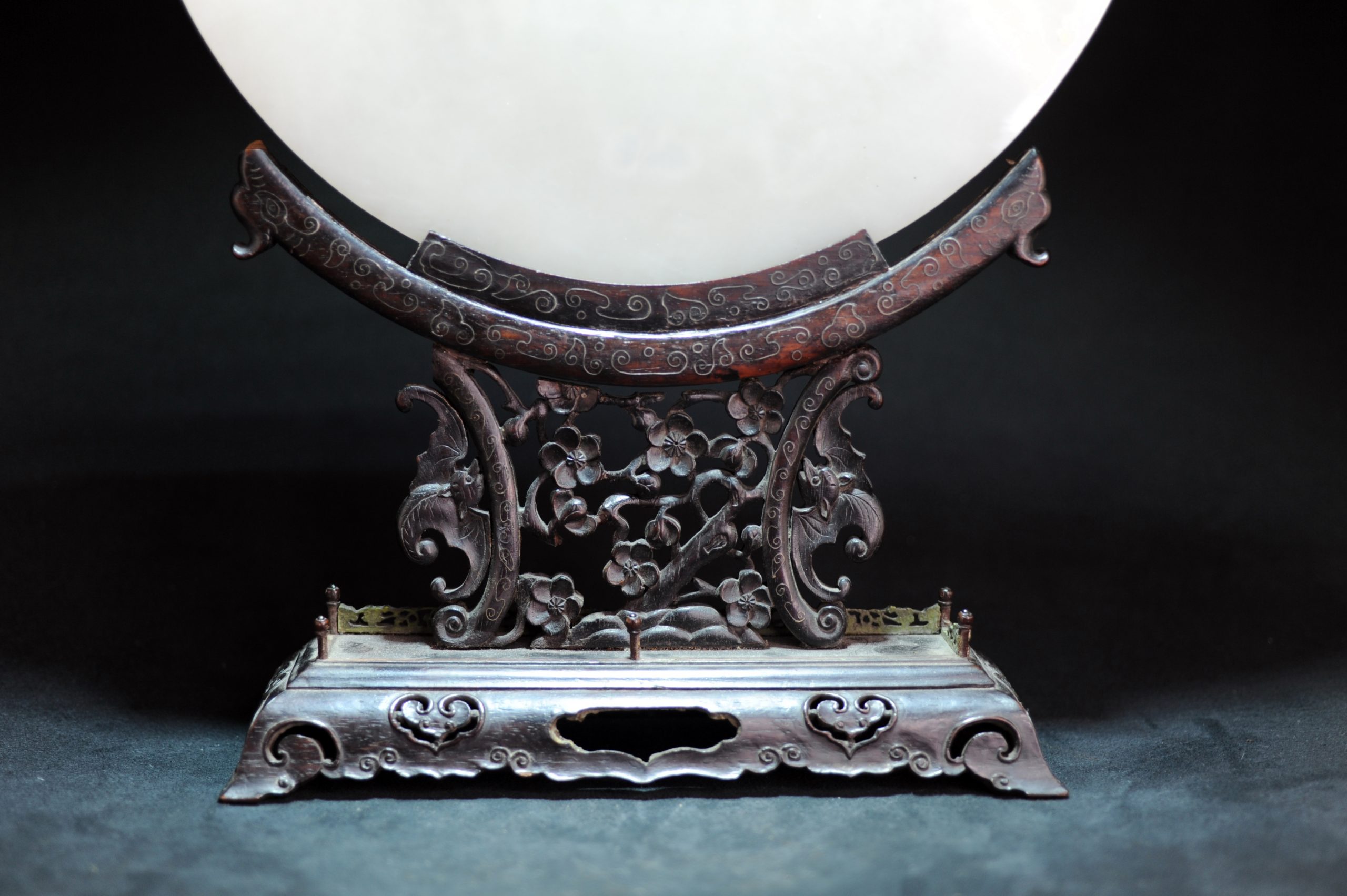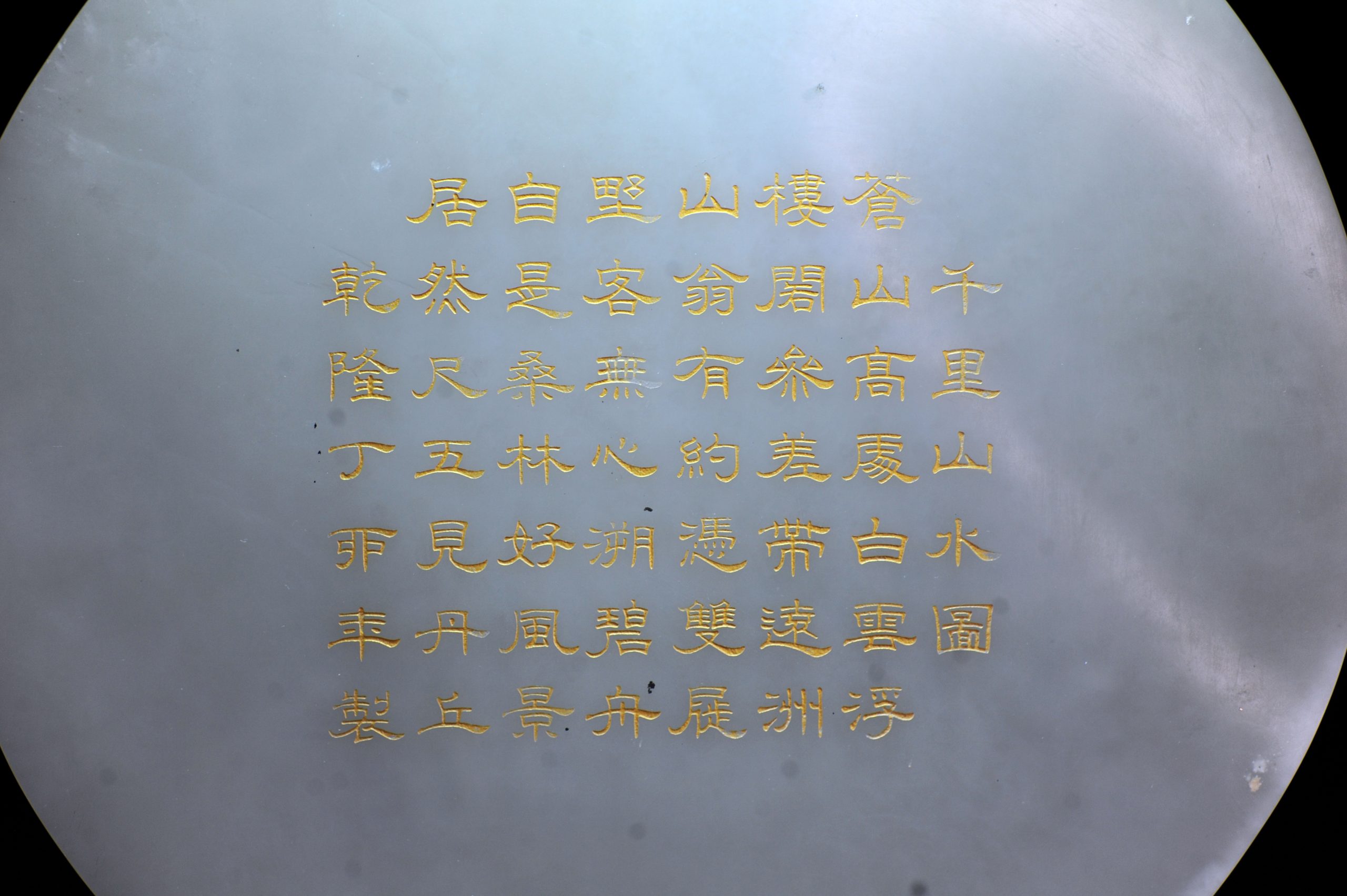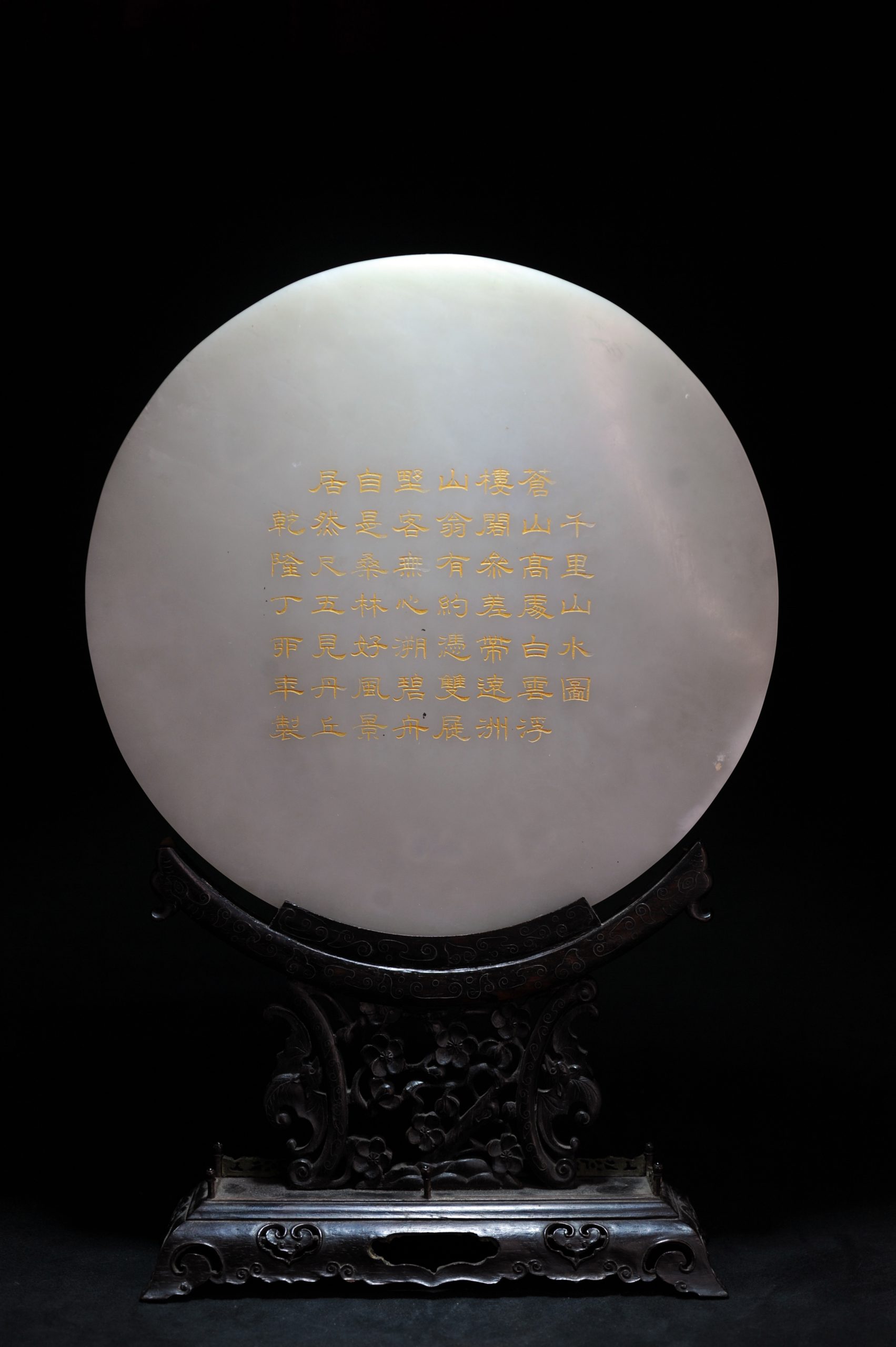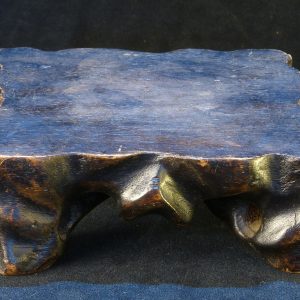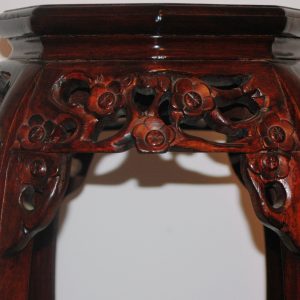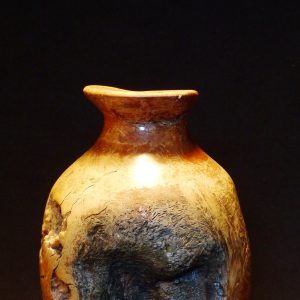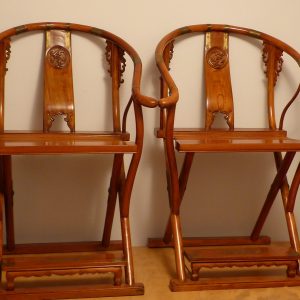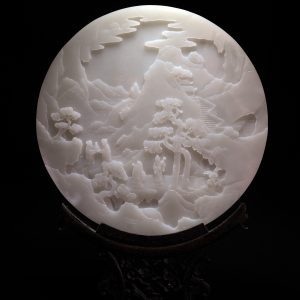Description
大清乾隆 雕山水人物诗文玉屏 (对)
阁主自评:正面浮雕风景 《深山访友图》
绝壁峭立,浮云缭绕,
高山流水,阶梯带远,
丹丘仙居,时隐时现,
虬qiú龙苍松,郁郁葱葱,
桐荫婆娑,朝阳凤鸣,
如意芭蕉,长久(酒)泰平(瓶)。
龍為四種:有鳞者称蛟龍,有翼者称为應龍,有角者称虬龙,无角者称螭龙。
两位高仕手持如意,在梧桐树下畅聊。不远处两位童子手端玉壶春酒瓶,侧立于旁,随时奉酒。
背面錾刻诗文:《千里山水圖》
蒼山高處白雲浮 樓閣參差帶遠洲
山翁有約憑雙屣 野客無心溯碧舟
自是桑林好風景 居然尺五見丹丘
乾隆丁卯年制
(乾隆十三年 1747年)
此诗源自 《赵千里山水长幅》 元 · 邓文原
苍山高处白云浮,楼阁参差带远洲。
千尺虬龙依绝壁,一群鹳鹤唳清秋。
山翁有约凭双屐,野客无心溯碧舟。
最是霜林好风景,居然咫尺见丹丘。
邓文原(公元1258年至1328年),字善之,一字匪石,人称素履先生,绵州(今四川绵阳)人,又因绵州古属巴西郡,人称邓文原为“邓巴西”。其父早年避兵入杭,遂迁寓浙江杭州,或称杭州人。历官江浙儒学提举、江南浙西道肃政廉访司事、集贤直学士兼国子监祭酒、翰林侍讲学士,卒谥文肃。其政绩卓著,为一代廉吏,其文章出众,也堪称元初文坛泰斗,《元史》有传。著述有《巴西文集》、《内制集》、《素履斋稿》等。
参考:苏富比
Important Chinese Art
22 March 2023
New York
PROPERTY FROM AN OHIO PRIVATE COLLECTION
Lot 523 A finely carved white jade ‘figural’ circular table screen, Qing dynasty, Qianlong period
清乾隆 白玉雕祝壽圖插屏
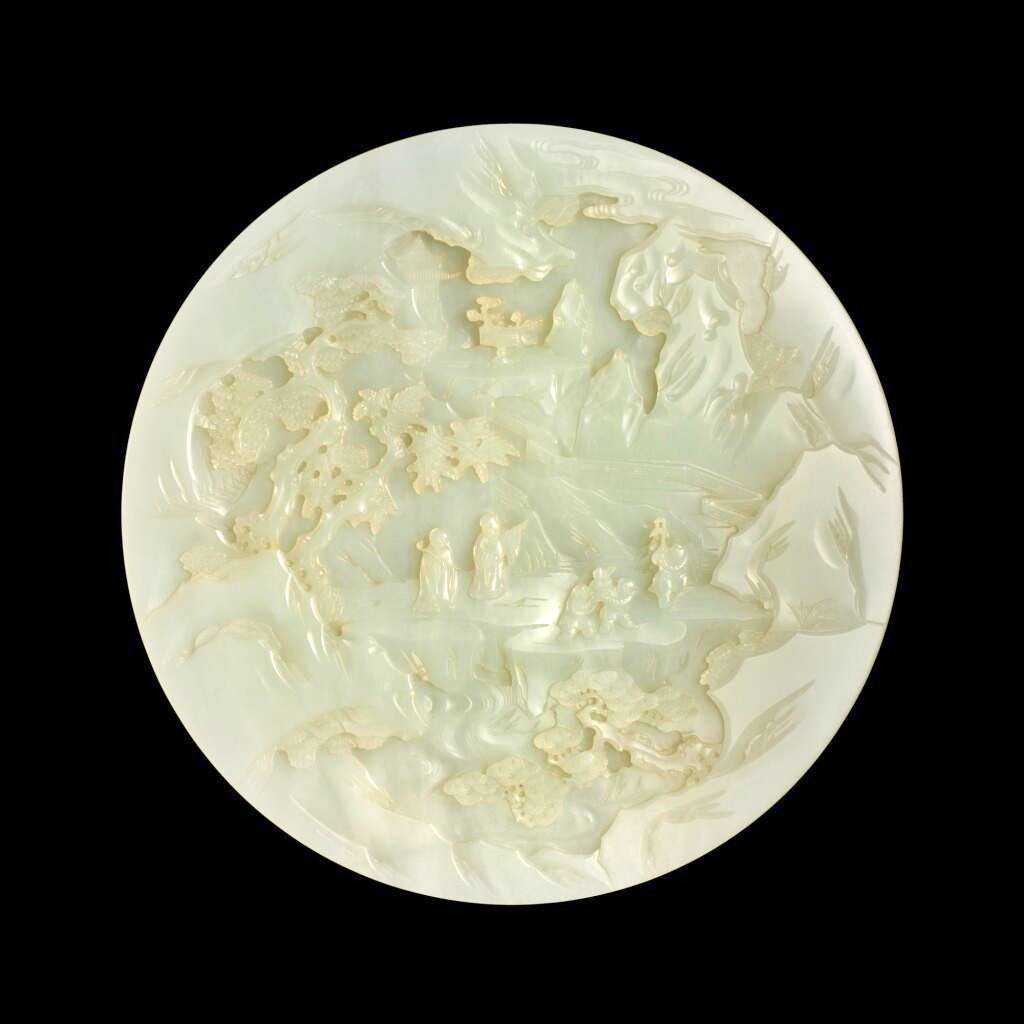
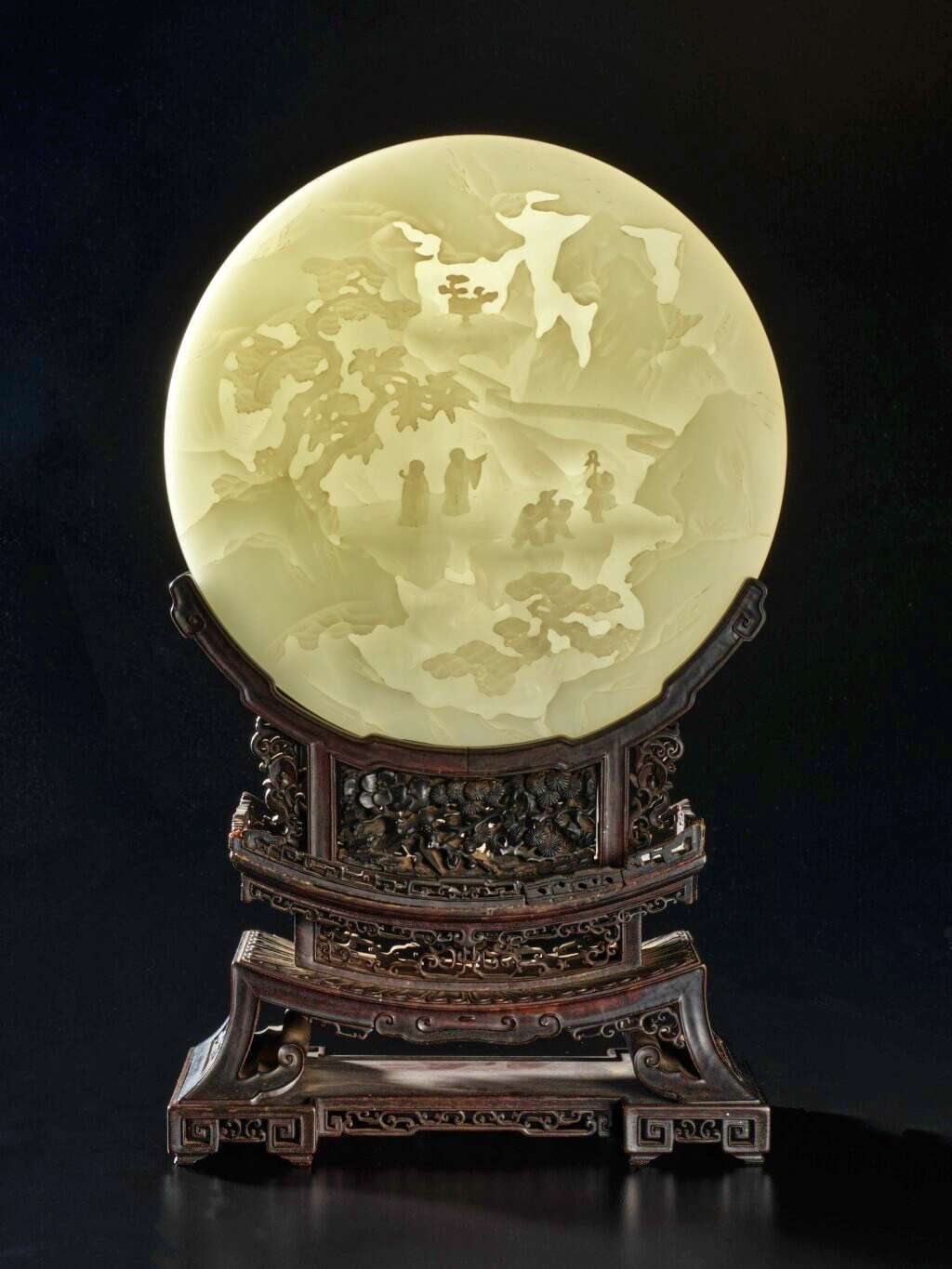
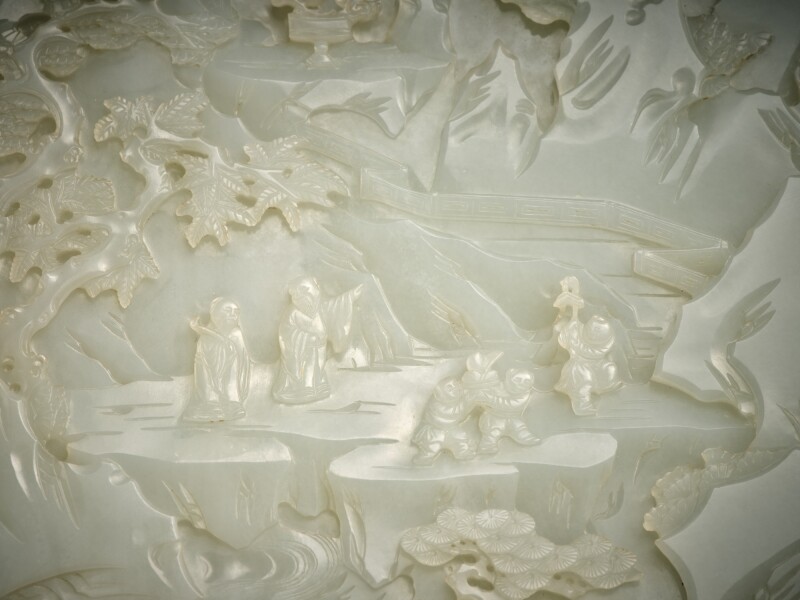
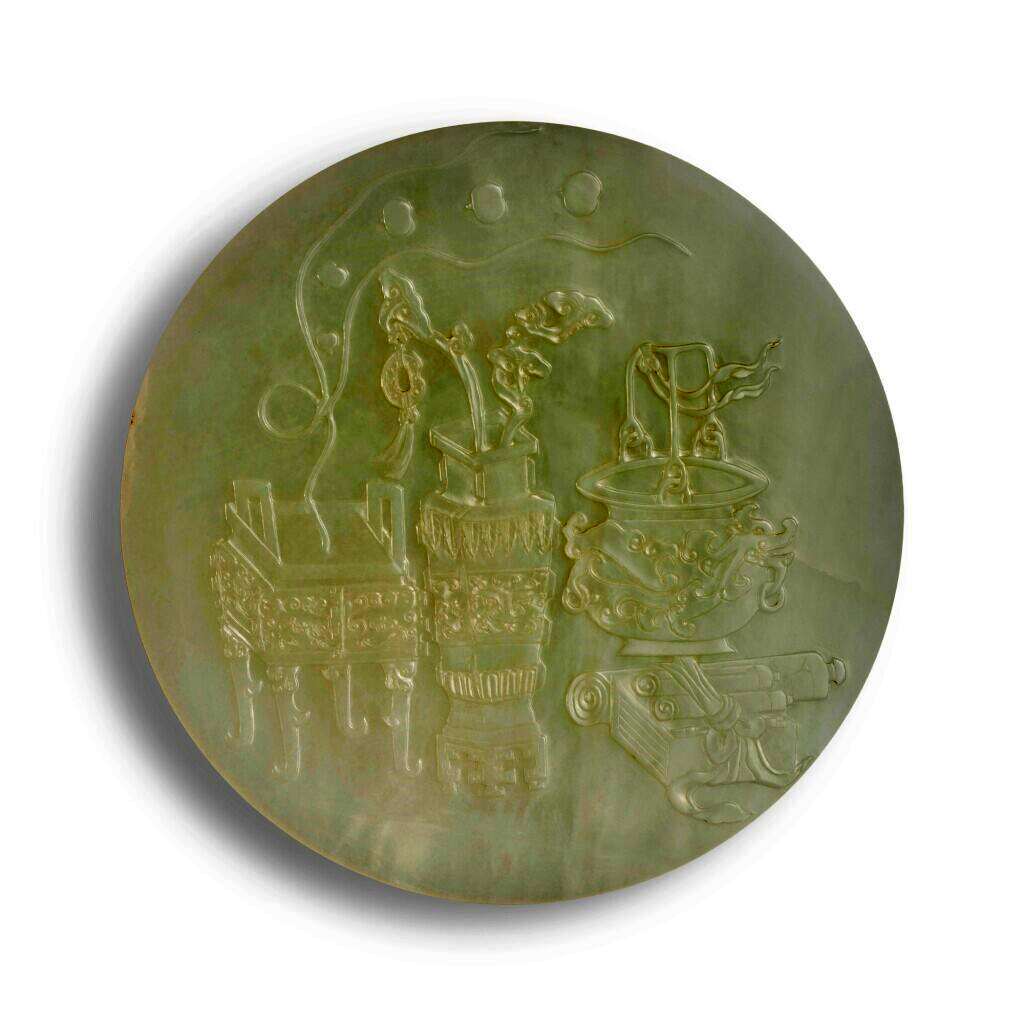
Estimate 100,000 – 150,000 USD
Lot Sold 381,000 USD
A finely carved white jade ‘figural’ circular table screen
Qing dynasty, Qianlong period
清乾隆 白玉雕祝壽圖插屏
wood stand (2)
Diameter 9½ in., 24.2 cm
Condition Report
In overall good condition with some expected minute nicks to the extremities and occasional minor natural inclusions to the stone.
整體品相良好。邊緣末端等處見些許正常微細磕痕。玉石偶見輕微天然紋理。
Provenance
Collection of Alwin Charles Ernst (1881-1948), and thence by descent.
Alwin Charles Ernst 阿尔文·恩斯特 美国安永会计师事务所 创办人(1881-1948) 收藏,此後家族傳承
Catalogue Note
With varying levels of relief expertly carved and finished to a lustrous gloss, the present screen is a superb example of jade workmanship characteristic of the type created in the Imperial Palace during the Qianlong Emperor’s reign. The skill of the carver is evident in the impeccably detailed figures and the vast ethereal landscape.
Screens such as the present piece were seldom created before the Qianlong period due to the rarity of large flawless pieces of jade. Such screens were fashioned from carefully chosen highly-translucent stones, which would enhance the differing depths of the carved pictorial scene, allowing viewers to be easily transported into the tranquil and inviting landscapes.
The Qianlong Emperor proclaimed that jade mountains and carved panels should carry the spirit of paintings by famous past masters. It is recorded that a number of classical paintings from the Emperor’s own collection was ordered to be reproduced in jade, such as the well-known painting Travelers in the Mountains, by the eminent Five Dynasties painter Guan Tong (907-960). The Gengzhi tu, a set of forty-six paintings illustrating rice and silk cultivation commissioned by the Kangxi Emperor in 1696, was also recreated and is seen carved on a pair of screens in the Seattle Art Museum, Seattle, illustrated in James C. Y. Watt, Chinese Jades from the Collection of the Seattle Art Museum, Seattle, 1989, pl. 76.
See a closely related white jade table screen and a smaller apple-green jadeite example, both previously in the Heber R. Bishop Collection, now in the Metropolitan Museum of Art, New York (accession nos 02.18.518 and 02.18.652). Compare a similarly carved white jade pair of screens of circular form in the Royal Collection Trust, illustrated in John Ayers, Chinese and Japanese Works of Art in the Collection of Her Majesty The Queen, vol. III, London, 2016, pls 1794 and 1795; a single jade screen from the De An Tang Collection was included in the exhibition A Romance of Jade from the De An Tang Collection, Palace Museum, Beijing, 2004, cat. no. 26; and a pair, one from the Fogg Art Museum, Harvard University, Cambridge, and the other from the Frederick Knight Collection, illustrated in Robert Kleiner, Chinese Jades from the Collection of Alan and Simone Hartman, Hong Kong, 1996, pl. 123, sold at Christie’s Hong Kong, 27th November 2007, lot 1511; one with a champlevé enamel and gilt-bronze stand was sold in our Hong Kong rooms, 11th July 2020, lot 3663; and lastly, a spinach-green jade example from the Florence and Herbert Irving Collection, sold at Christie’s New York, 19th March 2019, lot 821.

ALWIN CHARLES ERNST (1881-1948)
Born in Cleveland, Ohio, Alwin Charles (A.C.) Ernst (1881-1948) was an American businessman best known for co-founding Ernst & Ernst, the forerunner of Ernst & Young accounting firm. Credited with pioneering the idea that accounting information could be used to advise business decisions, Ernst was also the first to introduce management consulting. Apart from several government appointments, he was also chosen in 1924 by the postmaster general and approved by President Calvin Coolidge to investigate the methods and costs of the United States Post Office. Noted as one of Cleveland’s most charitable and philanthropic citizens, Ernst was a prominent and active member of the Cleveland area arts and civic organizations. He was a trustee and one of the founders and incorporators of the Cleveland Museum of Natural History, a trustee of the College of Wooster and Hathaway Brown School, and of the Cleveland Protestant Orphan Asylum. Ernst also served on committees of the McKinley National Memorial Association, Cleveland Symphony Orchestra, Cleveland Museum of Art, and the Northern Ohio Opera Association.
参考:嘉德2018 春季拍賣
玉質金相──中國古代玉器藝術珍品
618
白玉山水花鳥人物紋插屏一對
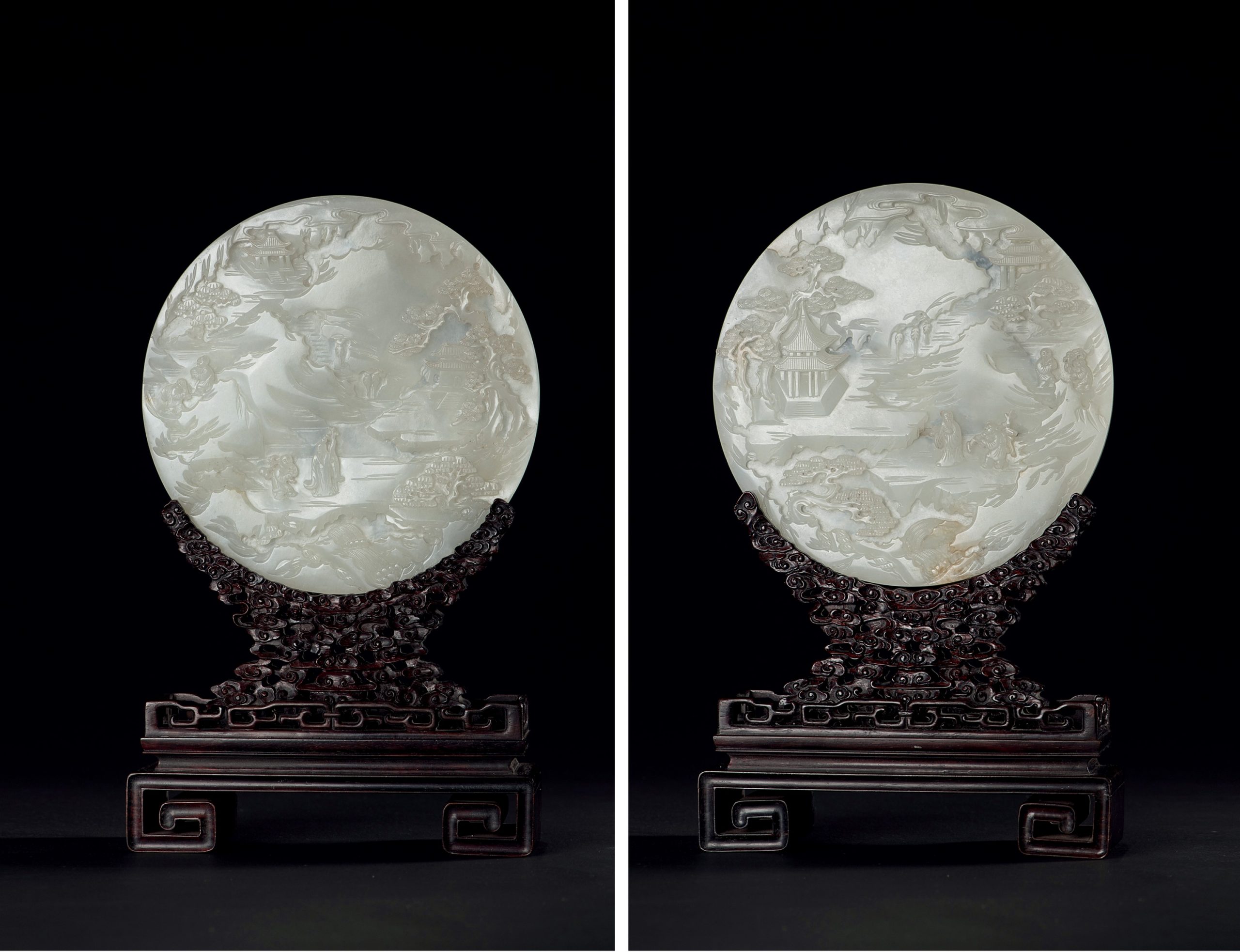
With Stand, 28.5 cm. (11 1⁄4 in.) high
屏風以白玉製成, 圓形片狀, 兩面均有雕刻。一面屏風上浮雕山水人物, 近景為松柏崖石, 水流湍湍, 中景為童子伴一高士, 二人作互語之狀, 其前方為高臺亭榭, 松樹參天, 遠景則是山徑蜿蜒, 迭嶂遠去, 天山一色, 有深山樓闕, 雲霧繚繞。作品視野寬闊, 造景深遠。另一面屏風在內容與形式上與第一面相似, 營造出幽深的山林意境。兩面屏風的背面均雕刻花鳥樹石的場景。因系雙面雕刻, 玉料最薄處呈現透明狀, 這些部位恰好與所雕刻景致相合, 如作於流水、雲天, 薄料透而閃藍, 極具偶然天成之效果, 實為工匠巧思巧做, 令人欽嘆。
兩屏風以減地深挖的手法, 多層塑造, 景色較遠雕刻越淺, 近景以高浮雕表現, 在有限厚度的玉材上琢磨出豐富的藝術層次。圖案構圖疏密得當, 情景交融, 雖為刀刻, 卻與水墨繪畫無異, 皴、寫具有, 獨具神韻與氣象。屏風下所承紫檀座, 被雕刻成雲氣升騰的效果, 更烘托屏風之上作山水隱居的神秘氣氛, 使作品達到藝、技俱佳的高度。
估價 :HKD: 280, 000-320, 000
USD: 35, 900-41, 000
参考:嘉德国际
2021 秋季拍賣
觀古 II — 玉器金石文房藝術
1237 清中期 白玉山水人物圖插屏
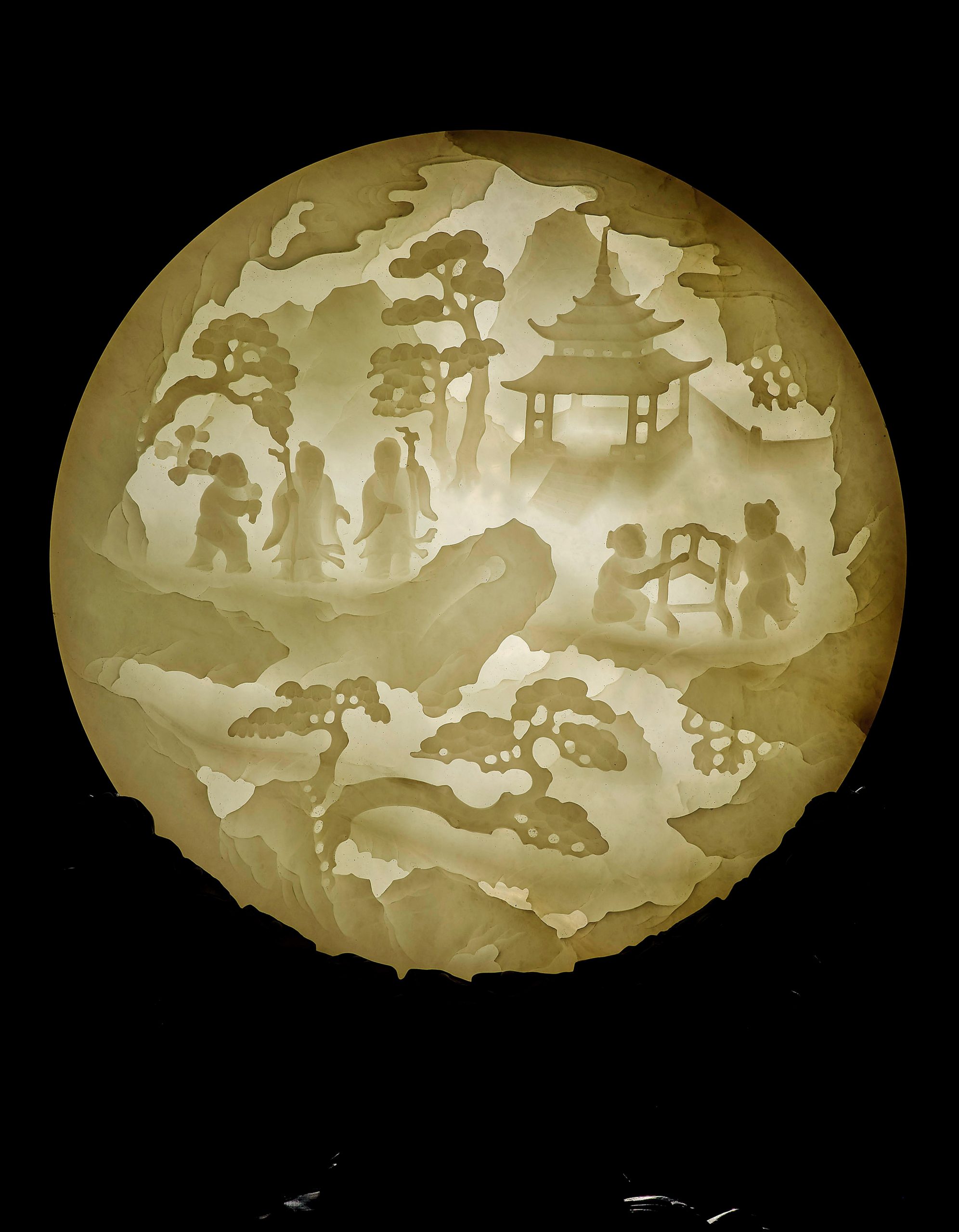
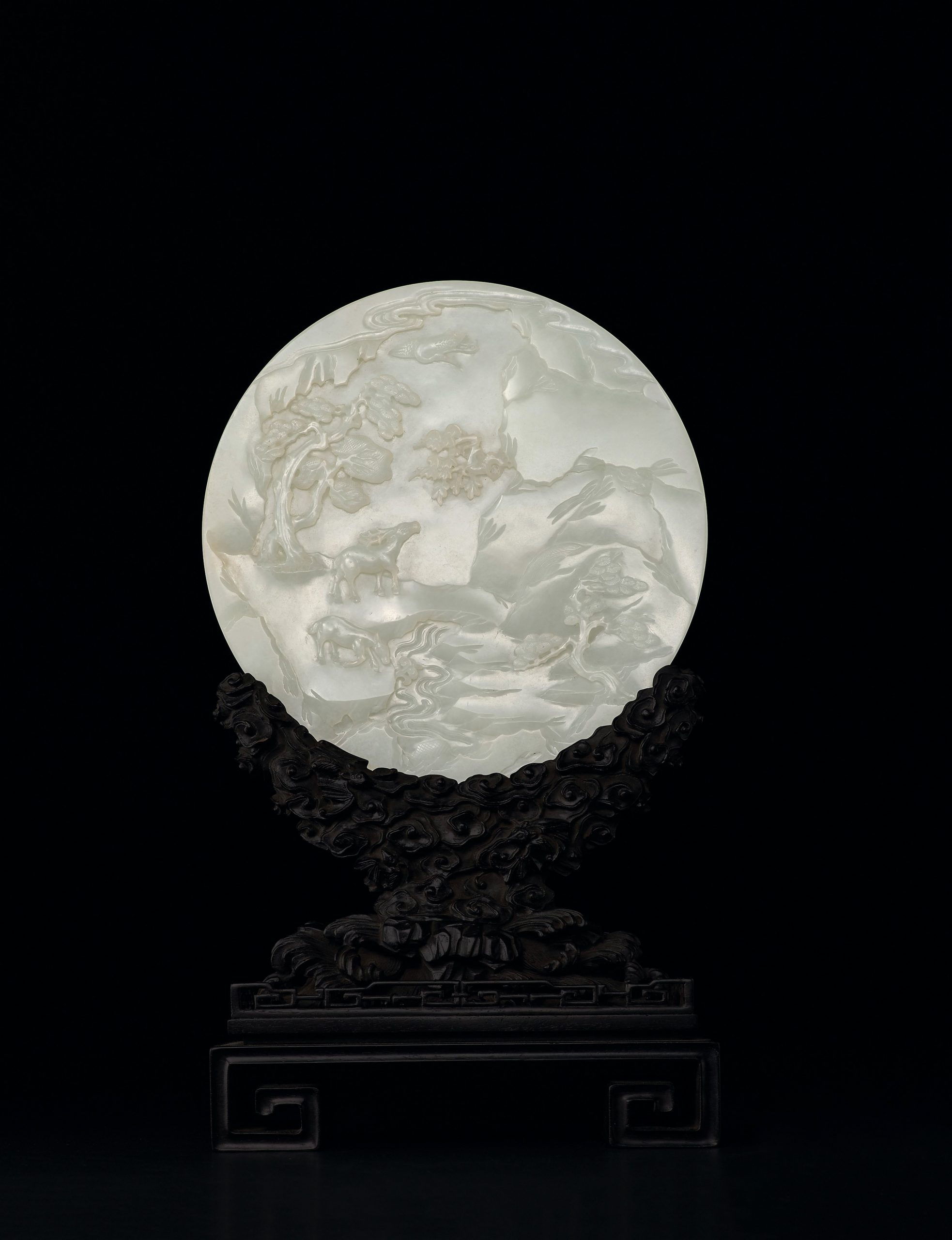
20.3 cm. (8 in.) diam.
屏作圓形,以白玉製成,玉質潤而膩,色澤純而雅。通身雕工精湛,山勢重迭,峰巒起伏,古松挺拔,松幹蜿蜒,生機盎然。松下有三位高士,兩個侍童在一旁玩耍。人物刻畫栩栩如生,松柏層次分明。整幅畫面內容豐滿,層次分明,於方寸之間展現出豐富景深,線條清晰俐落,工藝細緻生動,刀法細勁遒婉,頗有意境。下配紅木托座,紋飾精美,與插屏相得益彰,無不彰顯清新古雅與雍容華貴融合的時代特徵。插屏為清代重要的宮廷陳設品,既可當做文房用具,又可陳設。中國的傳統文人,一直有一種超然物外、寄身心于山水的隱士情結,此類插屏置於案頭,憑以釋懷,悅人心目,深合中國傳統文化。
來源:Pedro de Seoane Diana(1901-1988)舊藏,西班牙馬德里, 而後家族流傳至今
估價 : HKD: 450,000 – 550,000 USD: 57,800 – 70,700
成交價: HKD: —
参考:苏富比
September 20, 2023
PROPERTY FROM A DISTINGUISHED PRIVATE COLLECTION
Lot 615 A pair of carved white jade ‘immortals’ table screens, Qing dynasty, Qianlong period
清乾隆 白玉群仙賀壽圖插屏一對
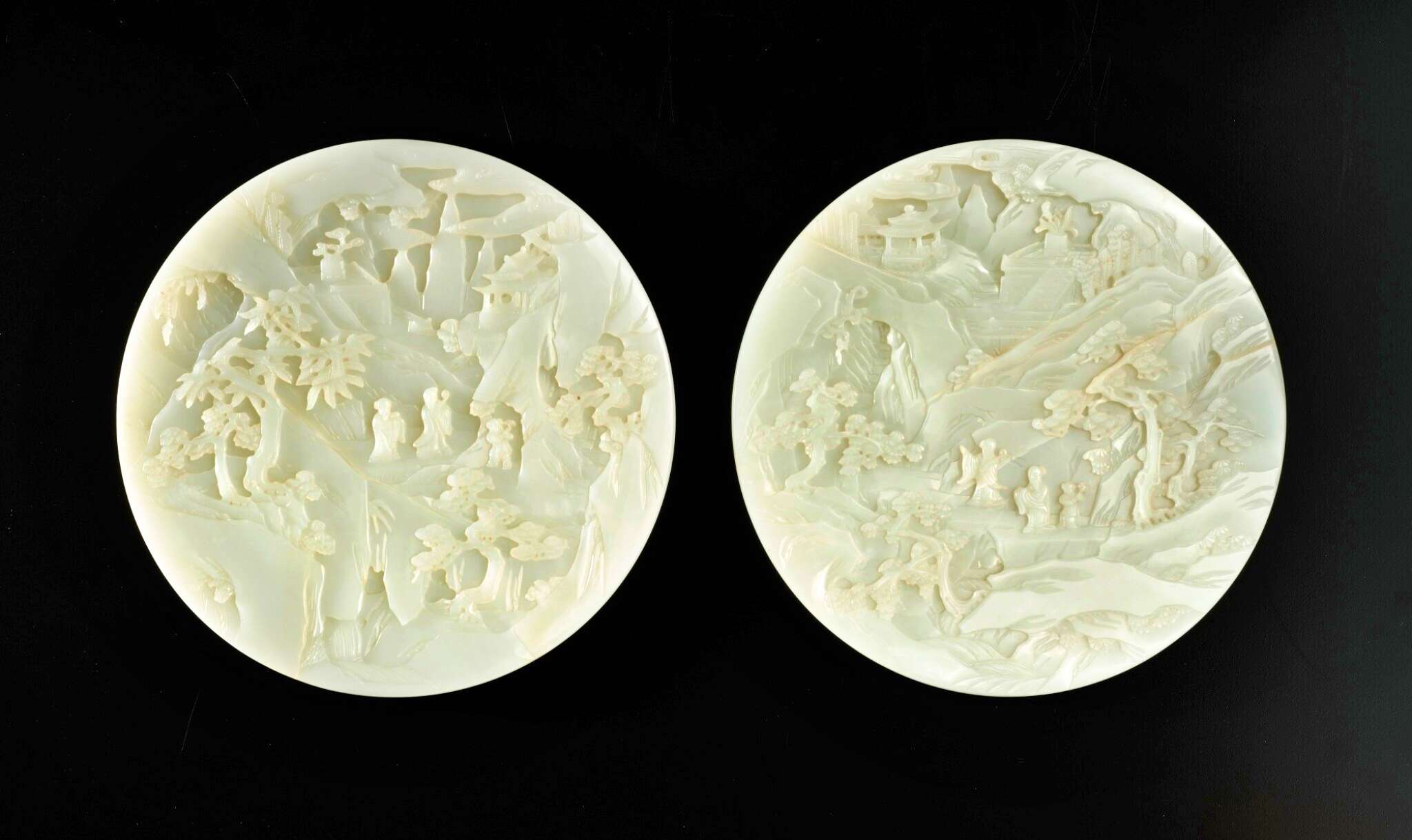
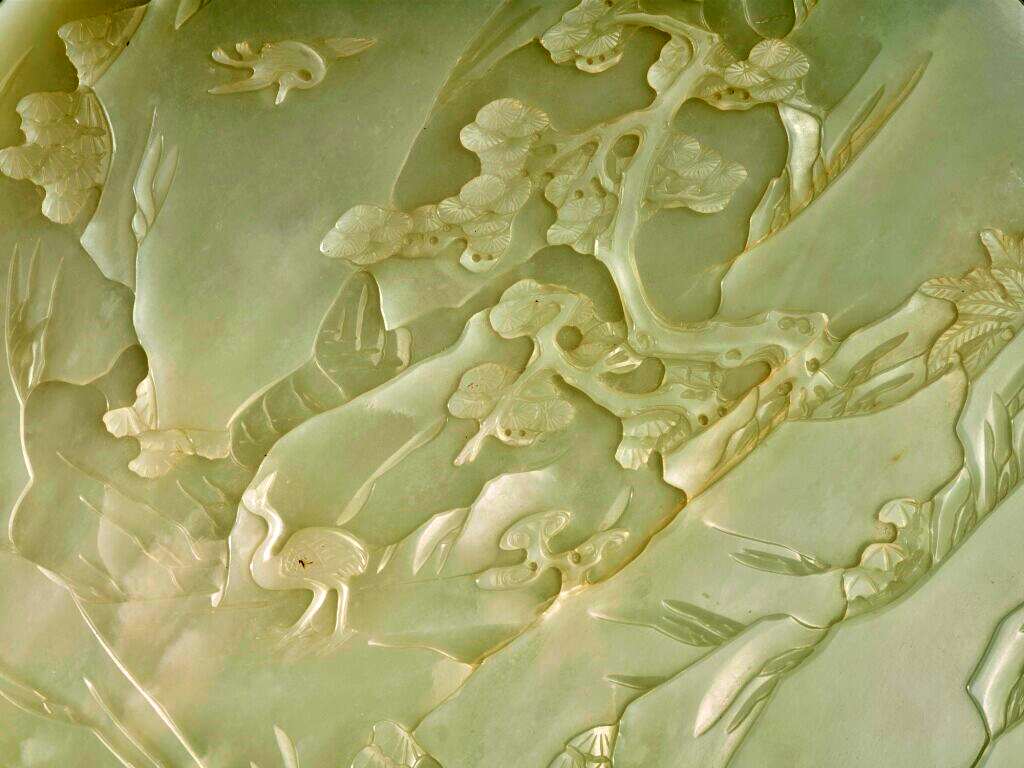
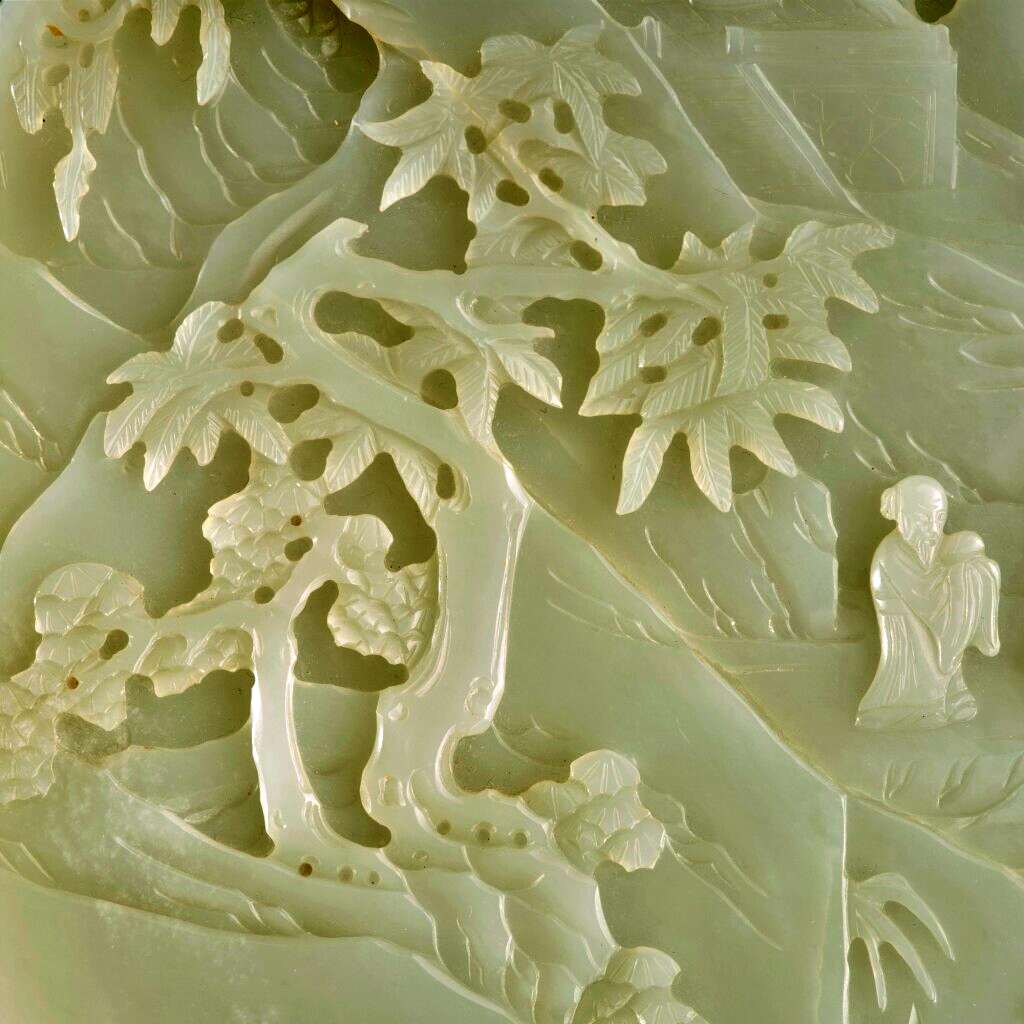
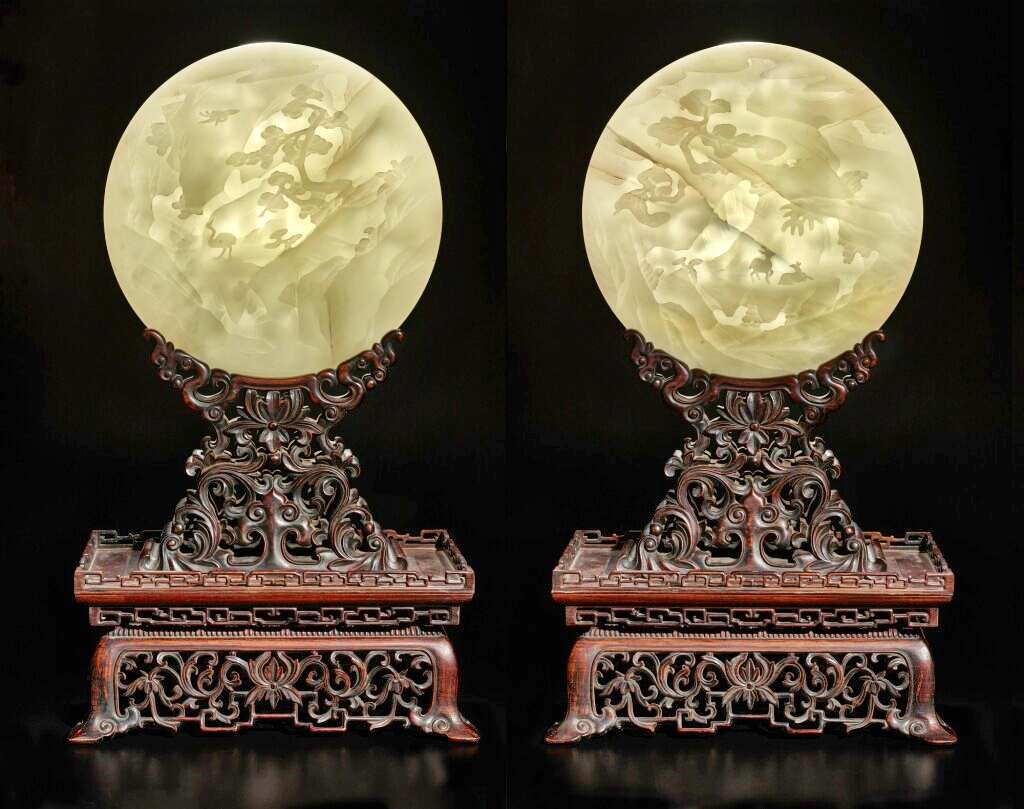
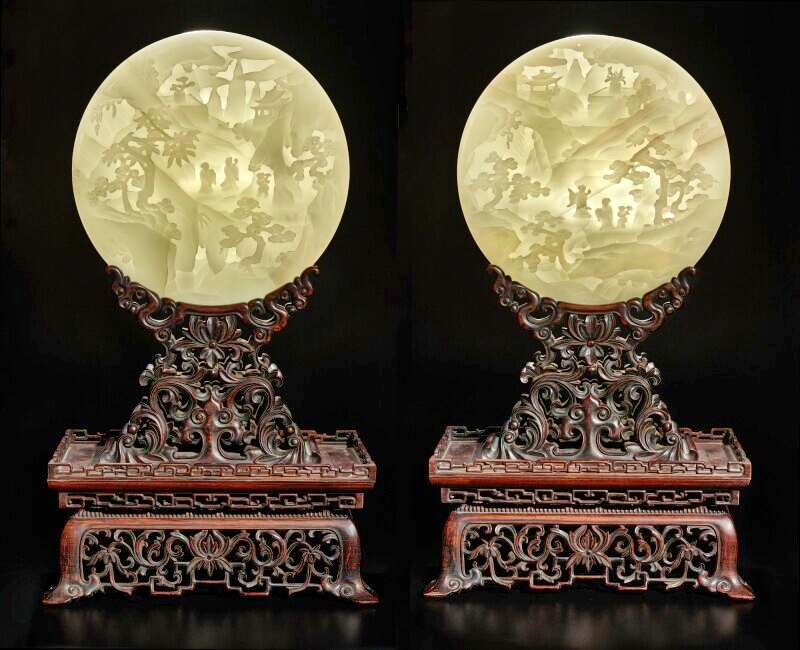
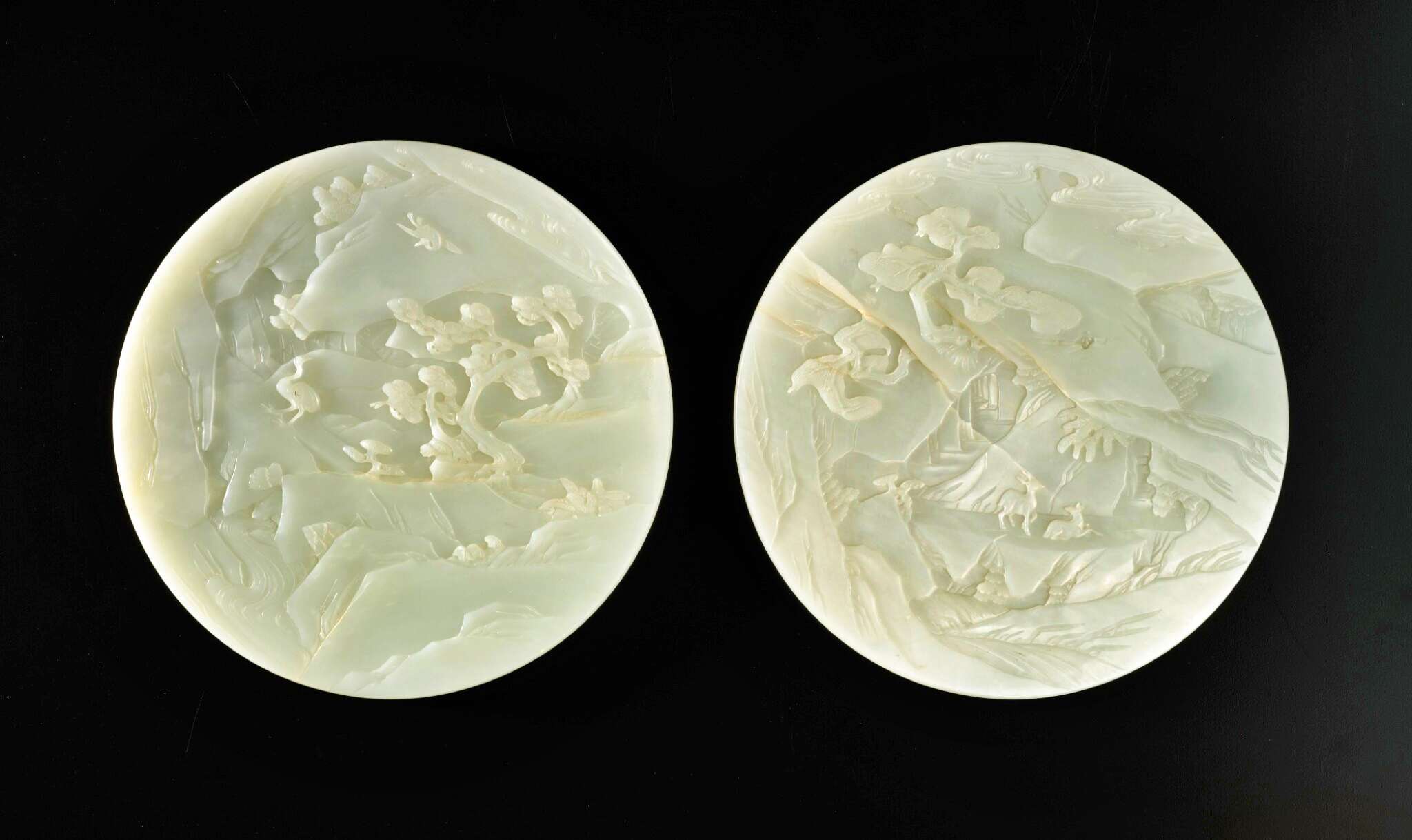
Estimate 400,000 – 600,000 USD
A pair of carved white jade ‘immortals’ table screens
Qing dynasty, Qianlong period
清乾隆 白玉群仙賀壽圖插屏一對
wood stands (4)
Diameter 9½ in., 24 cm
Condition Report
Both are in overall good condition with some expected minor nicks and losses to the extremities, including to the tip of a pine tree branch and tips of the floral leaves issuing from the planter on one plaque. The stone with occasional minor natural fissures. One stand is later made.
一對整體品相良好,邊緣等處見些許正常輕微磕痕及微缺,包括其一一側松枝末梢處及露台花盆花葉末梢處。玉石偶見輕微天然紋理。一底座為後配。
Provenance
One:
Collection of Dr. Gordon (1922-2008) and Dr. Rosemary (1922-1994) Fryers.
Christie’s London, 15th May 2012, lot 10.
The other:
Collection of Charles St. George Cleverly (1819-1897).
Christie’s Hong Kong, 26th November 2014, lot 3354.
其一插屏:
Gordon醫生 (1922-2008) 及 Rosemary醫生 (1922-1994) Fryers伉儷收藏
倫敦佳士得2012年5月15日,編號10
其二:
Charles St. George Cleverly (1819-1897) 私人收藏
香港佳士得2014年11月26日,編號3354
Catalogue Note
Expertly carved on both sides with varying levels of relief and finished to a lustrous gloss, the present pair of screens is a superb example of jade workmanship and characteristic of the type created in the Imperial Palace during the Qianlong Emperor’s reign. The skill of the carver is evident in the fine rendering of the impeccably detailed figures and the vast ethereal landscape.
Screens such as the present pair were seldom created before the Qianlong period due to the rarity of large flawless pieces of jade. Such screens were fashioned from carefully chosen highly-translucent stones, which would enhance the differing depths of the carved pictorial scene, allowing viewers to be easily transported into the tranquil and inviting landscapes.
Remarkably, the pair of screens were cut from the same stone and depict a similar, almost continuous, narrative of two immortals and one attendant traveling amidst the jagged mountainous landscape. As the viewer’s eye follows along the winding path, one embarks on the same journey as the trio, eventually reaching the pavilion at the top of the mountain, signaling the final destination of the journey. On the reverse, the panels are beautifully carved with auspicious animals, one with a pair of deer and the other with a pair of cranes, both emblematic of longevity and set with mountainous terrain.
Compare a similarly carved white jade table screen, previously in the Heber R. Bishop Collection, now in the Metropolitan Museum of Art, New York (accession no. 02.18.652); one from the De An Tang Collection was included in the exhibition A Romance of Jade from the De An Tang Collection, Palace Museum, Beijing, 2004, cat. no. 26; a pair, one from the Fogg Art Museum, Harvard University, Cambridge, and the other from the Frederick Knight Collection, illustrated in Robert Kleiner, Chinese Jades from the Collection of Alan and Simone Hartman, Hong Kong, 1996, pl. 123, sold at Christie’s Hong Kong, 27th November 2007, lot 1511; a spinach-green jade example from the Florence and Herbert Irving Collection, sold at Christie’s New York, 19th March 2019, lot 821; and lastly, a white jade example, previously in the collection of Alwin Charles Ernst, sold in these room, 22nd March 2023, lot 523.
此對白玉插屏雙面滿雕,層次分明,瑩澤秀潤,乃琢玉成器之佳作、乾隆御製之典型。人物刻畫一絲不苟,圖景塑造流麗輕靈,頗見藝匠巧工。
乾隆之前鮮有此類玉插屏,因無暇美玉珍罕難求。雕琢玉屏需精選籽料,質地透潤、成色瑩潔,畫面層次方可躍然眼前,注目觀賞方得心往神馳。
此對插屏出於同一籽料,屏上畫面連貫一致,乃兩位仙翁及一侍童遊於嶙峋山石間。凝神細看,目光隨山路蜿蜒而上,終至峰頂亭台,如與屏中三人同行。背面精雕祥禽瑞獸,一屏有鹿成對,一屏有鶴成雙,同現山巒,祝頌鹿鶴同春。
比一白玉插屏近例,Heber R. Bishop 舊藏,現存於紐約大都會博物館(編號02.18.652);另一德安堂雅藏插屏曾展於《玉緣——德安堂藏玉》,故宮博物院,北京,2004年,編號26;再比哈特曼伉儷所藏白玉插屏一對,其一原屬哈佛大學福格博物館,劍橋,另一則為Frederick Knight寶蓄,錄 Robert Kleiner,《Chinese Jades from the Collection of Alan and Simone Hartman》,香港,1996年,圖版123,售於香港佳士得2007年11月27日,編號1511;另比一歐雲伉儷收藏碧玉例,售於紐約佳士得2019年3月19日,編號821;及一白玉例,Alwin Charles Ernst 舊藏,售於紐約蘇富比2023年3月22日,編號523。
参考:倫敦蘇富比
Important Chinese Art
1 November 2023•10:00 GMT
London
PROPERTY FROM AN ASIAN PRIVATE COLLECTION | 亞洲私人收藏
A finely carved imperial white jade ‘figural’ table screen, Qing dynasty, Qianlong period
清乾隆 御製白玉雕松鶴祝壽圖圓硯屏
VAT reduced rate
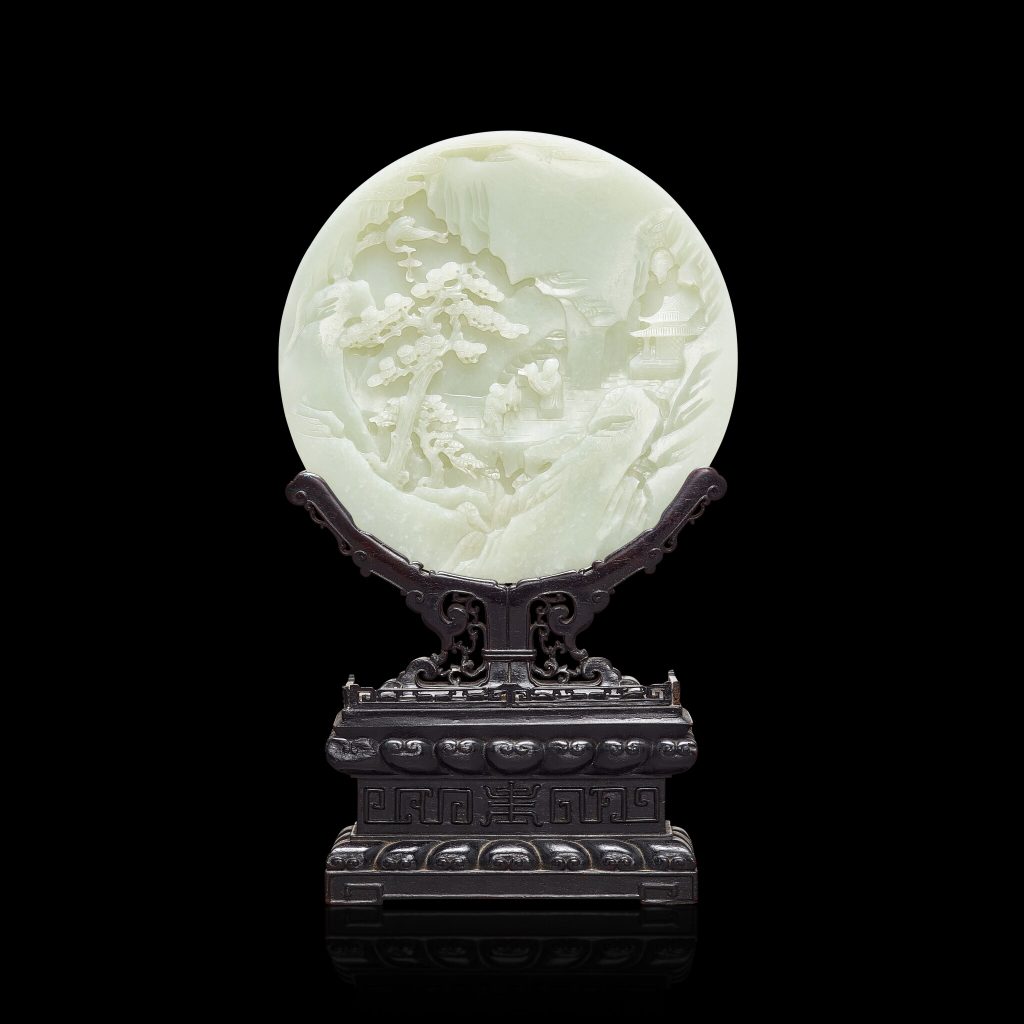
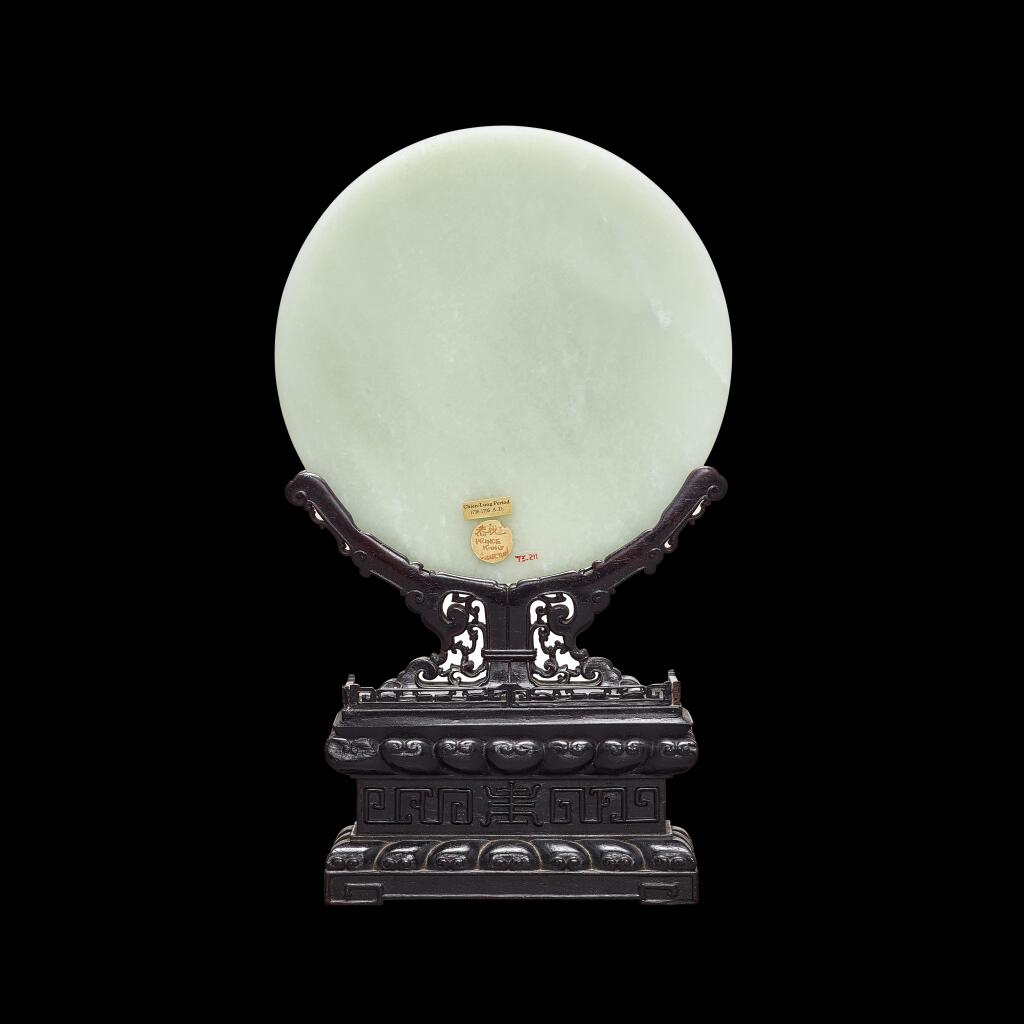
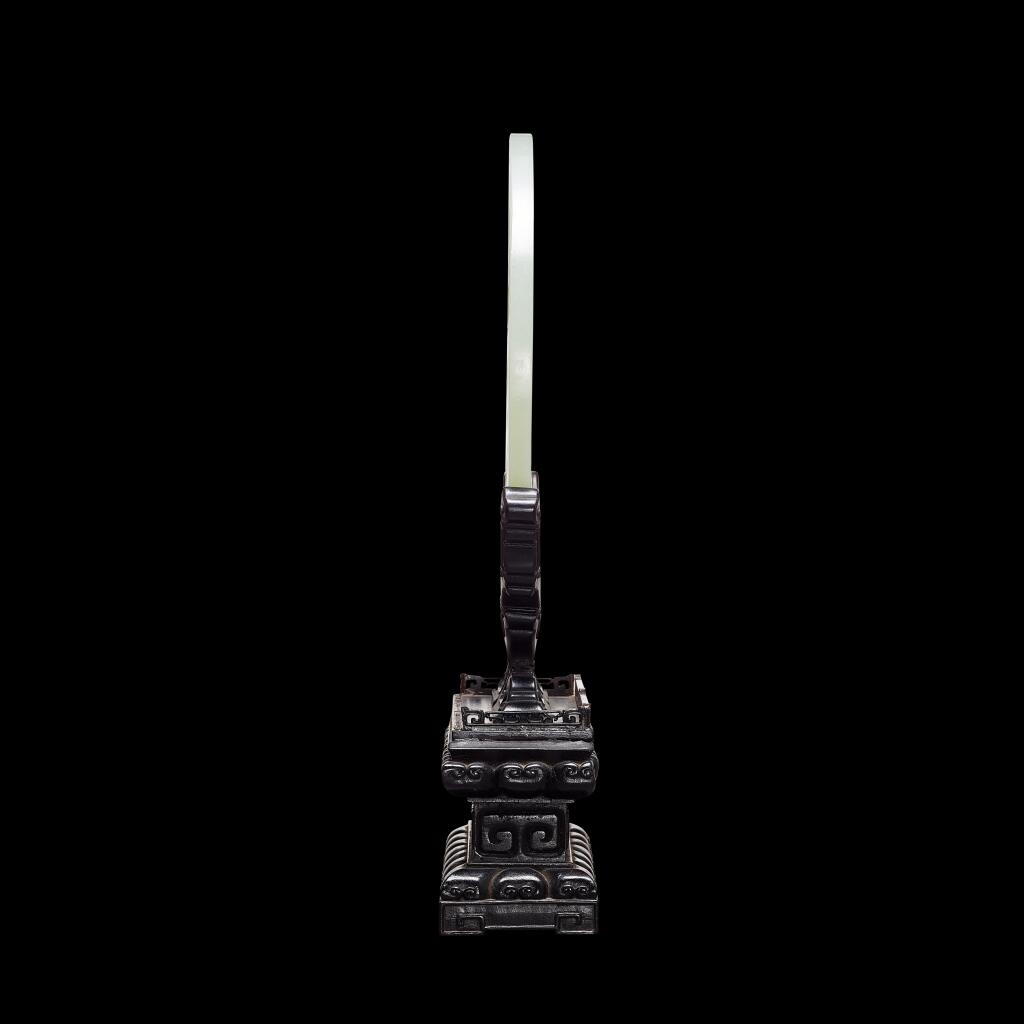
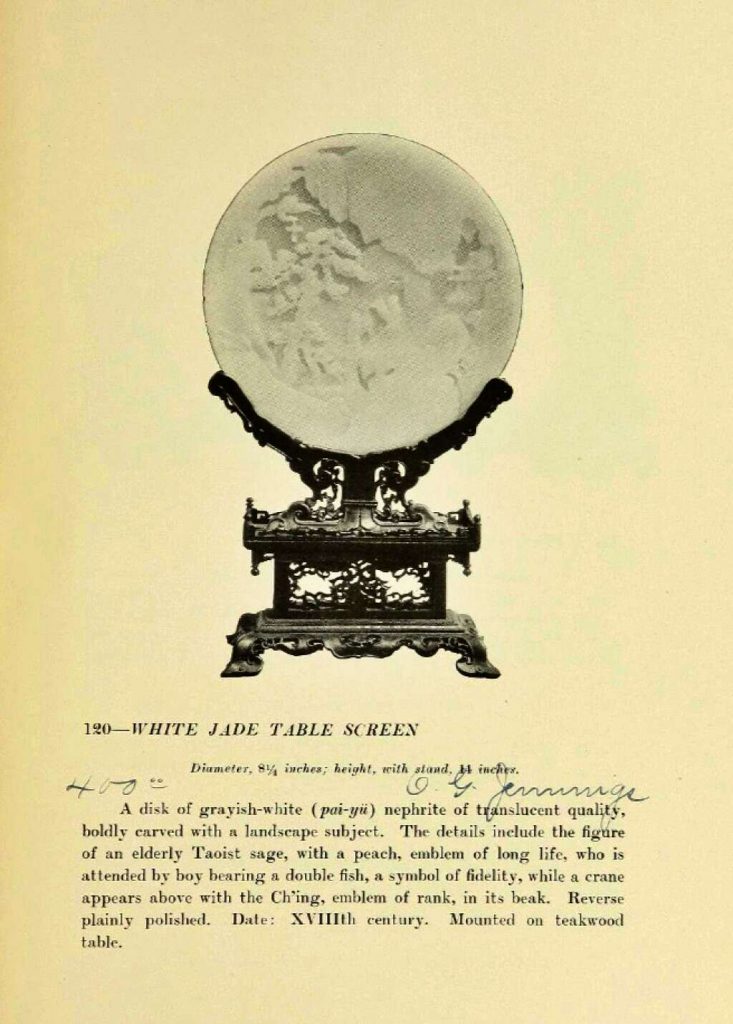
Estimate:150,000 – 200,000 GBP 欧元
Lot Sold:247,650 GBP 欧元
Description
Property from an Asian Private Collection
亞洲私人收藏
A finely carved imperial white jade ‘figural’ table screen
Qing dynasty, Qianlong period
清乾隆 御製白玉雕松鶴祝壽圖圓硯屏
wood stand
Overall height 35.4 cm, 13⅞ in.
Condition Report
表面見極輕微磨痕,通體邊角處見極細微磕痕。底座一欄杆缺失。
Provenance
Collection of Aisin Gioro Puwei (1880-1936), Prince Gong.
Yamanaka & Co., New York.
American Art Galleries, New York, 27th February 1913, lot 120.
Nagatani, Chicago.
Milwaukee Art Museum, Milwaukee.
Christie’s New York, 22nd March 1999, lot 30.
恭親王愛新覺羅溥偉(1880-1936)收藏
山中商會,紐約
American Art Galleries,紐約,1913年2月27日,編號120
Nagatani,芝加哥
密爾沃基美術博物館,密爾沃基
紐約佳士得1999年3月22日,編號30
Catalogue Note
Notable for its large size and intricately carved scene of two figures in a landscape, this circular screen exemplifies the ‘pictorial jades’, where the imperial jade carvers treated the stone like a painting canvas. Crafted from carefully chosen white jade, the screen’s material enhanced the varying depth of the carved pictorial scene, showcasing the masterful artistry and attention to detail that went into its creation. The carvers’ careful employment of varying depths and the associated difference in levels of light passing through the translucent stone, created here a strong sense of three-dimensionality that could not be achieved with a flat painting. By appreciating screens like this, viewers could be transported into a tranquil and harmonious landscape, escaping the daily duties of officialdom.
The screen depicts an auspicious scene of an elderly person holding a peach, accompanied by his young attendant who is presenting a gift, both under a group of pine trees, against a rocky landscape with a crane holding a qing (musical stone) in the sky, and a pavilion in the distance. The pine tree, peach, and crane are symbols of longevity, aligning harmoniously with the qing which is a homophone for ‘celebration’ in Chinese. Together, these elements make this piece a perfect birthday gift.
The piece is notable for its provenance. It originally belonged to Puwei (1880–1936), Prince Kung (Gong) of the First Rank, who was the grandson of Yixin (1833–1898), the first Prince Kung and the sixth son of the Daoguang Emperor. In the turbulent times that followed the demise of the Qing dynasty, Puwei, who was facing serious economic difficulties, sought refuge in the German protectorate and offered his mansion and belongings as mortgage to the Catholic Benedictine Order. However, it was Yamanaka Sadajiro (1865-1935), the renowned Japanese antique dealer, who had opened a store on West 27th Street near Broadway in New York, who acquired the collection and in 1913 offered it for sale at the American Art Association, where it was sold on 27th February as lot 120.
Compare a table screen with similar carving, but of spinach jade, illustrated in Yubao qiulin. Qinggong jiucang yuqi / Treasure of Imperial Jade. The Collection of the Qing court Special Exhibition, Beijing, 2018, pl. 65. Compare also several related screens, all depicting figures in landscapes, one previously in the Heber R. Bishop Collection, now in the Metropolitan Museum of Art, New York (acc. no. 02.18.652); a pair form in the Royal Collection Trust, illustrated in John Ayers, Chinese and Japanese Works of Art in the Collection of Her Majesty The Queen, London, 2016, vol. III, pls 1794 and 1795; and another pair, one in the Fogg Art Museum, Harvard University, Cambridge, the other from the Frederick Knight Collection, illustrated in Robert Kleiner, Chinese Jades from the Collection of Alan and Simone Hartman, Hong Kong, 1996, pl. 123, sold at Christie’s Hong Kong, 27th November 2007, lot 1511.
此品玉雕插屏碩大,雕山水畫意紋樣,近景有人物、岩石、樹木,遠景配以山巒雲霧,其間一小屋若隱若現,具有類似繪畫的視覺效果。白玉質地溫潤,玉料深淺不同的雕琢,呈現繪畫般筆觸,體現宮廷造玉坊工匠精湛的玉雕工藝及對細節的關注。作品的設計因形就勢,景物遠近層次分明,清新祥和的自然美景令人遺忘俗世之憂。
此屏乃一位仙翁手持壽桃,侍童雙捧賀禮,遊走於山石間。圖景見古松參天,仙鶴銜磬。山路蜿蜒,終至亭台。松、桃、鶴乃象徵長壽,磬與「慶」諧音,意喻吉祥,祝頌誕辰之意。
此白玉插屏來源顯赫,為恭親王愛新覺羅溥偉(1880-1936)舊藏。溥偉是道光帝旻寧曾孫,恭親王奕訢之孫,貝勒載瀅之子。清末民初動盪的時代,溥偉在經濟困難之下開始變賣王府珍寶。著名的日本骨董商山中定次郎(1865-1935),同時是山中商會創始人,從其手中收購大批藏品,將一批運往其位於紐約西27街的骨董店,近百老匯。1913年又將部分送至美國藝術協會拍賣,此屏於同年2月27日售出,拍品編號為120。
參考一例近似碧玉插屏,見《御寶璆琳清宮舊藏玉器》,北京,2018,圖版65;另可與數例相比,其一為Heber R. Bishop舊藏,今藏於紐約大都會美術博物館(藏品編號02.18.652);其二為英國皇家信托收藏,載於《Chinese and Japanese Works of Art in the Collection of Her Majesty The Queen》,倫敦,2016年,第三冊,圖1794及1795。再比一例,藏於哈佛大學福格藝術博物館,另件一例為Frederick Knight收藏,收錄於 Robert Kleiner,《Chinese Jades from the Collection of Alan and Simone Hartman》,香港,1996年,圖版123,並售於香港佳士得,2007年11月27日,編號1511。
参考:保利5周年春季拍卖会
宫廷艺术与重要瓷器、工艺品
4323 清乾隆 白玉圆形插屏连碧玉座
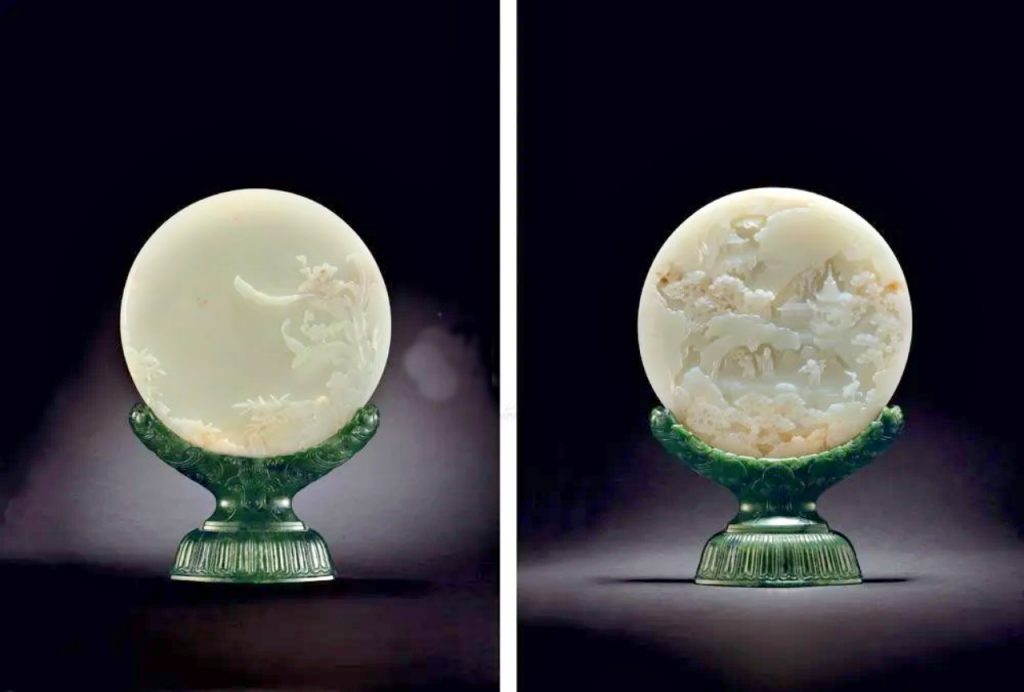
尺寸 高31cm
估价 3,800,000-5,800,000
成交价 RMB 8,736,000
此插屏为圆形,下承碧玉座,屏面以白玉制成,此玉质润而腻,色纯则雅,双面均有雕工。其一面运用高浮雕技法雕刻山水、人物、楼台亭阁、古树苍松等图案,顶部高山行云,于前屏统一,而庭院内太湖石、围墙、台阁等园林建筑,涌现眼前。所雕三人神形各异,或捧花、或负物、或回首、或前行,屏右下雕一仙鹤敛翼停立,使此屏面更加灵动而富有生机。整幅画面内容丰满,构图布局要妙,刚柔相济,虚实相合,层次感强。另一面巧雕花石,一株水仙迎风摇曳,其叶姿秀美,花香浓郁,亭亭玉立,不愧有“凌波仙子”之雅号,屏面留下大片空白,可资后人题咏。
《楚辞·九歌·湘夫人》有云:“白玉兮为镇,疏石兰兮为芳。”此插牌所用白玉质地细腻滋润,纯净温雅,白如割脂,孔子认为“玉温润而泽,仁也;缜密以栗,知也;廉而不刿,义也;垂直如队,礼也;叩之,其声清越悠长,其中诎然,乐也;瑕不掩瑜,瑜不掩瑕,忠也;孚尹旁达,信也;气如白虹,天也;精神见于山川,地也;圭璋特达,德也;天下莫不贵者,道也。” 正是因为孔子以儒家的信条对玉作出了诠释,随之成为后世琢玉、赏玉、佩玉的品评尺衡,极大地激发了玉器的“世俗”生命力,由此以后的两千年间,玉文化在中华大地上薪火相传。
时至清乾隆年间,玉器生产达到顶峰,国事强盛的清廷,特别是江南一带的官吏、富商,喜欢收藏文玩以附庸风雅,带动苏州、扬州的玉市逐步呈现欣欣向荣的气象。彼时的风格主要取奇巧的造型、华丽的纹饰、细琐的做工以及吉祥的主题,这种风格在当时被谓以“时样”之名,在民闲广受喜爱,然而却为乾隆皇帝所厌恶。究其原因,乾隆皇帝深受宋以来文人“尚古”观念的影响,素以风雅自许,对玉器尤为喜爱,对玉器品味偏重古朴文雅,其咏玉的诗写有800余首。据说故宫博物院现藏古玉一万余件,其中多半为乾隆时期搜罗来的。
而此拍品玉质莹润细洁,细腻光润,所雕山水人物、树木花石构图如画,清新古雅,画面层次分明,线条清晰利落,雕琢技艺高超,工艺细致生动,刀法细劲遒婉,且玉屏多以木质底座承之,此件却以上好的碧玉雕座,十分罕见,尤显珍贵,据专家告之,在北京故宫大量藏玉中亦只有数件而已,当为一件清乾隆时期宫廷造办处所为的精细高品级之陈设品。
来源:”A splendid Collection of Antique Chinese Nephrite carvings” Manheim Galleries, New Orleans, Louisiana USA
参考:保利5周年秋季拍卖会
宫廷艺术与重要瓷器工艺品
4725 清乾隆 白玉双面山水人物插屏
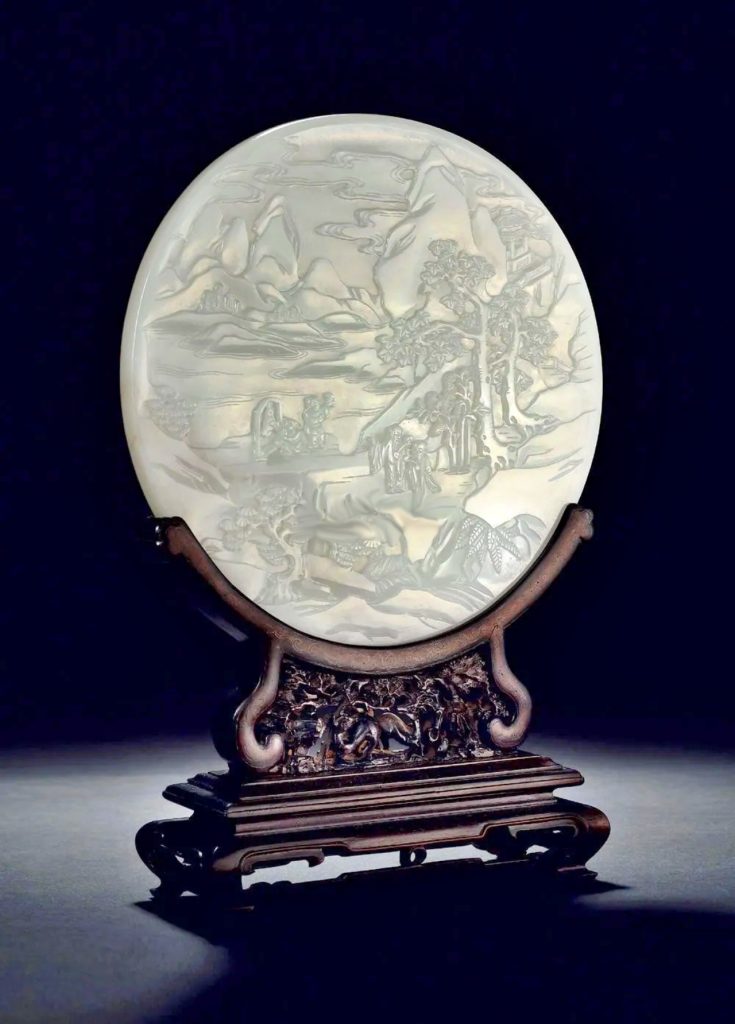
尺寸 长23.5cm;宽17cm
估价 2,800,000-3,800,000
成交价 RMB 3,360,000
玉质莹润,宝光内蕴。插屏为双面刻,一面雕山石崚嶒,云气氤氲,苍松虬立,山涧溪流,若仙人之境,仙鹤行步其间,仙风道骨,神态飘逸,羽毛质感极强,似是伸手可及;另一面刻相近之胜景,另见松下高士相互对语,后有童仆徐徐前行,远处见楼台亭阁掩映于群山深处云气间,若蓬莱仙境,童仆手执“戟”与“磬”,意为“吉庆”,老者手托一盆莲花,含苞欲放,寓意吉庆连连。此插屏双面构图皆有“结庐在仙境”之意,而又寓意吉祥,刀法深峻圆润,细腻流畅,布局景物如画,质料均佳,包浆润泽,实为隽品。若置于书斋,可鉴诗意之美,亦得清赏之乐。
带座
参考:保利
5周年秋季拍卖会
宫廷艺术与重要瓷器工艺品
4726 清乾隆 白玉仙人婴戏图圆形插屏
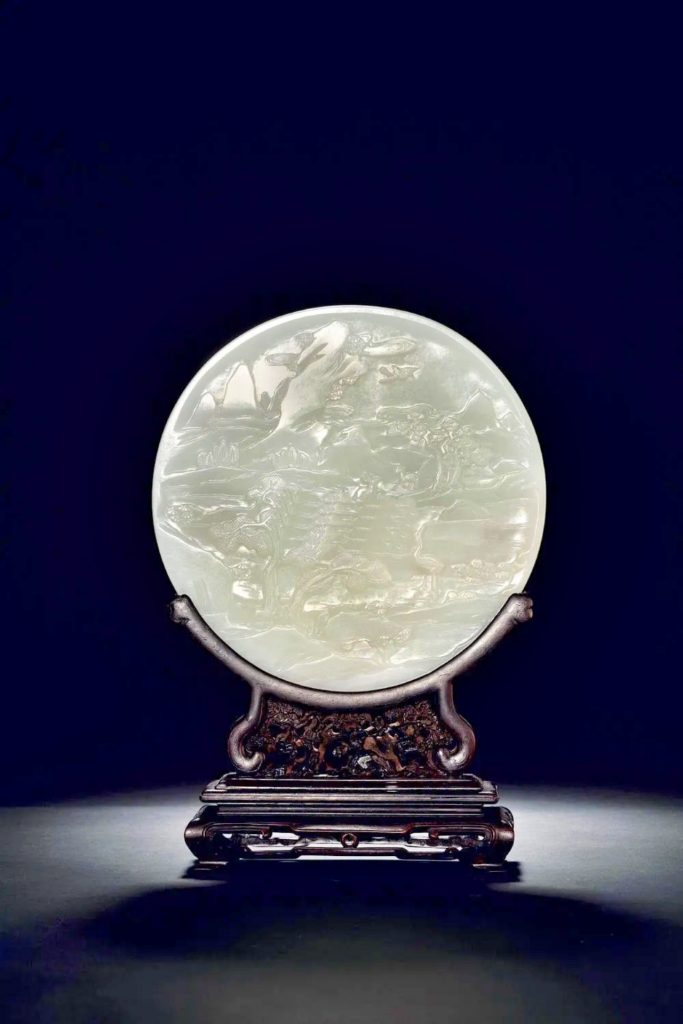
尺寸 直径21cm
估价 3,500,000-5,500,000
成交价 RMB 6,160,000
此插屏为圆形,以硕大白玉雕琢而成,此玉质润而腻,色纯则雅,双面均有雕工。其一面运用高浮雕技法雕刻山水、人物、与古树苍松等图案,顶部高山行云,近景松柏树木、仙人高士、玩耍孩童涌现眼前,图样纹饰富有深度,颇具层次感。其二长者比肩相邻,均持物而立,或回首、或前视,衣纹拂动,神情闲适,有仙家道骨之气度;稍远处有二童子,玩耍于山岩之上,其一手持灵芝,另一敲击钟磬,增添了一抹盎然生机。插屏的另一面亦精雕绘饰图景,高山行云、苍松翠柏之间,一对小鹿或卧或立于林间树下,一仙鹤敛翼停立,屏面灵动而富有生机。
清乾隆年间,玉器生产达到顶峰,主要取奇巧的造型、华丽的纹饰、精细的做工以及吉祥的主题为风格,在当时被谓以“时样”,广受喜爱。而此拍品玉质莹润细洁,细腻光润,所雕山水树石、仙人童、瑞鹤福鹿均颇为巧妙,整体构图如画,清新古雅,雕琢细致生动,寓意吉祥,诚为可贵。
带原配紫檀嵌银丝座
参考: 保利 5周年春季拍卖会
“九土来王”东西美术交流与乾隆盛世
4147 清乾隆 白玉雕海屋添筹御题诗圆形插屏
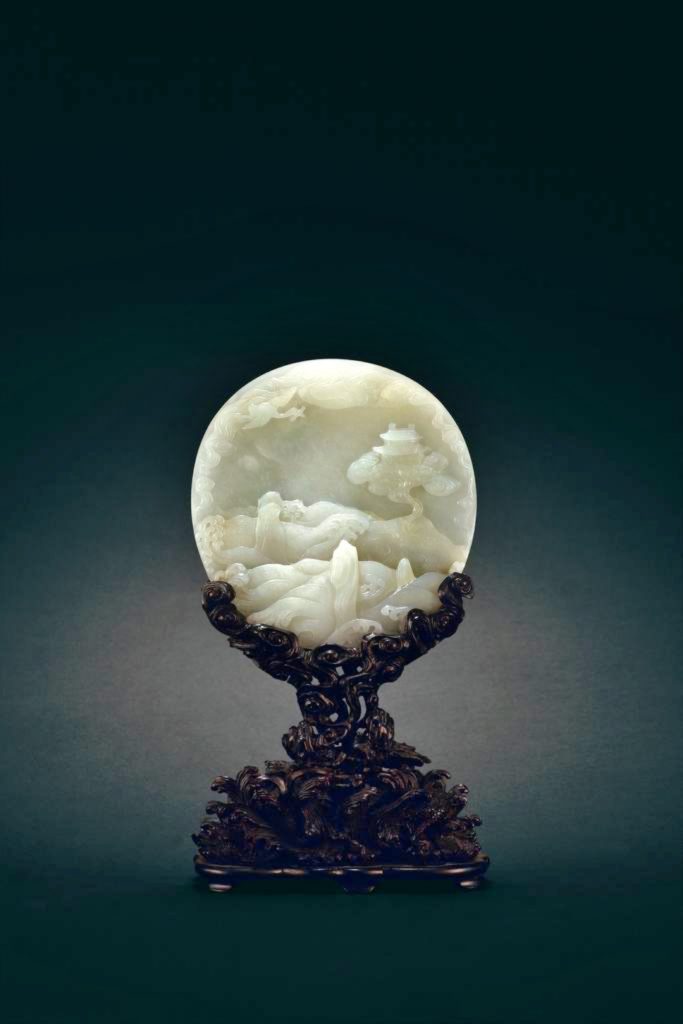
尺寸 直径13cm
估价 RMB 1,200,000-1,800,000
成交价 RMB 2,016,000
配紫檀座
古时,随着达官显贵和文人雅士赏玩的需要,在文人雅士们的厅堂楼舍或书斋案头,又出现了一种以摆设为主的屏风,其颇具装饰性和观赏性,那就是如今人们所说的插屏。这类器物如同一首无声的诗、一幅立体的画,点缀着文人雅士的书香天地,让置身其间的人们感受诗情画意的无限情趣。
插屏取白玉圆裁而制,通体洁白细润,造型古雅,小巧玲珑,饶有趣味。其下承紫檀木座,座透雕海水波浪纹,滚滚江涛衬以玉屏,相互呼应颇为巧妙,可谓极尽奢华。此圆屏一面浮雕海屋添筹典故,作品层层施技,底部雕海水波涛纹,汹涌澎湃,浪卷千尺,柱石林立,气势磅礴;其上饰仙宇楼台,以自海中腾起的祥云托举,营造得法,宏伟壮丽;屏上部边缘处雕一衔筹仙鹤,飞翔于云层之中。近处波浪涌起,远处寿山高耸,危崖嶙峋,山峦叠嶂,挺拔秀逸。作品将海屋添筹的山川美景,以雕镂之法琢刻而出,匠心独具,且年代古远而又保存完好,石峰崖角,俊丽如初,实为不易。
“海屋添筹”是中国传统的吉祥纹样,用于祝人长寿。“筹”为用竹木制成的小棍或小片,是用来计数的工具;而“海屋”则为寓言中堆存记录沧桑变化筹码的房间。此典故出自宋代苏轼的《东坡志林·三老语》,其云:“尝有三老人相遇,或问之年…一人曰:海水变桑田时,吾辄下一筹,尔来吾筹已满十间屋”。传说在蓬莱仙岛上有三位仙人互相比长寿,其中一位仙人说道他每当他看到人间的沧海变为桑田,就在瓶子里添一个红筹码,现在堆放筹码的屋子已经有十间屋子了,这就是海屋添筹的传说典故。中国自古以来,上至君王,下至庶民均以尊重老人为一种美德,家中老人健康长寿是每个做子女的最大心愿,所以在中国古代绘画作品以及瓷器、工艺品的装饰中,常以“海屋添筹”作为祝福长寿题材,寓意美好,实为经典。
明清时期的插屏融实用性、欣赏性于一体,既有美学价值又有实用价值,故插屏的设计制作风行一时。此拍品一面作海屋添筹图,另一面亦雕海水江崖,亭台楼阁,边缘雕陡峭悬崖,并以松树作为点缀,水波粼粼,安静祥和,亭台形制规整,半隐于树石之后,一凤鸟栖息于枝头,敛翼侧首,寓意吉祥。留白处琢楷书御题诗并填以金粉,文曰:“架缚层楼及假山,山巅仙驾往而返,青鸾栖树女床表,白鹤添筹海屋间”,此为沧波楼之题诗。
此插屏布局周密,层次清楚,立体感强,图案设计精巧,雕琢细致入微,画意盎然,其配以紫檀木座,“带子上朝”寓意鲜明。从《清档》资料查询,并结合其工艺水准、风格特点等方面综合权量,应当为乾隆时期作品,由养心殿造办处设计绘图,是为宫廷御用陈设品,俏丽又不失古雅,甚是精彩。
参考:北京保利十二周年春季拍卖会
宫廷艺术与重要瓷器、玉器、工艺品
5900 清中期 白玉仙人鹿鹤圆形插屏 (一对)
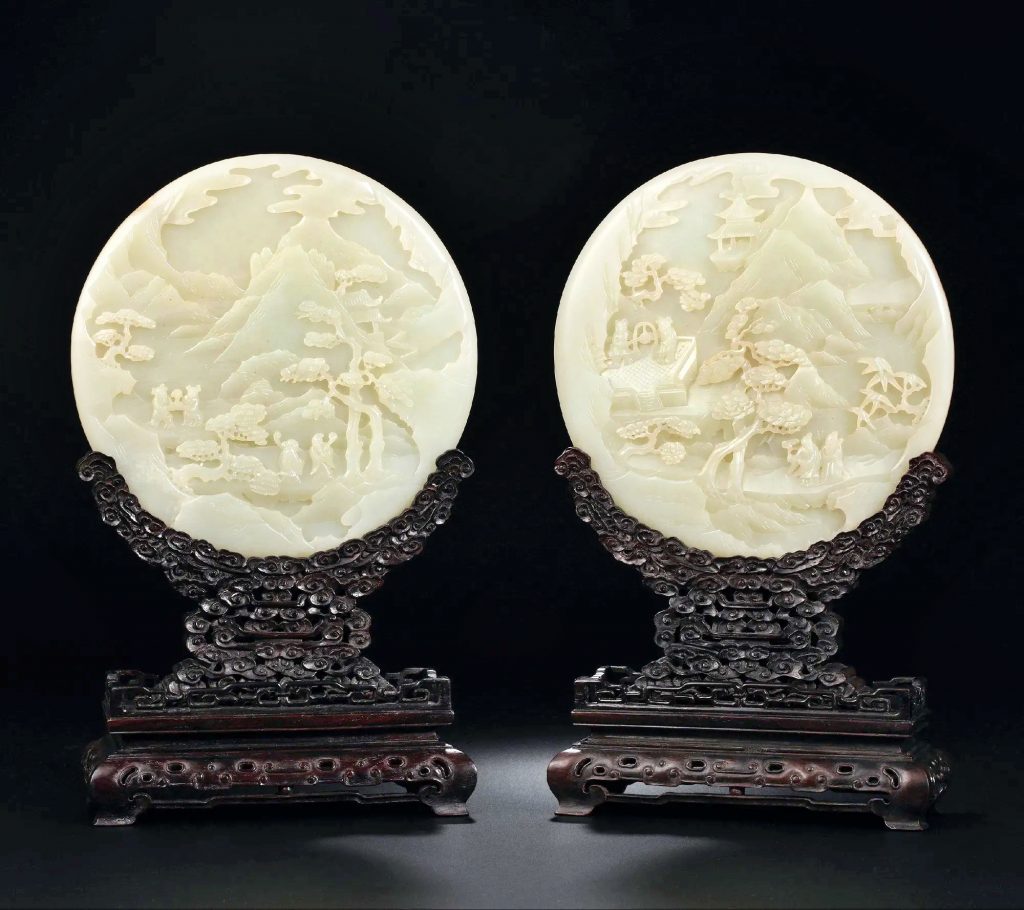
尺寸 直径21cm
估价 750,000-950,000
成交价 RMB 920,000
此对插屏以整块白玉雕琢而成。圆形,扁体,双面以浅浮雕手法雕刻仙人祝寿、鹤鹿同春图。一面仙人祝寿图依山水画之理,仙山云环雾绕,茂林修竹,怪石嶙峋。众仙人手执仙杖灵芝,且行且谈,怡然自得。远处亭台仙阁巍峨高耸,隐隐现于云山之间。又有小童分别抬送寿桃、灵芝等祥瑞之物,伶俐喜人。画面远近高低,疏密有致,层次分明,甚有章法。所雕画面既有云山寒林之高远画意,又有仙瑞云集之盛景,再加之以浮雕手法表现,凹凸有致,立体似实景再现。 插屏另一面雕刻仙鹤与灵鹿为主题纹饰。取山间一隅为景,其上仙鹤引颈顾盼,矫健瑞秀。又有一双仙鹿,悠游于仙山玉泉之中,灵动传神。《淮南子•说林训》中载:“鹤寿千年,以报其游”,以仙鹤为饰,素有“鹤寿万年”之意。仙鹤与灵鹿相互呼应,以表“鹤鹿同春”。
插屏, 案几摆设之一,亦为清宫重要陈设品。乾隆帝爱玉成痴,故其时之玉器生产攀至顶峰。取奇巧之造型,华丽之纹饰,做工细致且取意吉祥者,于当时社会可谓“时样”,颇受推崇与喜爱。此对插屏体量厚重,用料奢侈,玉质温厚柔润,宝光内藴,包浆润泽,色纯而质雅。雕工精细,线条流畅,细劲遒蜿。尺幅之地运筹帷幄,极尽文人寄情山水之意趣,又不失长寿多福之吉祥寓意。玉制插屏下配紫檀圆底座,通体镂空如意云纹,纹饰繁缛,细节打磨光润。放置于案,清雅而不失高洁,实为清代宫廷陈设不可多得之佳作。
备注:美国藏家旧藏
参考:北京保利十二周年秋季拍卖会
宫廷艺术与重要瓷器、玉器、工艺品
6170 清中期 白玉仙人鹿鹤同春圆形插屏 (一对)
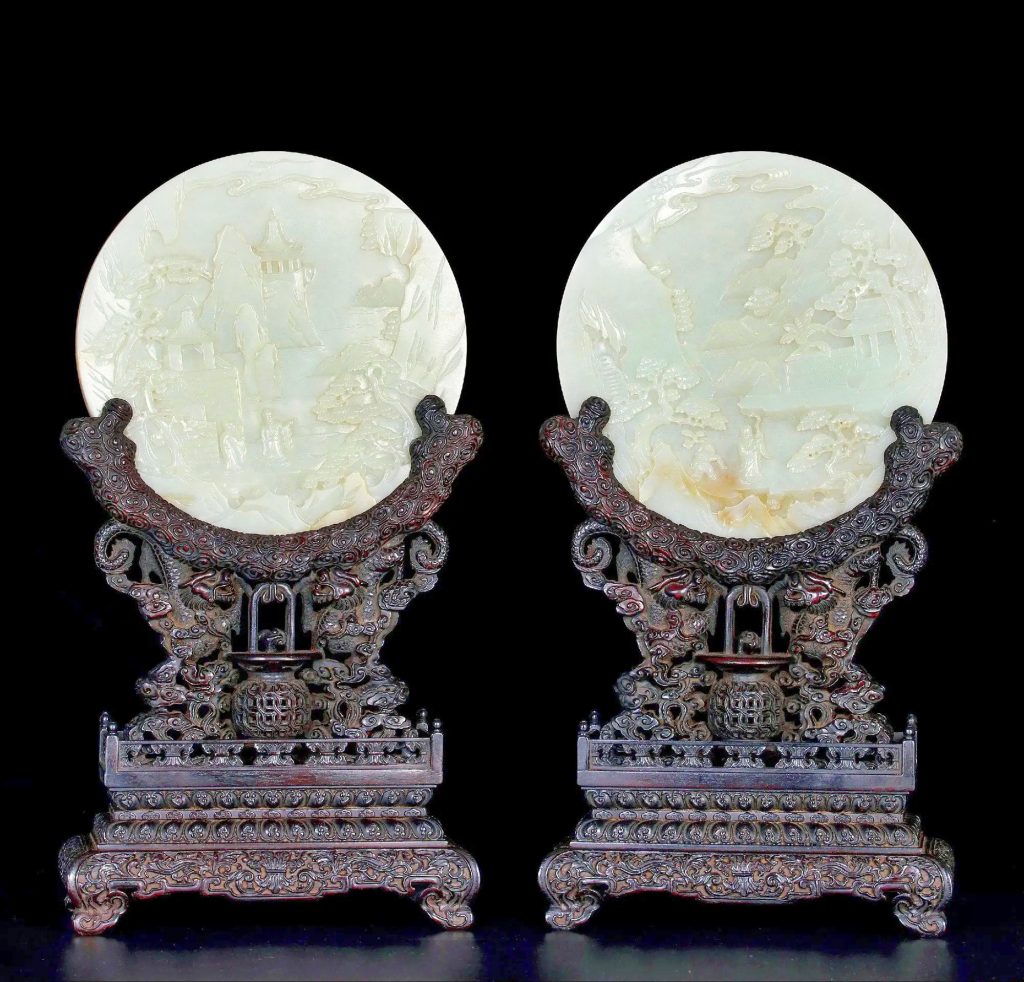
尺寸 直径20cm
估价 700,000-900,000
成交价 RMB 862,500
此对插屏以整块白玉雕琢而成。圆形,扁体,双面以浅浮雕手法雕刻仙人、鹿鹤同春图。一面仙人图依山水画之理,仙山云环雾绕,茂林修竹,怪石嶙峋。众仙人手执仙杖灵芝,且行且谈,怡然自得。远处亭台仙阁巍峨高耸,隐隐现于云山之间。画面远近高低,疏密有致,层次分明,甚有章法。所雕画面既有云山寒林之高远画意,又有仙瑞云集之盛景,再加之以浮雕手法表现,凹凸有致,立体似实景再现。 插屏另一面雕刻仙鹤与灵鹿为主题纹饰。取山间一隅为景,其上仙鹤引颈顾盼,矫健瑞秀。又有一双仙鹿,悠游于仙山玉泉之中,灵动传神。《淮南子•说林训》中载:“鹤寿千年,以报其游”,以仙鹤为饰,素有“鹤寿万年”之意。仙鹤与灵鹿相互呼应,以表“鹿鹤同春”。
插屏,案几摆设之一,亦为清宫重要陈设品。乾隆帝爱玉成痴,故其时之玉器生产攀至顶峰。取奇巧之造型,华丽之纹饰,做工细致且取意吉祥者,于当时社会可谓“时样”,颇受推崇与喜爱。此对插屏体量厚重,用料奢侈,玉质温厚柔润,宝光内藴,包浆润泽,色纯而质雅。雕工精细,线条流畅,细劲遒蜿。尺幅之地运筹帷幄,极尽文人寄情山水之意趣,又不失长寿多福之吉祥寓意。玉制插屏下配紫檀圆底座,通体镂雕纹饰,纹饰繁缛,细节打磨光润。放置于案,清雅而不失高洁,实为清代宫廷陈设不可多得之佳作。
备注:美国藏家旧藏
参考:北京保利2018春季拍卖会
宫廷艺术与重要瓷器、玉器、工艺品
5957 清中期 白玉圆插屏 (一对)
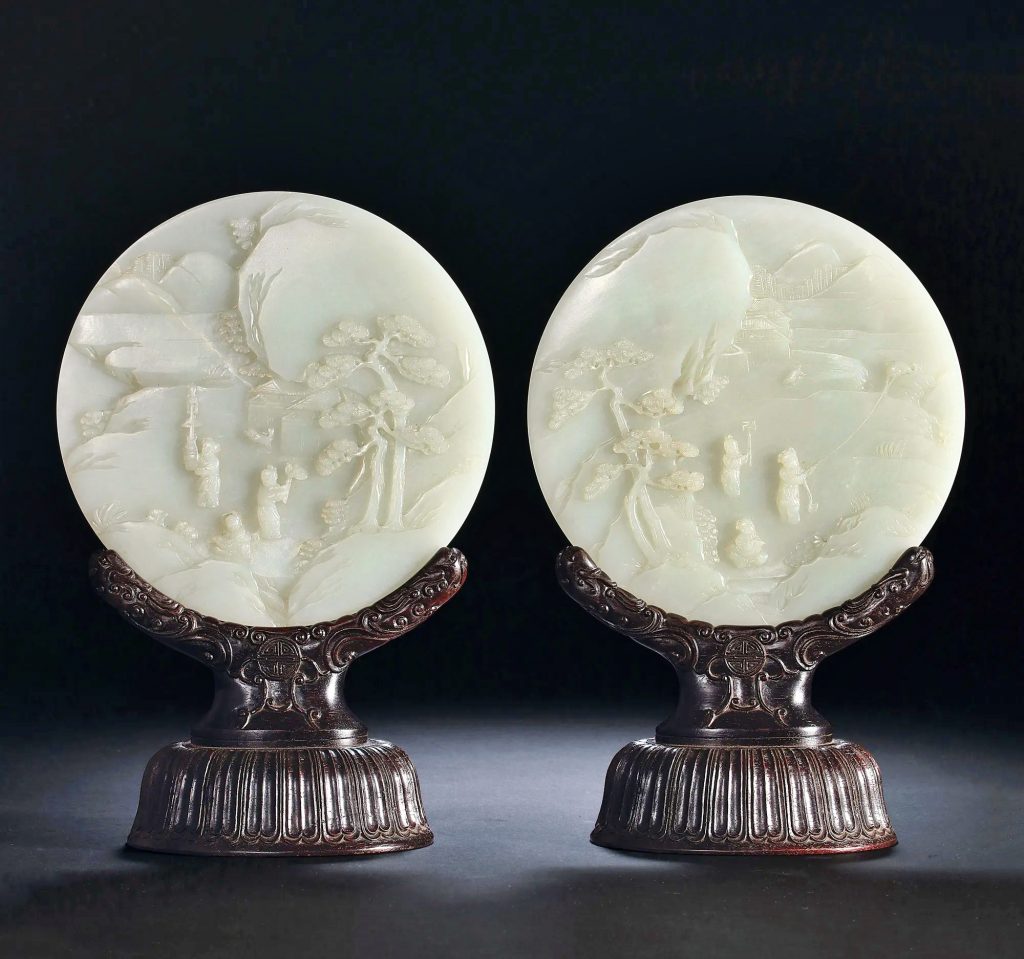
尺寸 直径17.2cm
估价 800,000-1,200,000
成交价 RMB 1,035,000
此对插屏以整块白玉雕琢而成。圆形,扁体,双面以浅浮雕手法雕刻庭院婴戏图。依山水画之理,刻画山峦云环雾绕,溪水潺潺,苍松立于岸边。远处亭台仙阁巍峨高耸,隐隐现于云山之间。画面远近高低,疏密有致,层次分明,甚有章法。其间三五小童,或放大鱼风筝,寓意“连年有余”,或抱鸡,寓意吉祥如意,或端吉磬宝瓶,寓意“平安吉祥”,或手持万字法器,寓意“万代如意”,或持蝴蝶,寓意“长寿耄耋”,十分吉祥。童子间又有犬儿欢喜奔跑,取兴旺之意,十分吉祥,所雕画面既有云山寒林之高远画意,又有婴戏欢腾之盛景,再加之以浮雕手法表现,凹凸有致,立体似实景再现。
此种富含吉祥寓意的婴戏纹饰,于当时社会可谓“时样”,颇受到推崇与喜爱,尤其是清宫皇族渴望子孙昌盛,于是此种婴戏图在宫廷画中也较为多见。此对插屏体量厚重,用料奢侈,玉质温厚柔润,宝光内藴,包浆润泽,色纯而质雅,无杂质绺裂,十分难得。雕工精细,线条流畅,细劲遒蜿。尺幅之地运筹帷幄,清雅间不失长寿多福之吉祥寓意。玉制插屏下配紫檀圆底座,通体镂雕纹饰,纹饰繁缛,细节打磨光润。放置于案,清雅而不失高洁,实为清代宫廷陈设不可多得之佳作,清宫亦藏有类似插屏陈列,可以参照。
参考
保利厦门2018秋季拍卖会
中国古董珍玩
0732 18世纪 白玉游春图插屏 (一对)
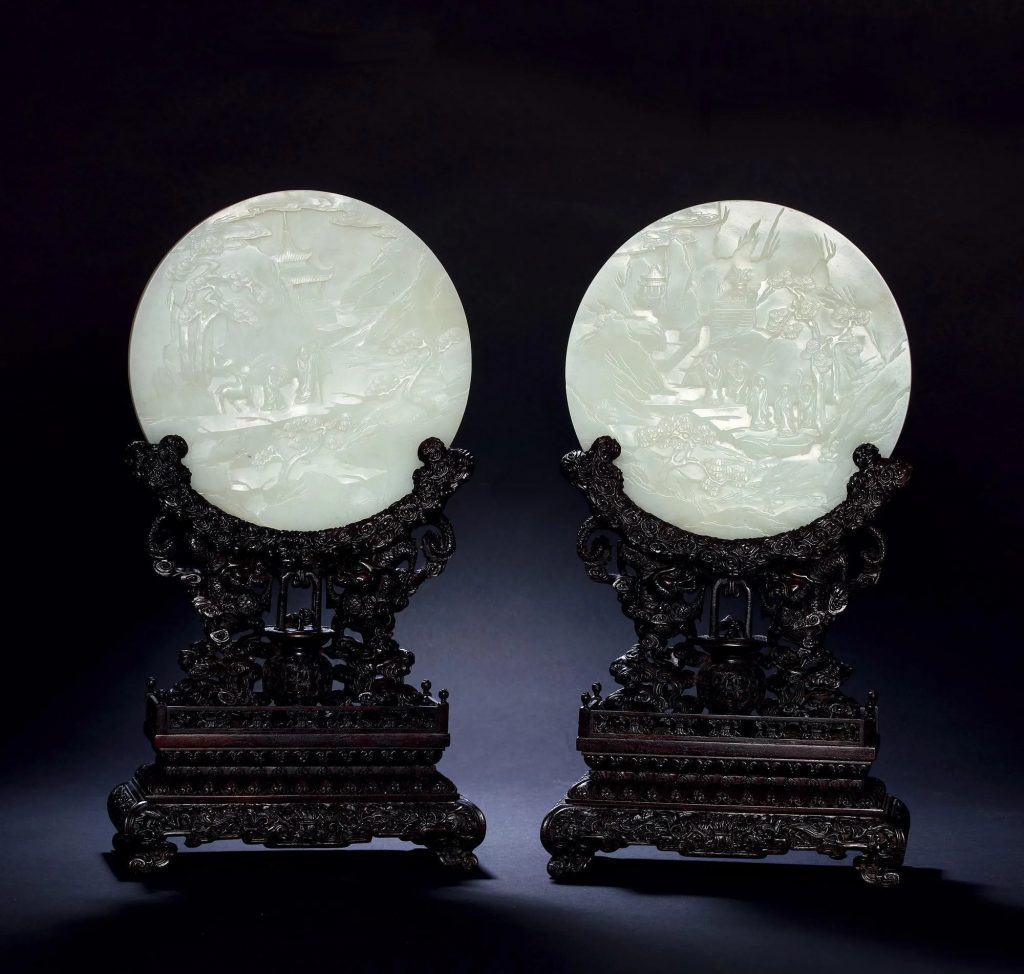
尺寸 直径20cm×2
估价 680,000-980,000
说明:拍品白玉雕,用料上乘,典雅古朴,为玉雕插屏之杰作。圆形,其上双面浮雕镌刻山水人物图,正面崇山峻岭间亭台楼阁掩映,虬松傍山而生,松枝层层落落,葱茏茂盛。山中游人三两,或伴双鹿而游,或一行人游赏吟咏。另一面或为鹿于山石间憩息,其旁灵芝相依而生,或为劲松之下双鹤对吟,取“鹿鹤同春”之意,一派清闲惬意。下承紫檀底座,其上浮雕卷云纹,工艺繁复。
整器材质精良,雕工精湛,深浅浮雕结合使得画面层次感极强,工匠以刀为笔,于玉面之上尽情挥洒。置于案几清秀雅致,实为点睛之笔。
参考
保利5周年秋季拍卖会
文华秋实—文馨阁海外回流集珍
4924 清乾隆 白玉御题诗圆插屏
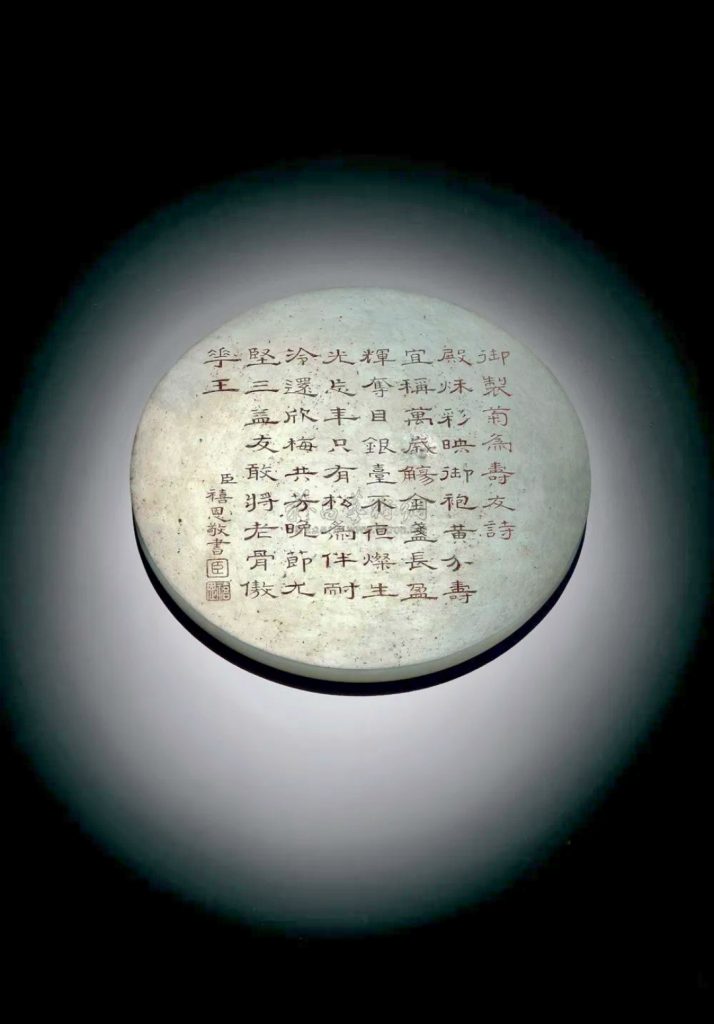
尺寸 直径12.6cm
估价 400,000-600,000
成交价 RMB 616,000
原配座
本品为清代御制插屏。本品2009年曾在巴黎Tajan拍卖行展拍。屏心为圆形,为上品白玉琢制而成。玉质温润晶莹。始知皇家藏品之高贵。屏心素面无纹,上录清禧恩题诗一首,题名为《御制菊为寿友诗》:“殿秋彩映御袍黄,分寿宜称万岁觞。金盏长盈辉夺目,银台不夜灿生光。忘年只有松为伴,耐冷还欣梅共芳,晚节尤坚三益友,敢将老骨傲花王。”禧恩,爱新觉罗氏,字仲蕃,隶正蓝旗,睿亲王淳颖子,清朝大臣。史载其“自道光初被恩眷,及孝全皇后被选入宫,家故寒素,赖其资助,遂益用事。遍膺禁近要职,兼摄诸部,凌轹同列,人皆侧目。后晚宠衰,禧恩亦数获谴罢斥。文宗即位,乃复起,不两年登协揆焉。”是清代重要大臣。下有钤印。诗文刻制精美,笔道有力,为行书善品。原配座。屏底座为实木所制,雕饰成莲花盛开之状,莲藕可见,清雅宜人,脱尘出世,为晚清白玉插屏中之佳品。是不可多得之佳作。
来源:2009年TAJAN,Lot178。
参考:保利2009秋季拍卖会
古董珍玩日场
3683 清 紫檀嵌白玉“天上人间”圆形插屏
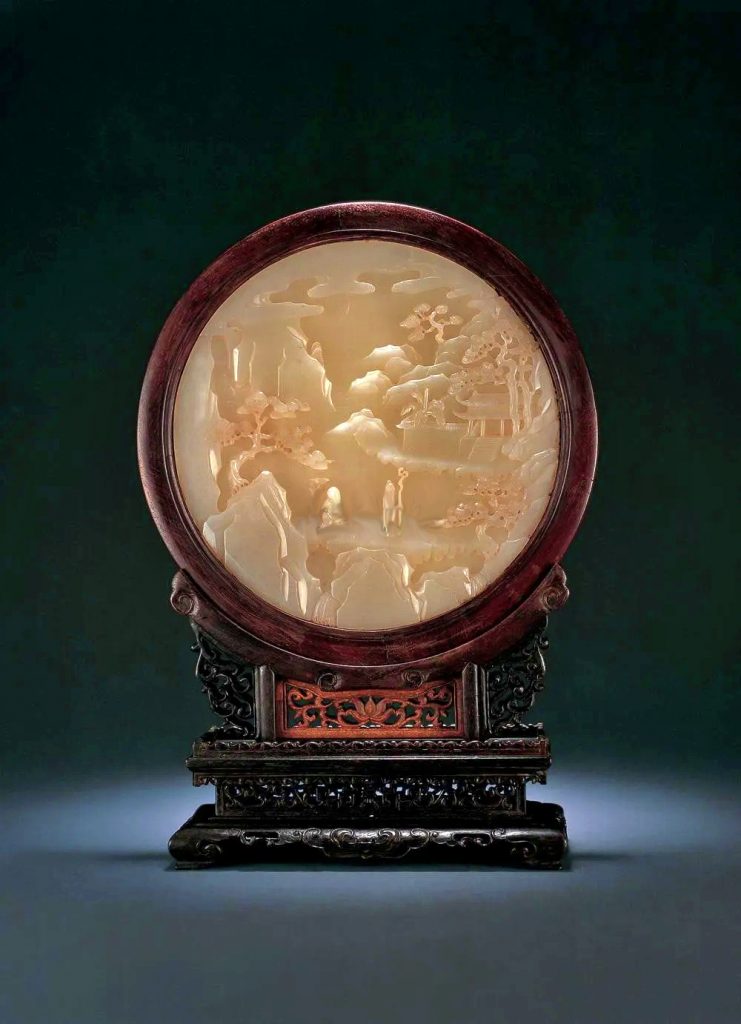
尺寸 高38
估价 80,000-120,000
此插屏座、框为紫檀木制,圆形白玉屏心,高浮雕“天上人间”图案,山峦、云气、亭阁、人物均栩栩如生,用料考究,做工细腻,精美绝伦,具有极高的艺术观赏价值。明代以前,屏风多趋于实用,被归为家具的一种,主要用于遮蔽和做临时隔断,大都是接地而设。清初出现的插屏和挂屏,开始兼有供人欣赏之用,因用途不同而尺寸相差悬殊,大者当门而设,相当于照壁,小者设于书桌、案头,用以观赏。
参考:2011年春季拍卖会
中国古董珍玩(二)
9470 清乾隆 白玉太平有象花卉双面圆形小座屏
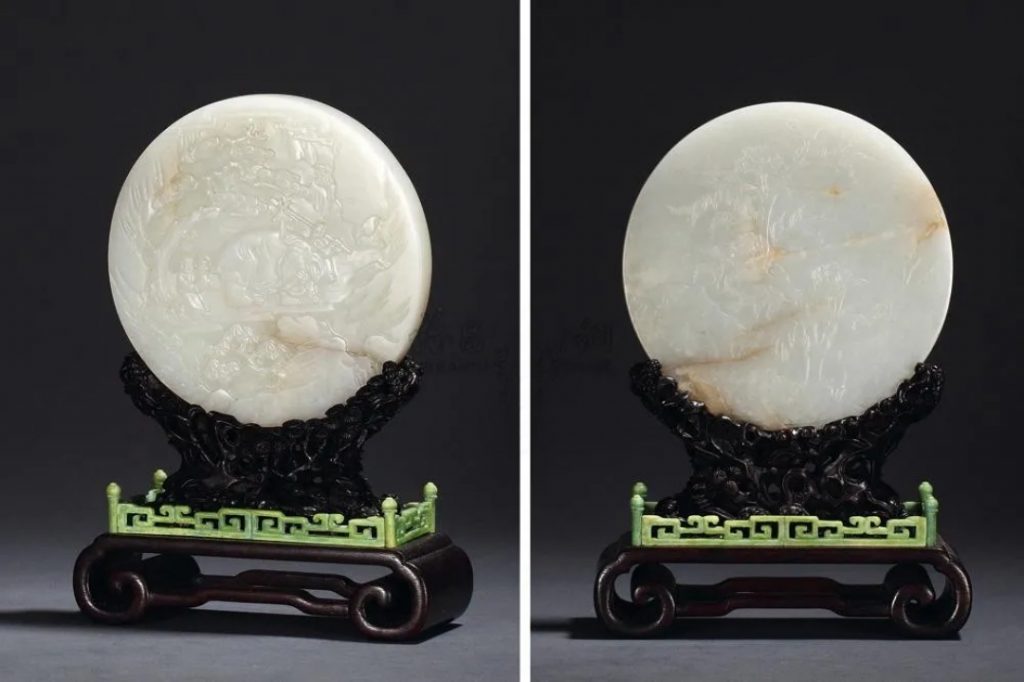
尺寸 直径13.5cm
估价 200,000-300,000
成交价 RMB 322,000
后配嵌象牙座
此屏玉质润白细腻,其一面刻有太平有象,另一侧刻有牡丹花卉,寓意富贵吉祥,雕工舒张流畅,纹样栩栩如生。边框为象牙质地,其色近似栗壳,局部茜绿色,制作精细,镂空雕刻松树与拐子龙纹;整器做工严谨,规整精细、包浆自然,十分华美。
参考
保利第34期精品拍卖会
瓷器·玉器·工艺品
1677 青白玉人物插屏
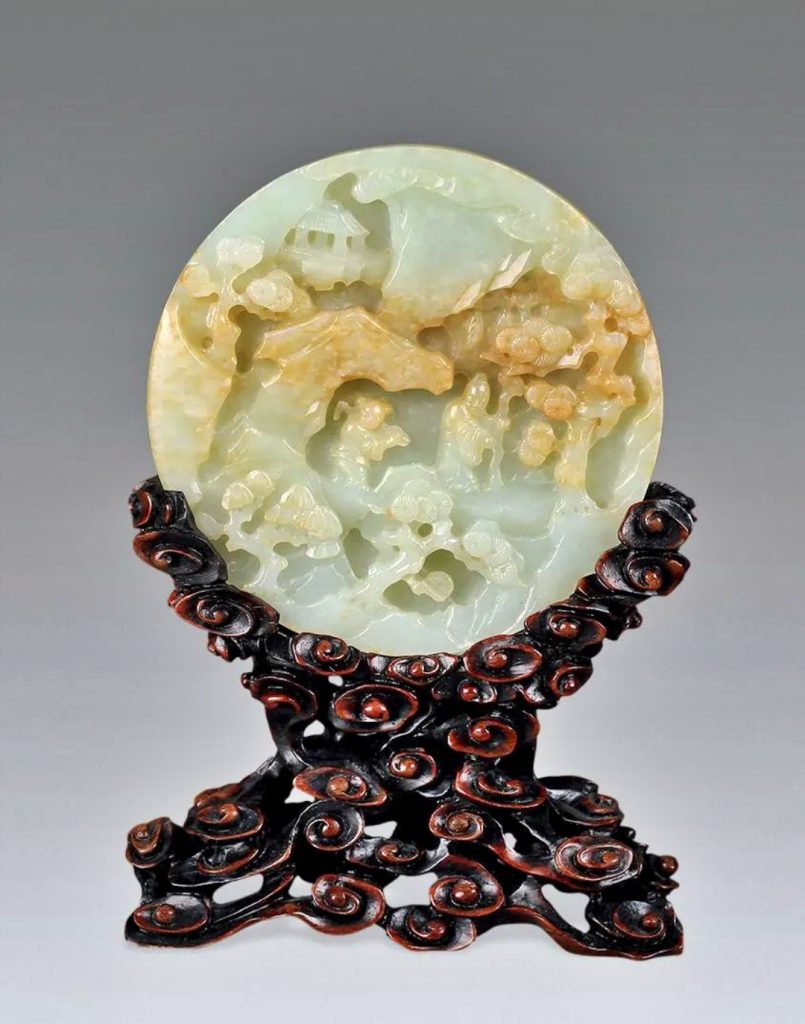
尺寸 高14cm
估价 12,000-22,000
成交价 RMB 13,800
参考
保利第36期古董精品拍卖会
瓷器 玉器 工艺品二
1676 白玉松下高士紫檀插屏
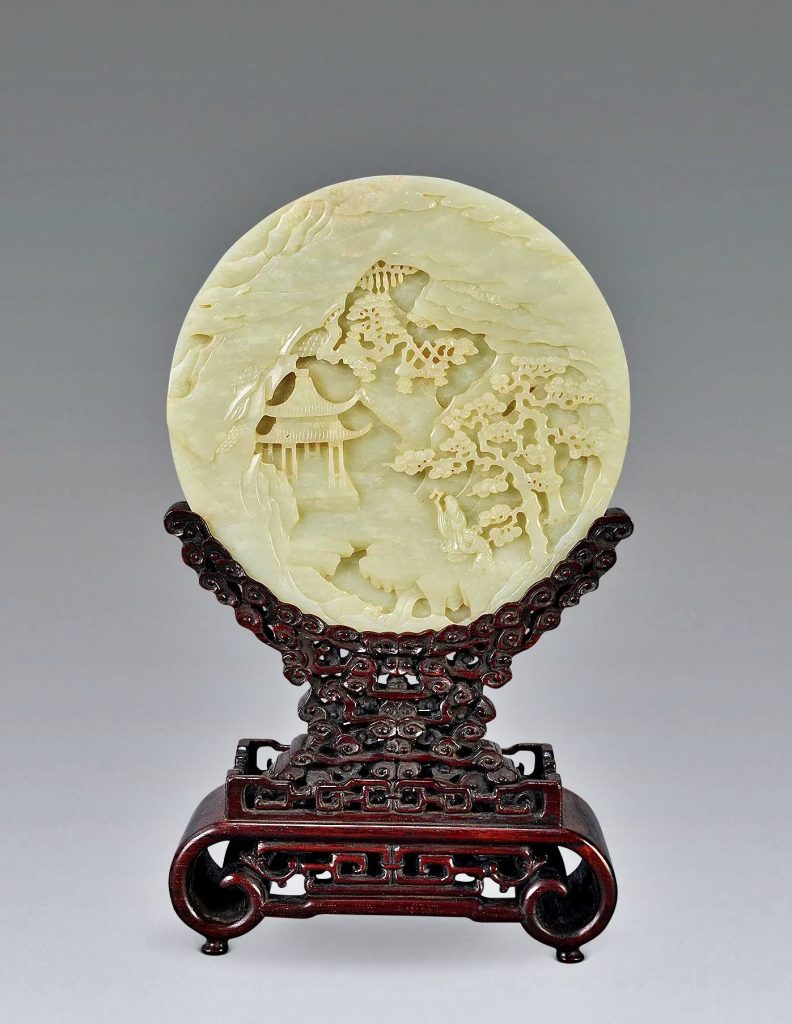
尺寸 高28cm
估价 无底价
成交价 RMB 34,500
参考 同类配座:
西泠印社2019年春季拍卖会
文房清玩·古玩杂件专场
图录号: 1174清乾隆·紫檀雕松鼠葡萄纹台几式圆屏座一对
QIANLONG PERIOD, QING DYNASTY A PAIR OF CIRCULAR ZITAN TABLE SCREENS WITH SQUIRREL AND GRAPE PATTERNS
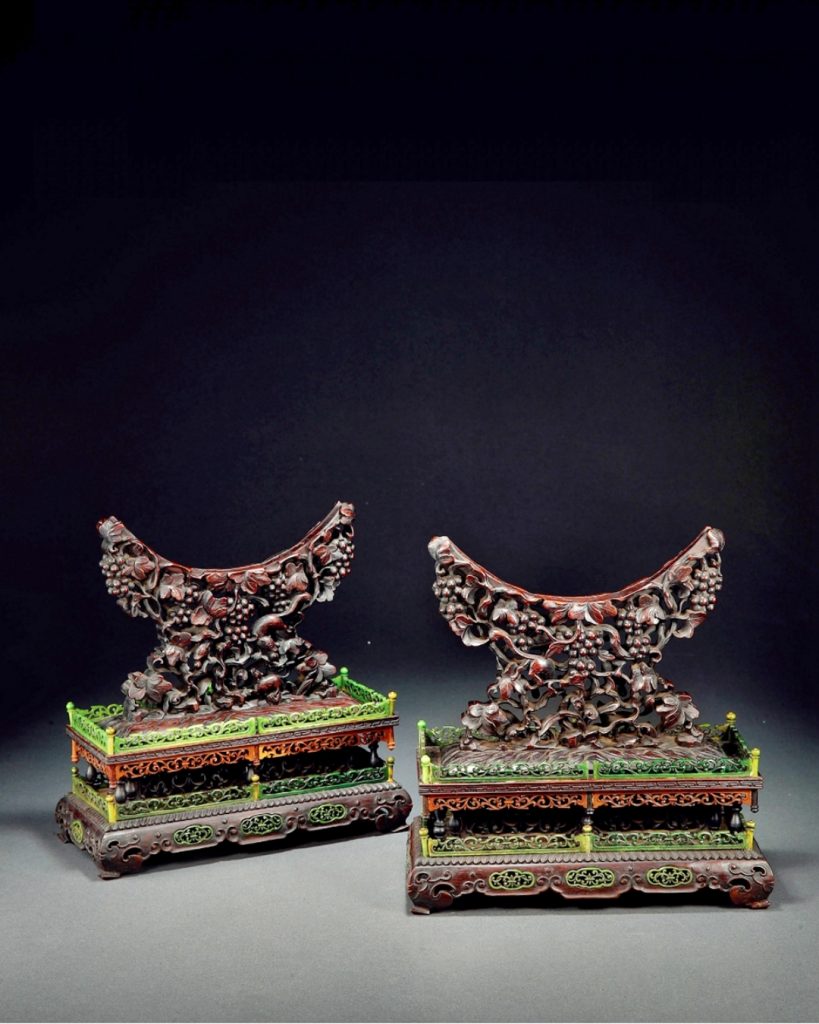
估价RMB: 95,000-150,000
成交价RMB: 109250(含佣金)
说明: 座分上下两部分组成。圆形座屏上部满浮雕松鼠葡萄纹,突显其意境清雅,悠然恬静之气,极富文人意味。底座扎实,边框以虯角染色饰云纹,与圆屏相呼应。下部座呈长方形,选料精良。座面上层四周雕相连如意结纹饰,腰部四面镂空开光雕花卉纹,花卉以染色虯角而雕成,相间点缀如意纹。胫足外撇。整件器物雕工老道,刀锋犀利,纹饰衔接适中,包浆醇厚,是一件不可多得的紫檀佳作。整座屏耗材奢侈,工艺繁缛,大气磅礴,给人以震慑之感。在清代,为了适应室内装潢的需要,在宫廷和上层阶层的居室内,广泛地应用插屏与挂屏等傢俱,但其实用性已基本退化,成为室内陈设的一部分,主要起的是美化环境的目的,故往往不吝成本,极尽精工之能事,而其设计与製作又与不同的场所与位置紧密相联,体现出一种时代风尚。
1.高:27cm 长:27cm 宽:12cm
2.高:27.2cm 长:26.8cm 宽:12cm
数量:2
参考:台北京騰龍
2021年春季拍賣會
宮廷.珍玩III
Lot.1008 清乾隆 青白玉描金刻御製詩座屏「臣 關槐恭集敬書 」款
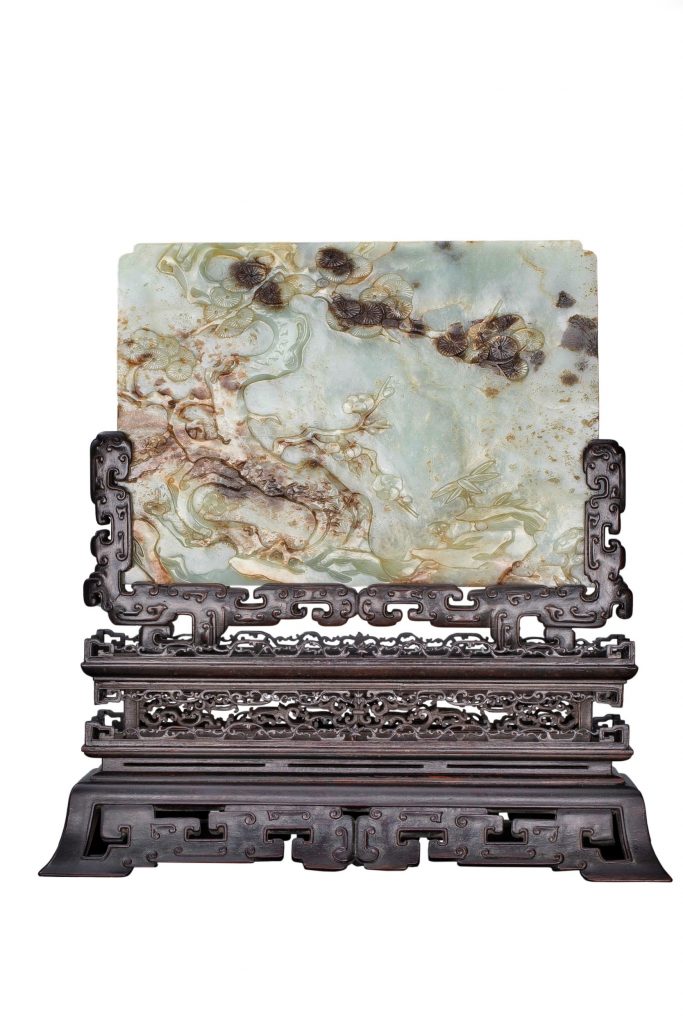
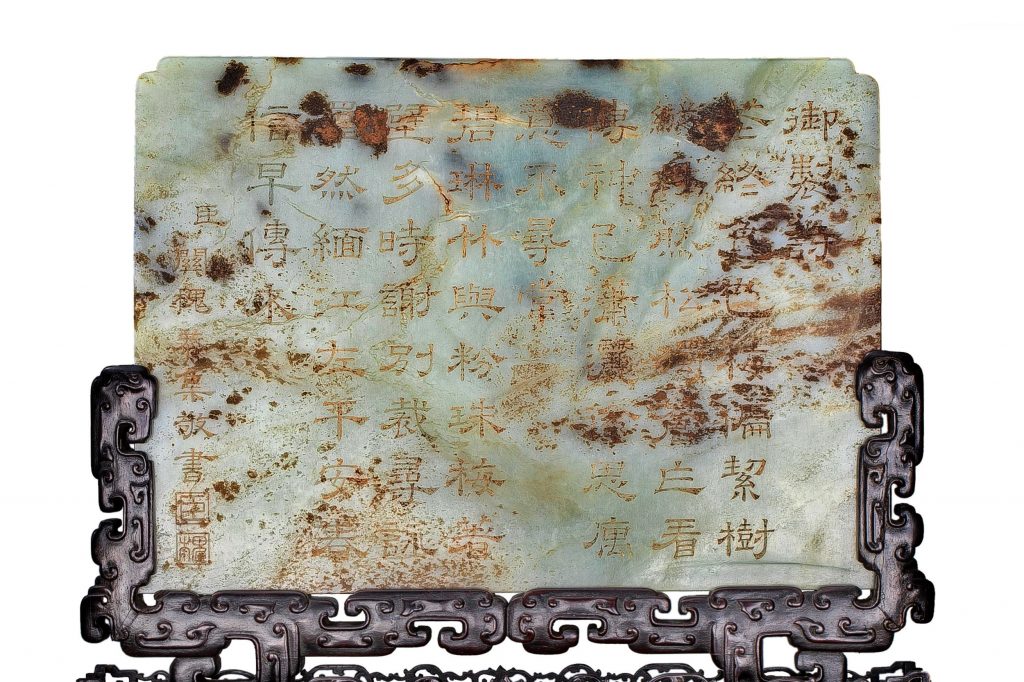
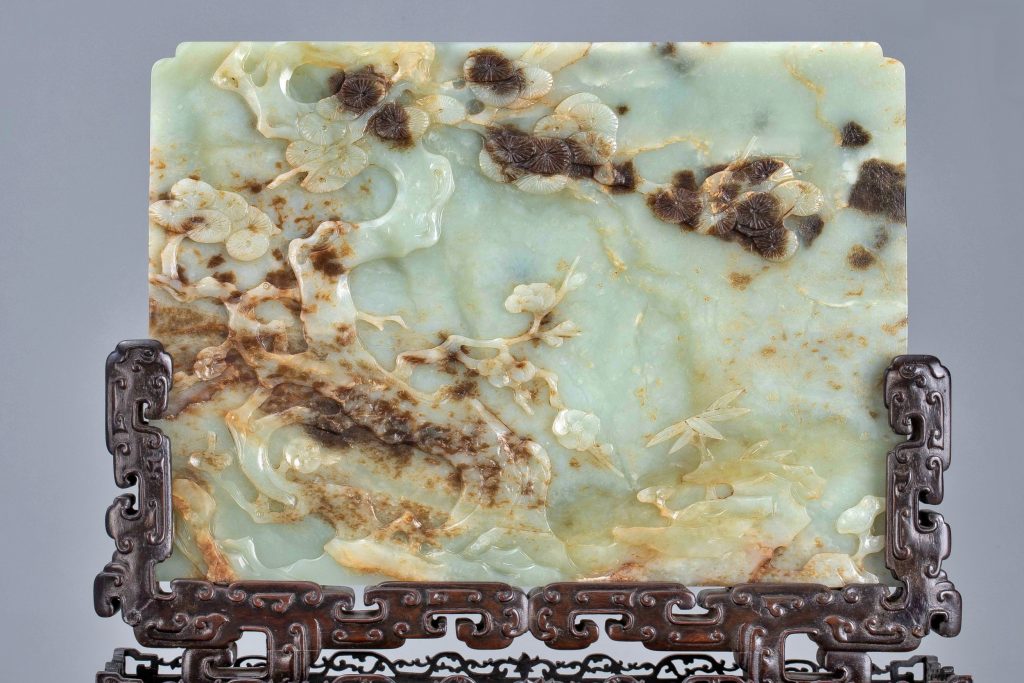
Size
H. 16.7 cm, W. 23.1 cm(不含座)
Description
刻文:
清高宗《御製詩三集》
< 鄒一桂松梅 >
花終色也梅偏潔,樹縱林然松獨蒼。乍看傳神已瀟灑,徐思寓意不尋常。
< 鄒一桂梅竹 >
碧琳竹與粉珠梅,著壁多時謝别裁。尋詠睪然緬江左,平安春信早傳来。
中國歷代帝王,十八世紀第一大收藏家,非清朝乾隆皇帝莫屬了。他對於中國藝術品有著極大的熱情,不遺餘力命人製作各種精美瓷器、玉器,有些人認為,大清國力衰退或多或少與乾隆嗜物有關,撇除乾隆皇帝的評價,乾隆是一位藝術家、創作家,一生創作四萬多首御題詩,其中題詠最多的就是中國書畫及玉器。關槐是清代乾隆時期的重要文臣,官至禮部侍郎,也是宮廷畫家,而此次京騰龍拍賣的主要拍品:清乾隆 青白玉描金刻御製詩座屏,落款 臣 關槐恭集敬書,為結合中國書法及宮廷玉器典範之作。
青白玉,玉色偏青,多處沁色深入。體呈長方形,浮雕裝飾,正面雕琢松樹為主體,畫面構圖飽滿,松葉以細陰刻線雕琢,與沁色與之結合,古樸淡雅。玉屏下方雕梅花、竹子,這種多層次的技法為標準乾隆時期的工藝,可參考北京故宮博物院藏一件同樣橫向的青玉燈右觀書插屏。背面篆刻塡金乾隆御題詩兩首:《鄒一桂松梅》及《鄒一桂梅竹》兩首七言絕句,呼應正面浮雕的松、竹、梅,結合玉器工法之美及乾隆御題詩的意境,十分難得的宮廷器物。
底座為上等紅酸枝木製成,酸枝木上漆,上部框架為ㄩ字形承托,雕飾夔龍紋,夔首朝上左右對稱;從框內凹槽寬度推估,原先玉版的厚度在八分左右,用料十分厚實。中部設計內外雙層結構,內層四面鏤雕纏枝紋縧環板,外層複以捲草紋上下環飾,形成有如戲台般之效果;下接束腰,底座券口裝飾拐子夔紋,與上部呼應。 整件器型雕工精緻,使用吉祥紋樣寓以美意,豪華繁複的細節使人目不轉睛。
中國自宋代以來,文人特別重視書齋的雅潔情趣,在空間運用上頗具彈性的插屏陳設及屏風,蔚為風尚。玉插屏通常搭配精美的木製插座合為一套,或成對擺設;小型插屏則為書齋清翫,大都是純粹賞玩性質的陳設品,因此玉質、雕工均十分講究。相輔相成者,底座木臺亦十分用心,樣式推陳出新,相得益彰。此底座以其用料、繁複純熟的雕工觀之,或為清朝廣州工匠所為。
參考書目: 見1995年香港出版故宮博物院藏文物珍品全集《玉器.下》,圖版45號
参考:西泠印社2022年春季拍卖会
文房清玩·古玩杂件专场
4377清乾隆·御题承德避暑山庄紫檀嵌百宝松鹤延年图插屏
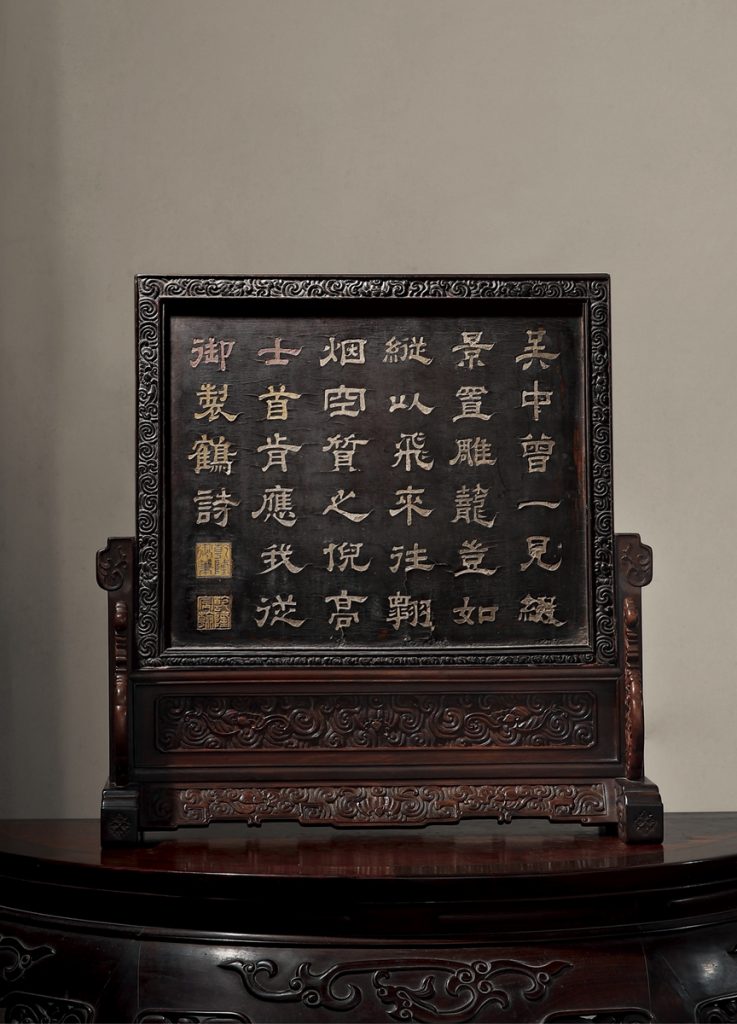
估价RMB: 500,000-800,000
成交价RMB: 805,000(含佣金)
铭文:
1.曲水扁舟送客至,如意松鹤迎祥来。御制诗。
2. 吴中曾一见,缀景置雕笼。岂如纵以飞,来往翱烟空。质之倪高士,首肯应我从。御制鹤诗。钤印:乾隆御笔(白)。乾隆宸翰(朱)。
说明:
此插屏乃乾隆时期宫廷室内陈设的典型代表,当出自清宫造办处能工巧匠之手。插屏不仅刻有苍劲有力的御制诗句,且选料考究,制作精致,肃穆庄重、典雅大方的审美趣味于不经意间流露,颇得皇家风范的真义。插屏以珍贵紫檀木满工攒框,榫卯相合的框架一面浮雕云蝠纹,一面浮雕宝相花纹,刀工细腻,纹理清晰。屏心一面髹黑漆题刻乾隆御制诗一首,布局严谨而有法度,工整庄重,一派皇家气度。乾隆认为纸寿千年,但集天地精华的玉石则永不败毁,因此将自己赞美美好愿景的诗句刻在器物上,得以流芳百世。插屏浅刻隶书御题诗,字迹工整饱满,隶书文字拙朴古雅。此诗句收录于《御制诗四集》,推测此诗作于乾隆四十年至乾隆四十一年,即1775-1776年之间。该诗句咏颂的是承德避暑山庄文园狮子林“石松鹿鹤”四景之一的仙鹤,该插屏亦可能是乾隆晚年陈设于紫禁城或承德避暑山庄的插屏。屏心黑漆发暗,漆表有润光,显得沉默稳重,断纹完整、上下连贯统一。字口附近的漆面可见蛇腹断,是因胎体胀缩所致,这种断纹必须久经年岁才可形成。屏心另一面以黄漆为地,其上以嵌百宝工艺饰松鹤延年图,上嵌白玉、碧玉、青玉、青金石等多种宝石,众妙必备,光彩夺目。画面中心以莹润白玉及碧玉表现仙鹤,惟妙惟肖;以枯樟之木作古松枝干,以碧玉表现松叶,以青金石饰山石,以螺钿雕饰灵芝,以染色虬角饰兰草,巧妙地构成了一副寓意美好的松鹤延年图绘。左上角嵌宝饰御制诗句与画面应和,使观者心神俱佳。整个画面雕琢极为精细,嵌宝材质精致,图饰组合完美,镶嵌工艺讲究,华丽而不失法度。屏座取紫檀为料,绦环板、披水牙均饰以宝相花纹及云蝠纹,与屏框相互辉映,四站牙饰以镂空雕琢螭龙纹,木墩阳起之变体几何形夔纹,装饰效果极佳,器座稳重扎实。
此件插屏屏尺幅较大,表面髹漆厚重,纹饰构图舒朗有致,意境清旷,嵌饰技法娴熟,工艺精湛,极尽奇妙,属清中期难得的装饰艺术珍品。
QIANLONG PERIOD, QING DYNASTY A GEM-INLAID ZITAN TABLE SCREEN WITH CRANE PATTERN AND IMPERIAL INSCRIPTION
带座高:60.8cm 长:59cm 宽:23cm 屏芯长:52cm 宽:42.8cm 厚:3cm
御题诗著录:《御制诗四集》卷三十一之《文园四咏》。
参考:台北故宫:清 白玉小插屏
文物圖檔編號:K1C000155N000000000PAD
朝代:清
類別:玉器
功能:陳設器
質材:礦物/玉石珠寶/玉石
說明文:
白玉,玉色白潤。全器作片狀長方形。以陰刻填金作松鶴圖。另一面有溫承惠隸書御製詩:「御製松鶴清越。仙鶴雙雙舞。蟠龍鬱鬱高。臨風翻雷羽。映曰捲天濤。密蔭留三島。清音上九皋。億齡同獻壽。共慶盛時遭。臣溫承惠敬書。」
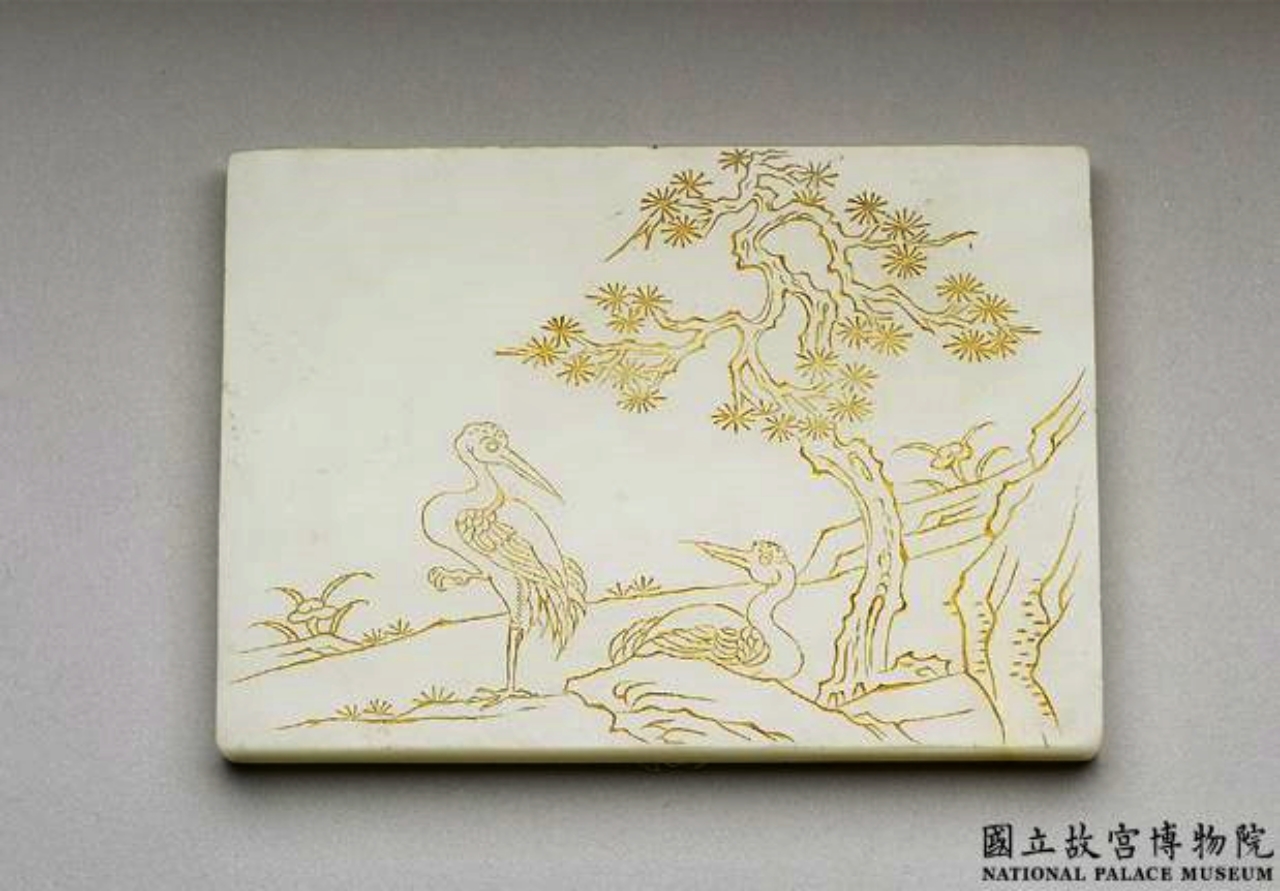
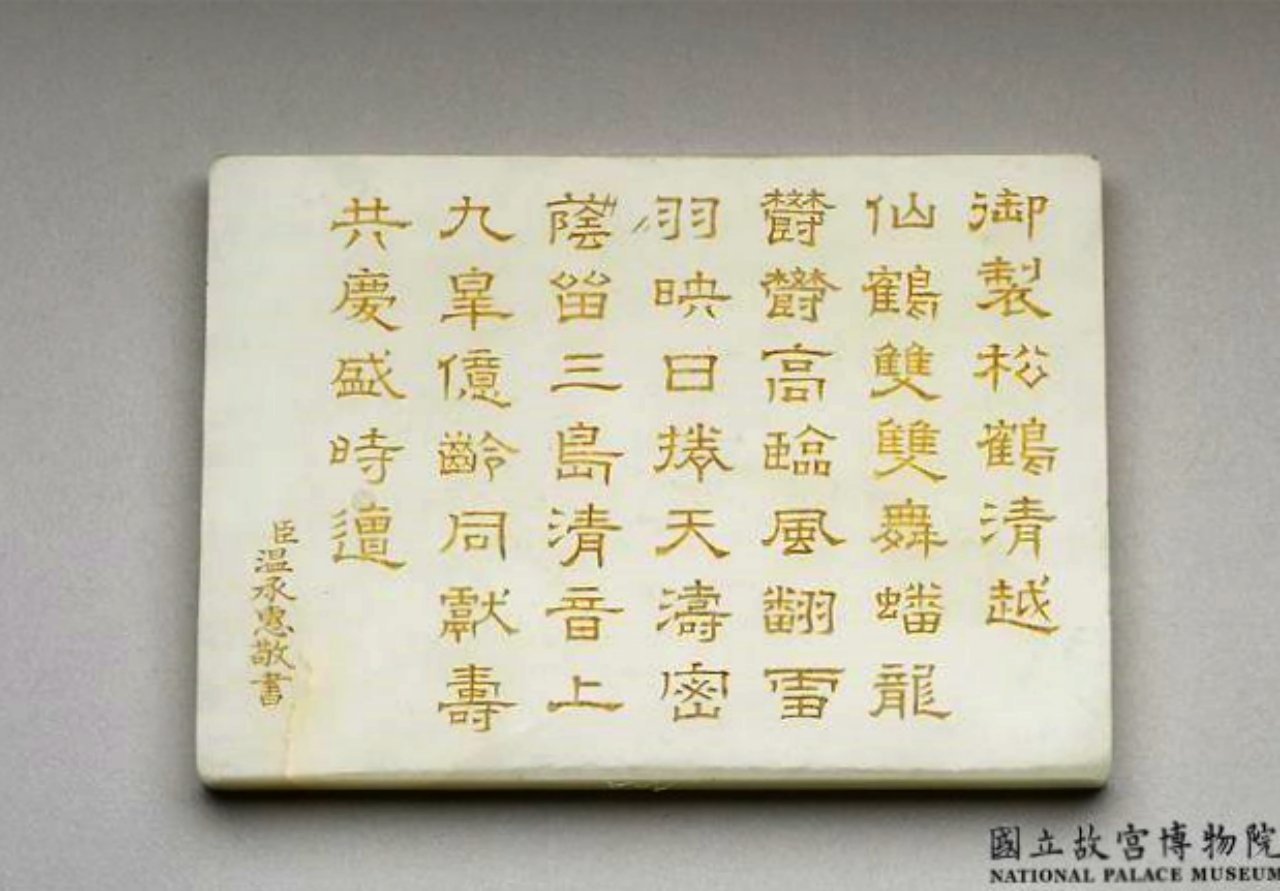
参考:佳士得
14 5月 2012 | 現場拍賣 5305
重要中國瓷器及工藝精品
拍品 10清乾隆 青白玉人物圖圓插屏
A PALE CELADON JADE CIRCULAR TABLE SCREEN
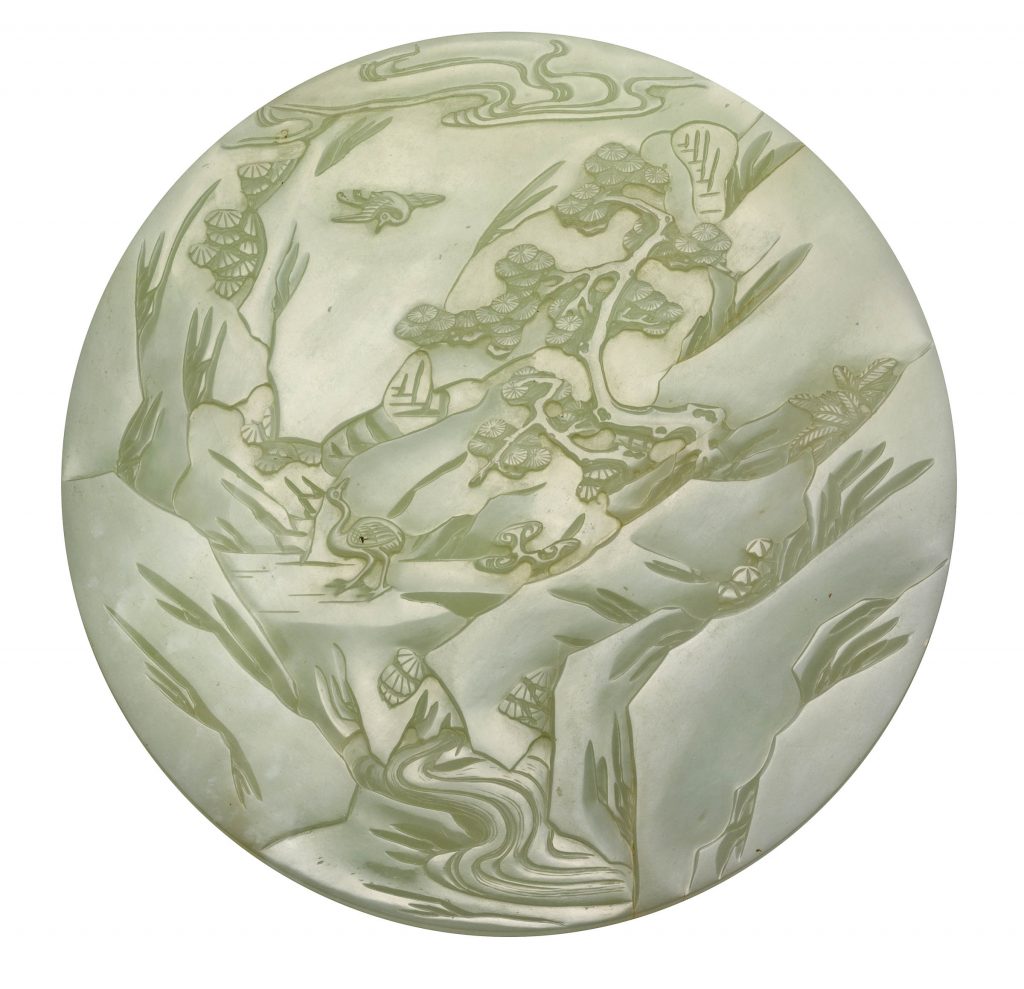
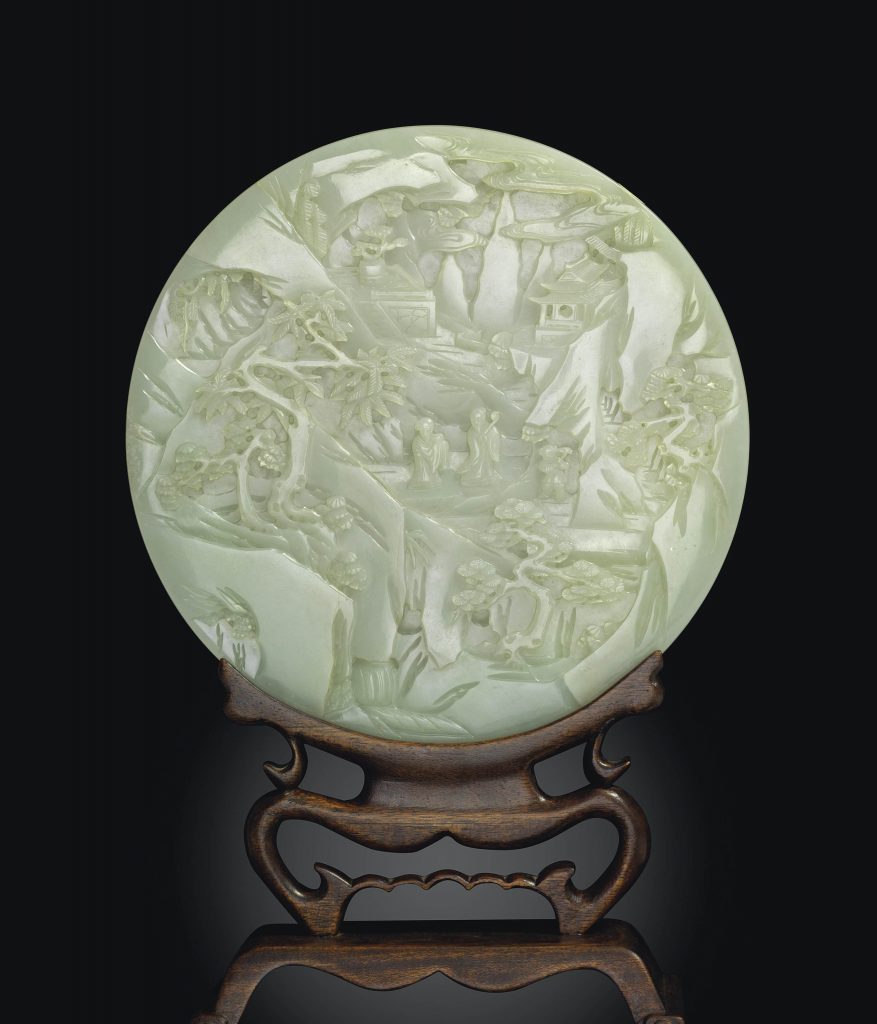
成交價 GBP 97,250
估價 GBP 80,000 – GBP 120,000
清乾隆 青白玉人物圖圓插屏
來源
The Fryers Collection of Chinese Art.
狀況報告
This is in overall good condition.
参考:苏富比
Imperial Cloisonné & Jade: Chinese Art from The Brooklyn Museum
17 March 2021 • 09:00 EDT • New York
拍品 13 清乾隆 碧玉雕溪山觀太極圖圓插屏
Property from the Brooklyn Museum, sold to support museum collections
Qianlong period
A spinach-green jade circular table screen, Qing dynasty, Qianlong period
Guaranteed Property
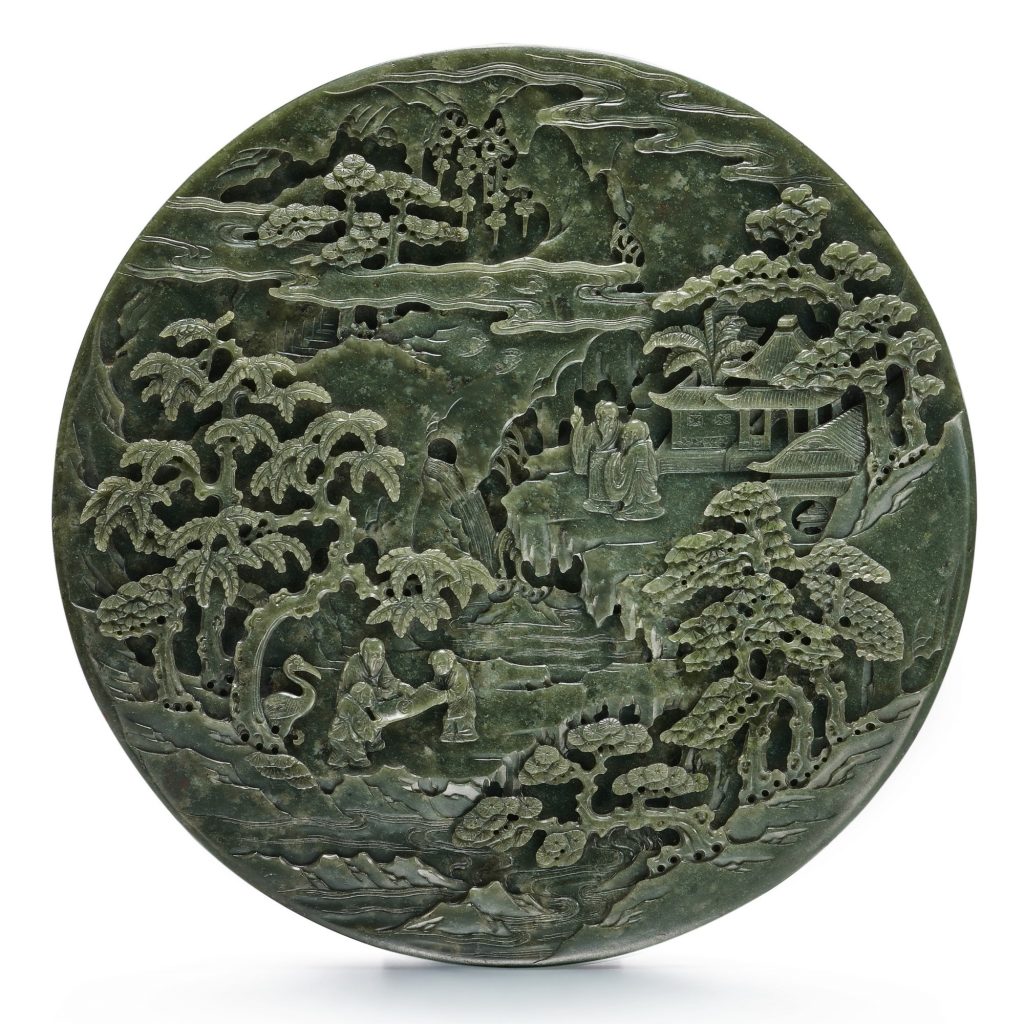
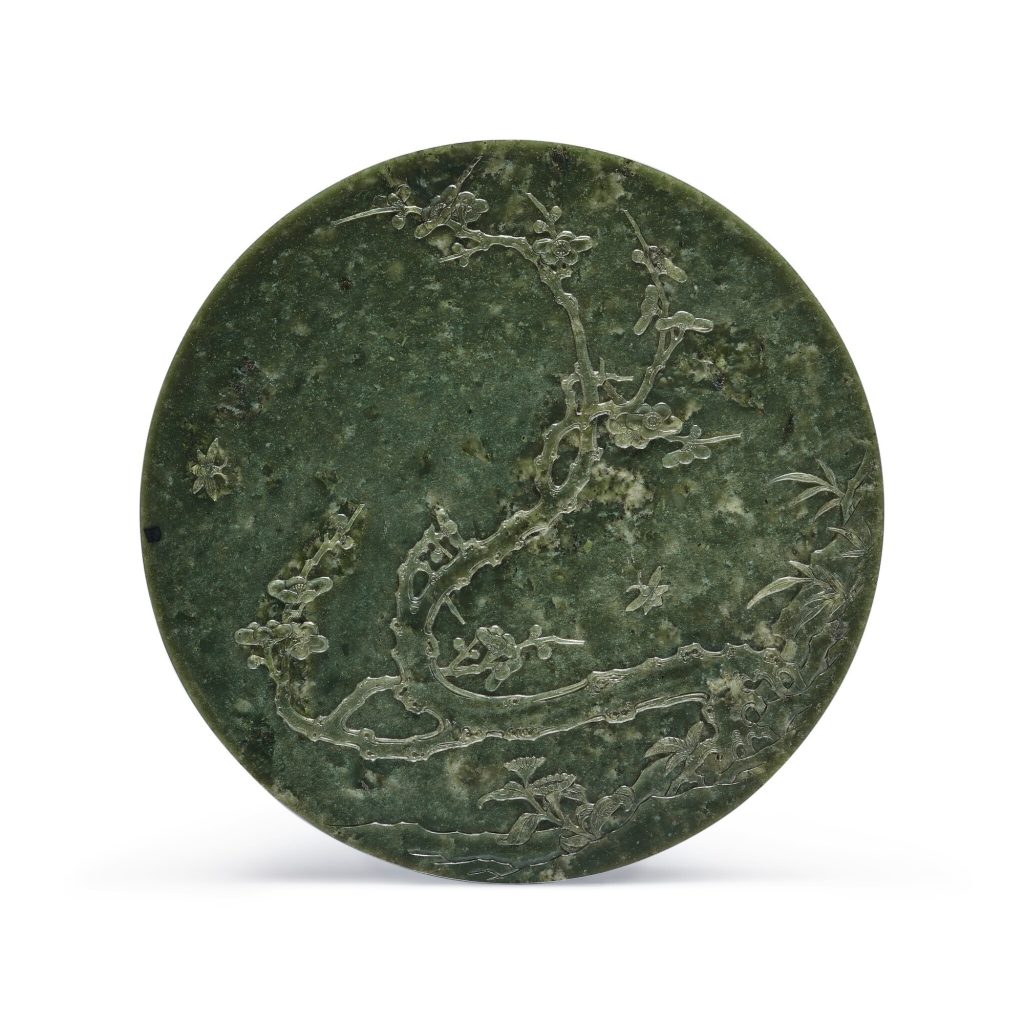
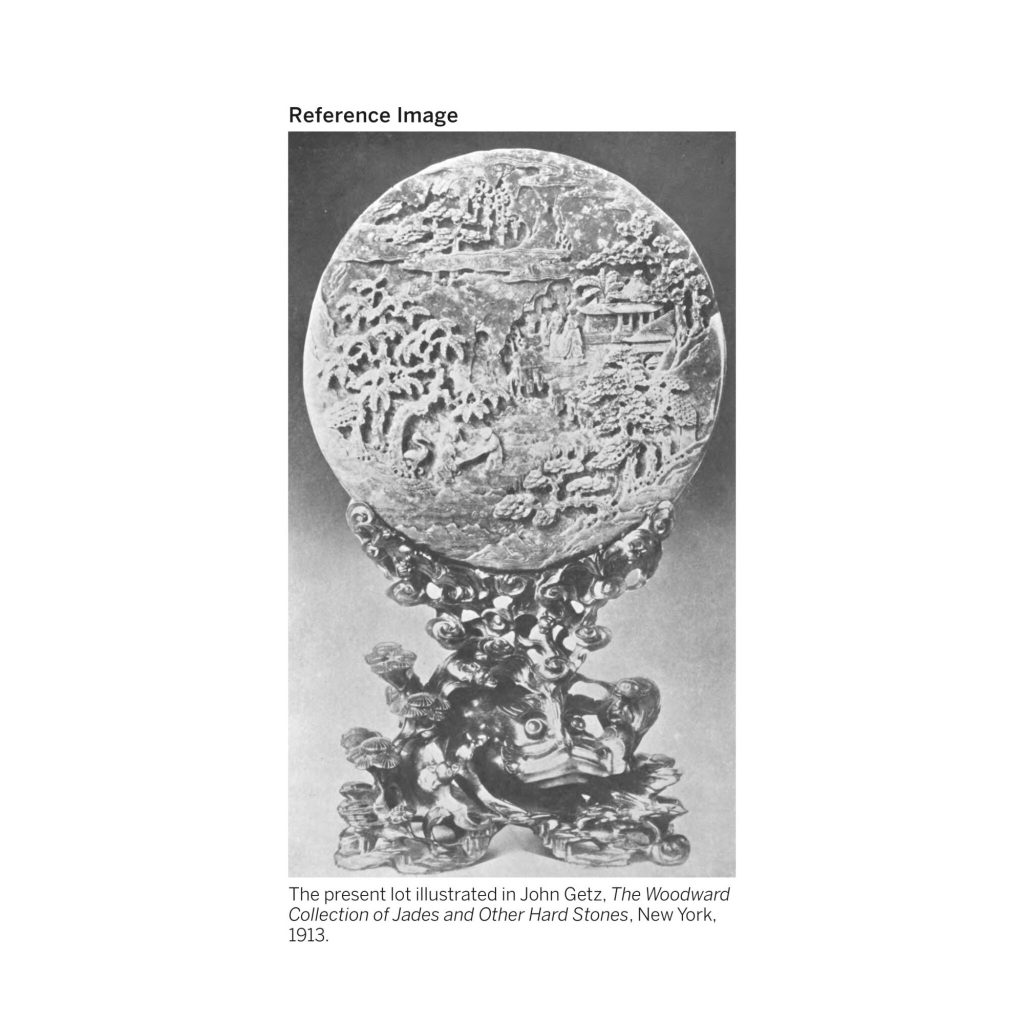
估價:60,000 – 80,000 USD
拍品已售 138,600 USD
詳情
A spinach-green jade circular table screen
Qing dynasty, Qianlong period
清乾隆 碧玉雕溪山觀太極圖圓插屏
finely carved to one side in varying depths of relief with a paradisiacal mountain landscape, the craggy bluffs divided by a river zig-zagging through the composition and pooling in pond below, one overhanging cliff with two elderly scholars conversing near a walled garden, pagoda, and a studio with books visible through the moon window, a lower cliff with a third aged scholar studying a scroll painted with the yin-yang symbol held open by two attendants, a crane strutting nearby, all surrounded by gnarled pines, lofty wutong trees, and other lush vegetation interspersed with swirling clouds, the reverse carved in low relief with a flowering prunus branch growing from rockwork, a pair of insects flying nearby, the stone of even deep green hue
Diameter 9 ⅜ in., 24 cm
狀況報告
Overall in good condition with a few minute nicks to edges. The stone with scattered pale green and black flecks.
整體品相良好,除了邊沿有微磕。料帶淺綠及黑斑點。
來源
Collection of Robert B. Woodward (1840-1915).
Gifted to the Brooklyn Museum, Brooklyn, in 1914 (acc. no. 14.321).
來源
Robert B. Woodward (1840-1915) 收藏
1914年贈予布魯克林博物館,布魯克林 (館藏編號14.321)
出版
John Getz, The Woodward Collection of Jades and Other Hard Stones, New York, 1913, pl. 98.
John Getz,《The Woodward Collection of Jades and Other Hard Stones》,紐約,1913年,圖版98
相關資料
With varying levels of relief expertly carved and finished to a lustrous gloss, the present screen is a superb example of jade workmanship characteristic of the type created in the Imperial Palace during the 18th century. The skill of the carver is evident in the impeccably detailed figures and the vast ethereal landscape.
The Qianlong Emperor advocated that jade mountains and carved panels should carry the spirit of paintings by famous past masters. It is recorded that a number of classical paintings from the Emperor’s own collection were ordered to be reproduced in jade, such as the well-known painting Travelers in the Mountains, by the eminent Five Dynasties painter Guan Tong (907-60). The Gengzhi tu, a set of forty-six paintings illustrating rice and silk culture commissioned by the Kangxi Emperor in 1696, was also recreated and is seen carved on a pair of screens in the Seattle Art Museum, Seattle, illustrated in James C. Y. Watt, Chinese Jades from the Collection of the Seattle Art Museum, Seattle, 1989, pl. 76.
Related screens carved from spinach-green and white jade, as well as apple-green jadeite, are known. Compare a smaller jadeite screen from the Heber R. Bishop Collection carved with a similar landscape, now preserved in the Metropolitan Museum of Art, New York (accession no. 02.18.518); and a spinach-green jade screen sold in our Hong Kong rooms, 8th October 2014, lot 3684. See also a screen with the reverse decorated with prunus and rockwork, sold in our London rooms, 21st October 1974, lot 58. Another with a gilt-bronze and cloisonné stand was exhibited in The Arts of the Ch’ing Dynasty, Oriental Ceramic Society, The Arts Council Gallery, London, 1964, cat. no. 410. See also a pair, with deer traversing a similar landscape, included in the exhibition Three Dynasties of Jade, Indianapolis Museum of Art, Indianapolis, 1971, cat. no. 35.
参考:佳士得
Fine Chinese Ceramics And Works Of Art
08 十月 2013 • 香港
拍賣編號: HK0477
拍品 3042
清乾隆 白玉浮雕「祝壽圖」圓插屏
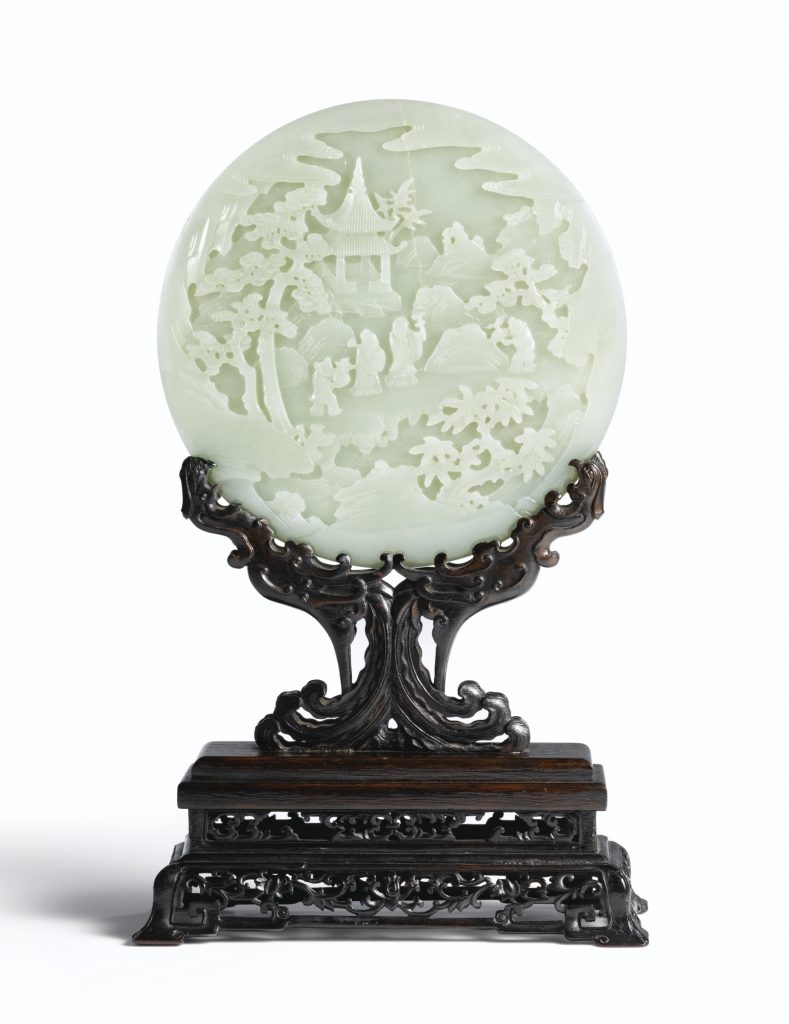
估價 2,500,000 – 3,000,000 HKD
已售出 3,880,000 HKD
描述
porcelain
徑 21公分,8 1/4 英寸
of circular form and slightly concave section, finely carved on the domed side with a scene depicting two scholars conversing outside a pavilion in a rocky garden shaded by pine and wutong, with two attendants carrying flowers approaching from the sides, the scene further framed by rocks and clouds, the reverse centred with a pair of cranes standing in the shallows of a river, with lofty pine trees growing above and a wutong tree overhanging the stream below, all within rocks and clouds around the edge, the softly polished stone of even milky-white colour, on a wood stand carved in openwork with two conjoined phoenix and a reticulated lotus-scroll base
來源
山中商會,紐約
香港蘇富比1989年11月16日,編號640
香港蘇富比2007年10月9日,編號1579
出版
《Collection of Chinese and Other Far Eastern Art assembled by Yamanaka & Company, Inc. now in the process of liquidation under the supervision of the Alien Property Custodian of the United States of America》,山中商會,紐約,1943年,編號1323
拍品資料及來源
乾隆朝之前,因玉料匱乏,如此插屏般大而玉質細白溫潤之玉器非常珍稀。慎選高度淨透玉料用作屏面,強化其紋飾雕刻的層次深度。二面作截然不同之構圖,卻不互擾,反於光線透亮下相互托襯,實為考驗工匠琢玉之藝。屏如此例,使其觀者,宛入靜謐之境,飽遊山水之間。
乾隆帝倡玉插屏、山子須作歷代名家畫意。據記載,他曾命工匠將其御藏古畫,作於玉石之上,如五代山水大家,關仝(907-960)之《關山行旅圖》。此件玉屏呈現出碩大山水與人物間的諧和融洽,正為乾隆帝嚮往之作。
德安堂珍藏相似二例,展於《玉緣:德安堂藏玉》,故宮博物院,北京,2004年,編號25、26。另還有一對,其一出自劍橋哈佛大學 Fogg 美術館,另一則出自 Frederick Knight 收藏,錄於 Robert Kleiner,《Chinese Jades from the Collection of Alan and Simone Hartman》,香港,1996年,圖版123,售於香港佳士得2007年11月27日,編號1511。
参考:佳士得
Fine Chinese Ceramics And Works Of Art
08 十月 2013 • 香港
拍賣編號: HK0477
拍品 3042
清乾隆 白玉浮雕「祝壽圖」圓插屏
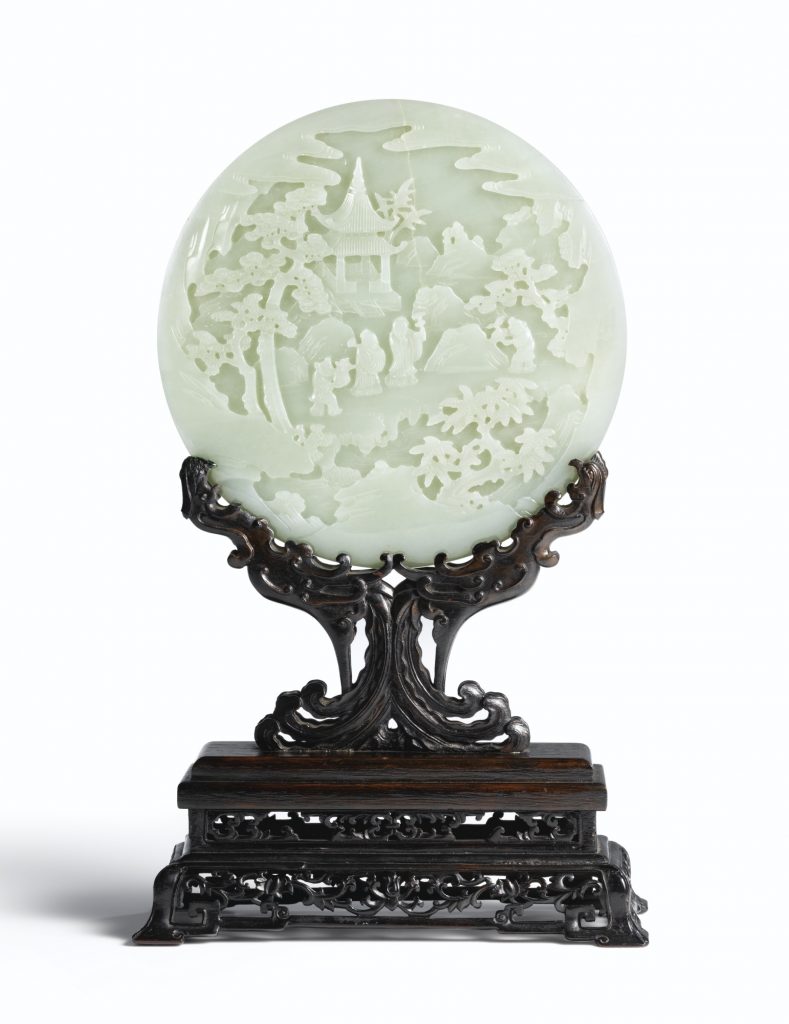
估價 2,500,000 – 3,000,000 HKD
已售出 3,880,000 HKD
描述
porcelain
徑 21公分,8 1/4 英寸
of circular form and slightly concave section, finely carved on the domed side with a scene depicting two scholars conversing outside a pavilion in a rocky garden shaded by pine and wutong, with two attendants carrying flowers approaching from the sides, the scene further framed by rocks and clouds, the reverse centred with a pair of cranes standing in the shallows of a river, with lofty pine trees growing above and a wutong tree overhanging the stream below, all within rocks and clouds around the edge, the softly polished stone of even milky-white colour, on a wood stand carved in openwork with two conjoined phoenix and a reticulated lotus-scroll base
來源
山中商會,紐約
香港蘇富比1989年11月16日,編號640
香港蘇富比2007年10月9日,編號1579
出版
《Collection of Chinese and Other Far Eastern Art assembled by Yamanaka & Company, Inc. now in the process of liquidation under the supervision of the Alien Property Custodian of the United States of America》,山中商會,紐約,1943年,編號1323
拍品資料及來源
乾隆朝之前,因玉料匱乏,如此插屏般大而玉質細白溫潤之玉器非常珍稀。慎選高度淨透玉料用作屏面,強化其紋飾雕刻的層次深度。二面作截然不同之構圖,卻不互擾,反於光線透亮下相互托襯,實為考驗工匠琢玉之藝。屏如此例,使其觀者,宛入靜謐之境,飽遊山水之間。
乾隆帝倡玉插屏、山子須作歷代名家畫意。據記載,他曾命工匠將其御藏古畫,作於玉石之上,如五代山水大家,關仝(907-960)之《關山行旅圖》。此件玉屏呈現出碩大山水與人物間的諧和融洽,正為乾隆帝嚮往之作。
德安堂珍藏相似二例,展於《玉緣:德安堂藏玉》,故宮博物院,北京,2004年,編號25、26。另還有一對,其一出自劍橋哈佛大學 Fogg 美術館,另一則出自 Frederick Knight 收藏,錄於 Robert Kleiner,《Chinese Jades from the Collection of Alan and Simone Hartman》,香港,1996年,圖版123,售於香港佳士得2007年11月27日,編號1511。
参考:东京中央拍卖香港有限公司
2015春季拍卖 2015-05-28
紫禁英华-明清宫廷御物专场
LOT号:0538 清乾隆 白玉雕山水人物图插屏 恭亲王旧藏

拍品信息
尺寸 带台高35cm;直径21cm
估价 HKD 2,000,000-3,000,000
成交价 未提供
出版:
《ILLUSTRATED CATALOGUE OF THEREMARKABLE COLLECTION OF THE IMPERIAL PRINCE KUNG OF CHINA,1913,New York》,山中商会、美国艺术协会(The American art association)编著,纽约,1913,Lot 120
说明
来历:
1.山中商会、美国艺术协会,纽约,1913年2月27-3月1日,Lot120
2.佳士得纽约1999年3月22日,Lot30,见《FINECHINESECERAMICS, PAINTINGS AND WORKS OF ART,22 March 1999,NewYork》
来源:
恭亲王府旧藏、山中商会
此插屏以白玉制成,玉质润而腻,色泽纯而雅。玉屏以长寿为题,雕刻山水、人物、亭台楼阁而可见其画面布局巧妙,雕功细劲遒婉而越显玉之莹润光洁。玉璧中心古树苍松下,一老者手执寿桃作拜寿状,侍童手持双鱼恭敬在侧,一只仙鹤口衔灵芝盘旋于上,尽现灵动之感。如此大雅之作,深藏于恭亲王府内良久,1913年流落纽约,于山中商会暨美国艺术协会(AAA)首次登上拍场(见《ILLUSTRATED CATALOGUE OF TH EREMARKABLE COLLECTION OF THE IMPERIAL PRINCE KUNG OF CHINA,1913,NewYork》),从此纳入私人珍藏当中。
关于恭亲王旧藏拍卖,山中商会于辛亥革命后收购恭亲王府内珍藏,不久便于1913年委托纽约AAA和伦敦佳士得拍卖。山中商会向AAA出品536件拍品(成交额达276262.5美金),同年给伦敦佳士得出品210件(成交额达6255英镑)。
高成交额令业界瞩目,故而这个拍场上的拍品很多都成为了名藏家、美术馆、博物馆收藏,根据这次拍卖的影响,这本图录便被藏家和研究学者当成重要来源之据看待。
1913年的轰动,至今回响仍在藏家心中。此白玉插屏于九十年代曾经易主,今天相距二十多年后再次私人释出,实属难得。今日将踏向何方,请拭目以待。
参考:苏富比
中國藝術珍品
拍品 3663
清乾隆 白玉童子獻瑞圖圓屏 配鏨胎琺瑯座

估價2,000,000 – 3,000,000 HKD
已售出2,500,000 HKD
描述
Description
well worked on one side with three boys carrying stems of millet on a promontory overlooking a lake, with a pavilion amongst trees on a ledge above, the reverse with flowering plants and rockwork, supported on an elaborate gilt-bronze and champlevé enamel stand cast and enamelled with floral and ‘horse-hoof’ motifs, the stand further flanked by a pair of stylised gilt-bronze lotus flanges
参考: 故宫博物院 “普天同庆”清代万寿盛典展
清乾隆(1736~1795年)青玉三星图插屏

通高45.6cm;插屏直径26.4cm;厚1.6cm;
参考:佳士得
26 11月 2007 | 現場拍賣 2388
瑰玉清雕──Alan and Simone Hartman重要玉器珍藏(II)
拍品 1511 清乾隆 白玉桌屏
A MAGNIFICENT PAIR OF WHITE JADE CIRCULAR SCREENS


成交價HKD 18,247,500
估價HKD 6,000,000 – HKD 8,000,000
細節
清乾隆 白玉桌屏
A MAGNIFICENT PAIR OF WHITE JADE CIRCULAR SCREENS
QIANLONG PERIOD (1736-1795)
Each exquisitely carved in shallow relief to depict a mountain landscape scene, the first detailed with two scholars under wutong trees, the mid-distance with two young attendants, both bearing a laden tray, standing on a path leading to a pavilion in the far distance, partially hidden by tall mountains, the reverse with a pair of deer in a landscape scene; the second panel similarly carved with two scholars as if in conversation, whilst at mid-distance a young attendant is standing on a raised terrace platform observing his companion is striking a musical stone, suspended from an arched frame, the reverse side with a pair of cranes in landscape, both screens of semi-translucent even white tone
9 7/8 in. (25 cm.) diam., wood stands (2)
來源
One, the Fogg Art Museum, Harvard University, Cambridge, Massachusetts
The other, Frederick Knight, Amsterdam
展覽
Christie’s New York, 13-26 March 2001
Museum of Fine Arts, Boston, August 2003 – December 2004
拍品專文
As with the large brushpot in this same collection offered as lot 1518, the present pair of circular plaques is one of the finest white jades carvings of the 18th century Qianlong period. The attractive material is finely polished to a soft, glossy sheen. Jade was admired for its tactile quality and as early as the 9th century and Tang dynasty scholars wrote poems praising its clarity and purity, and allegorizing these qualities with the aspirations of men.
The white jade material chosen to fashion these circular panels is highly translucent, and it is jades of this type that are most desirable among comtemporary collectors. One of the most fascinating aspects of these screens, is not only their large size but also their translucency. Even though each panel measures approximately 1cm. in thickness, when light is passed through the stone it enhances the differing depths of the picturesque landscape scene. The viewer is easily transported into a tranquil place of rivers, flowing alongside lofty mountain, and the subtly wispy clouds above that form the frame-like border. The artist has masterfully captured an ethereal vignette where minute figures are seen to be in deep conversations against a backdrop of a vast and idyllic landscape.
Emperor Qianlong particularly advocated that jade mountains and carved panels should carry the spirit of paintings by famous past masters. It is recorded that a number of classical paintings from the Emperor’s own collection were ordered to be reproduced in jades such as the well-known painting entitled, Travellers in the Mountain, by the eminent painter Guan Tong of the Five Dynasties (AD 907-960). Jade landscape carvings of this type was particularly favoured by the Emperor. In one of Qianlong’s poems, as discussed in an essay by Yang Boda, cf. Arts of Asia, ‘Jade: Emperor Ch’ien Lung’s collection in the Palace Museum, Peking’, March-April 1992, the Emperor noted in reference to a jade panel:
‘This piece of precious jade slab is from Khotan. It is unsuitable for making vessels such as the dragon hu and animal Lei. In order to fully utilise it, it is carved into a panel with the scene of “A Riverside City on a Spring Morning”. Imagination is exerted to turn the natural undulation or ruggedness into an appropriate landscape… It takes ten days to carve a tiny bit of water and five days to shape a piece of rock. The crafting is indeed very time-consuming’.
These circular panels are mounted on elaborate wood stands and would have been placed to decorate the side or main tables in the Qing dynasty imperial halls. For a similar example in spinach-green jade see, op. cit., 1991, p. 183, fig. 138.
参考:Bonhams
Fine Chinese Ceramics and Works of Art
4 Jun 2015, 10:30 HKT
Hong Kong, Admiralty
The Property of an English Family
LOT 20 清乾隆 白玉雕松鶴福祿壽圖硯屏
A MAGNIFICENT WHITE JADE DOUBLE-SIDED CIRCULAR SCREEN
Qianlong


Sold for HK$ 3,160,000 (CA$ 505,012) inc. premium
英國家族藏品
A MAGNIFICENT WHITE JADE DOUBLE-SIDED CIRCULAR SCREEN
Qianlong
Crisply carved on one side with a mountain landscape, featuring a pavilion with two boys playing a musical stone within the terraced ground, a scholar accompanied by an attendant approaches the steps leading upwards from the side, two further scholars, one with a peony branch and one holding a ruyi sceptre, accompanied by a boy with a peach branch, standing on a rocky landing, all amidst rocks and pine trees, the reverse with a stag and doe in a mountain landscape with a crane perched on one leg and another in flight, the white stone with a small area of attractive russet inclusions, wood stand.
22cm (8 5/8in) diam. (2).
Footnotes
清乾隆 白玉雕松鶴福祿壽圖硯屏
Provenance 來源:
An English private collection and thence by descent
英國私人舊藏,後由家族繼承
Circular screens such as the present lot are amongst the most prestigious form of jade carvings, requiring an exceptionally large and nearly flawless raw jade boulder for its production. The thick jade disc, up to 1cm at the edge, allowed the carving on both sides to be unusually deep, with the varying depths allowing the natural translucency of the stone to shine through. The crispness of the details contrasts with the smooth areas of the rocky cliffs, perhaps reflecting both the meticulous order and the expansive imagination of the ideal scholar’s mind.
The Qianlong emperor is recorded as having commissioned jade screens to be carved based on paintings from the classical canon. A number of classical paintings from the emperor’s own collection were ordered to be reproduced in jades such as the painting entitled Travellers in the Mountain, by Guan Tong of the Five Dynasties period. The Qianlong emperor’s appreciation of jade ‘landscape’ screens is demonstrated in one of his poems, as discussed in an essay by Yang Boda, Arts of Asia, ‘Jade: Emperor Ch’ien Lung’s Collection in the Palace Museum, Peking’, March-April 1992, which may be translated as follows:
‘This piece of precious jade slab is from Khotan. It is unsuitable for making vessels such as the dragon hu and animal Lei. In order to fully utilise it, it is carved into a panel with the scene of “A Riverside City on a Spring Morning”. Imagination is exerted to turn the natural undulation or ruggedness into an appropriate landscape… It takes ten days to carve with a tiny bit of water and five days to shape a piece of rock. The crafting is indeed very time-consuming’.
Such scenes of scholars and attendants dwarfed by vast mountain landscapes reflect the ideal of a peaceful retirement from public service at the end of a successful career: a dreamlike desire perhaps even more remote from the lifelong service of the emperor. The reverse of the present lot echoes the front in its depiction of remote pines and rocks, whilst the cranes and the stag and doe represent wishes for longevity, and the latter also marital bliss.
Compare a very similarly carved white jade circular screen, Qianlong, illustrated in Christie’s 20 Years in Hong Kong, 2006, p.370, sold at Christie’s Hong Kong on 1 December 2010, lot 3006. See also a white jade circular screen, Qianlong, from the Fogg Art Museum, Cambridge, Massachusetts, similarly carved with two boys ringing a musical stone, illustrated by R.Kleiner, Chinese Jades from the Collection of Alan and Simone Hartman, Hong Kong, 1996, pp.152-153, no.123 (top image, one of a pair) and later sold at Christie’s Hong Kong, 27 November 2007, lot 1511.
See also a pale green jade circular screen, Qianlong mark and of the period, from the Palace Museum, Beijing, illustrated in Noble Virtuosity: Imperial Jades of the Qing Dynasty from the Palace Museum, Macau, 2012, pl.40, similarly carved with a stag and doe. For another white jade circular screen from the Musée National du Château de Fontainenbleau (inv.no. F 1478 C), see M.Crick, Chine Impériale: Splendeurs de la Dynasties Qing (1644-1911), Geneva, 2014, pp.152-153.
白玉泛青,質潤色勻,部份帶有皮色。屏為圓形,正面雕仙山亭台樓閣,福、祿、壽三壽星分別手持靈芝、如意及桃枝行走山間,身後小童跟隨,亭台前有兩小童,一童子手持靈芝,另一童子回首擊磬。屏反面雕松鶴雙鹿圖,寓意長壽吉祥。
雕刻此類圓形硯屏對玉雕工匠的技藝及選材均有極高的要求,工匠需要選用大塊玉質上乘的玉料進行雕琢,此類玉料極其珍貴。此件圓形硯屏玉質柔潤,用料講究,厚度達1厘米,使得玉匠雕刻得以深淺自如,將工藝發揮得淋漓盡致。
此類硯屏為清代宮廷文房陳設,具有類似繪畫的視覺效果,乾隆帝尤其寵愛此類具有「畫意」的玉器,清宮檔案中也曾有記載乾隆帝命宮廷造玉作坊工匠按照宮廷繪畫對玉器進行雕刻,見楊伯達,「北京故宮清宮舊藏乾隆玉器」,刊於《Arts of Asia》,1992年3-4月。
參見一例極為相似的清乾隆白玉雕圓形硯屏,著錄於《香港佳士得20年》,2006年,頁370,後於香港佳士得售出,2010年12月1日,編號3006。另見福格藝術博物館舊藏一例,與本拍品類似,著錄於R.Kleiner,《Chinese Jades from the Collection of Alan and Simone Hartman》,香港,1996年,編號123,後於香港佳士得售出,2007年11月27日,編號1511。
北京故宮博物院藏一件類似的乾隆圓形硯屏,見《君子比德:故宮珍藏清代玉器精品集》,澳門,2012年,圖版40。另見國立楓丹白露宮博物館藏一件白玉雕圓形硯屏(博物館編號F1478C),著錄於M.Crick,《Chine Impériale: Splendeurs de la Dynasties Qing (1644-1911)》,鮑氏基金,日內瓦,2014年,頁152-153。
参考:台北宇珍2021春季拍卖 ——— 御苑风华:
纽约重要金融家珍藏
LOT 208 清乾隆 青白玉仙翁祝寿图插屏暨铜鎏金西番莲纹座





Estimate TWD 10,000,000 ~ 12,000,000
Till auction begin is 44 D 14 H 22 Min
Contact auction house台北宇珍国际艺术有限公司
Size 25×19.3×1.3cm H34.4cm(含座)
Description
来源:伦敦苏富比1982年3月12日编号29
英国重要私人收藏
英国 Roger Keverne 收藏
香港苏富比2016年10月5日编号62
美国纽约金融家 Steven Chen 先生藏品,购自上述来源
插屏呈长矩形,以整块青白玉精心琢制而成,玉质润泽厚实,色纯雅致,晶莹婉约。屏心四周起倭角边框,双面均有精致雕工。正面高浮雕仙翁祝寿之景,画面取仙山一隅,高山耸立,祥云缭绕,亭台矗立岩上,桃树掩映其间,三岔枝上各有饱满的三桃实,树下童子喜笑颜开,双手轻扯桃枝,意趣盈韵,富含吉祥意味。近景苍松挺立,槎桠纷披,沉郁深秀。松荫下一仙翁肩负灵芝,侧身遥指桃树,似引领与鹿同行之南极寿星观望树梢硕桃。松下坡石奇逸,流水潺潺,宁谧闲适。
背面浅浮雕一株梅树于山岩间顺势生长,留白处旷达清幽,仙气萦绕宛如幻境,梅枝旁逸斜出,花瓣层次错落,饱满甜美,彷佛于灵秀山水之中,梅影清香扑面而来,深合文人闲雅温厚之品性。
九桃为传统吉祥题材,是乾隆时期祝寿的经典纹样。桃又称为「寿桃」,《神农本草》:「玉桃服之,长生不死」。「九」、「久」同音,寓有「福寿绵长」吉庆之意。本品画面焦点为桃树一株,瑞果硕结,共生九桃,用意隽永,应为恭贺皇族寿辰或庆祝万寿节之用。
自宋代以降,文人阶层逐渐形成一套雅致的生活方式,以显示自身的独特与优越,如清高宗便身兼「帝王」与「文人」两种角色。今台北国立故宫博物院庋藏画意玉器,清〈玉太平有象插屏〉(图一),其正面以大象寓意「太平有象」,与本品以九桃寓意「福寿绵长」均为吉语寓意,颇具匠心。两者背面同以梅花为主题,梅花凛然风姿与文人傲骨相契,又绽放于冬春盛寒之际,一树独开而天下春,故有「报春花」美称,寓以「迎春报喜」。
插屏底配鎏金錾花座,气势恢弘。基座站牙减地浮雕变形夔龙纹,屏下双层镂雕,绦环板及披水牙子饰西番莲纹,线条流畅华美,添彩增辉。清代的玉插屏一般为玉屏心,多配紫檀木座和边框,鎏金錾花座的插屏于宫中极为罕见。仅见清宫旧藏,北京故宫博物院庋藏清〈青玉填金御制开泰说砚屏〉(图二),即是一例。两者皆以铜鎏金底座錾刻西番莲纹及卷延枝草,弥漫西洋洛可可风,配以精细雕琢画意玉器,东西交融,切合乾隆年间宫廷风尚。细观本品,鎏金镂雕精细的底座布局丰富,曲折承让中,尤显珍贵,当为清乾隆时期宫廷造办处所为,是件磅礡有力之文房案头佳品。
插屏是一种可组装的屏风。宋代开始出现置于几案上或砚台边,用以挡蔽风尘和观赏的小型砚屏。而玉插屏始于东汉,盛行于清代。陈设类的玉插屏多以青玉、白玉、碧玉为材,采用高浮雕、浅浮雕、剔雕、戗金、描金等技法雕琢,表现于平片状的插屏,插于木座或置于玉石器座上,具美观装饰效果。在宫廷和富贵阶层的居室内,广泛地应用插屏装饰,如储秀宫西次间陈设(图三)及法国枫丹白露宫陈设之〈白玉屏〉(图四),其不具实用性,而为重要的室内陈设,置于几案,美化环境,故往往不吝成本,极尽精工之能事。
清乾隆时期,随着玉业兴盛,出现「俗式」、「新样」的玉厄现象,为扼制及扭转此种局面,乾隆皇帝更加大力提倡制作气息高雅的画意玉器,祈藉此将玉业引上古典朴雅之路。玉插屏属画意玉器主要品类之一,山水名胜、文人典故为画意主流,在视觉效果等方面足以媲美绢本或纸本山水画作。如北京颐和园庋藏清乾隆〈白玉松鹤插屏〉(图五),与本品皆为优秀画意玉器佳例。
玉雕插屏除作为清宫重要的室内陈设,亦是常见的文房用具。插屏上雕琢山水情怀之景颇多,观之有无限遐想,亦有怡然雅趣。综观本件插屏,玉色素朴,配以华彩底座,对比鲜明,富丽堂皇。其画面远山近景交相辉映,构图层次清晰,布局严谨而有法度,线条细劲遒婉,颇得文人山水章法。上端雕饰祥云缭绕,烘托悠然恬淡意境,展现幽淡绵远的高人情怀,反映乾隆皇帝对文人士大夫雅致生活的向往,和希冀仁寿康乐之情,实为不可多得的经典佳作。
拍场相似之例可见纽约苏富比 2021 年 3 月 17 日,编号 8,清乾隆〈青白玉雕临泉图插屏〉(图六)底无配座及香港佳士得 2011 年 6 月 1 日,编号 3602,清乾隆〈白玉婴戏图插屏〉(图七)底配木座和边框。本品出自 1982 年伦敦苏富比,由英国重要古董商 Roger Keverne 拍得,并配以珍藏许久的鎏金錾西番莲纹座,和谐地与传统中国吉祥纹饰融合,又显露出西洋的华丽多姿,完美衬托莹泽秀美之画意玉器,于柔美中流露雅致富贵,兼以九桃寓意「福寿绵长」祝贺皇室寿辰之吉祥寓意,更为珍稀。此屏之后现身 2016 年香港苏富比,由美国纽约金融家 Steven Chen 先生珍藏,流传有序,实属难得之宫廷陈设精品。
AN EXCEPTIONAL AND FINE PALE CELADON JADE ‘IMMORTALS AND LANDSCAPE’ TABLE SCREEN WITH ORIGINAL GILT-BRONZE STAND
QING DYNASTY, QIANLONG PERIOD
PROVENANCE:
Sotheby’s London, 12 March 1982, lot 29
An important British private collection
Roger Keverne
Sotheby’s Hong Kong, 5 October 2016, lot 62
New York financier Steven Chen, acquired from the above
参考: 苏富比
利國偉爵士藏重要中國藝術珍品
拍品 133
清十八世紀 白玉三星觀太極圖屏
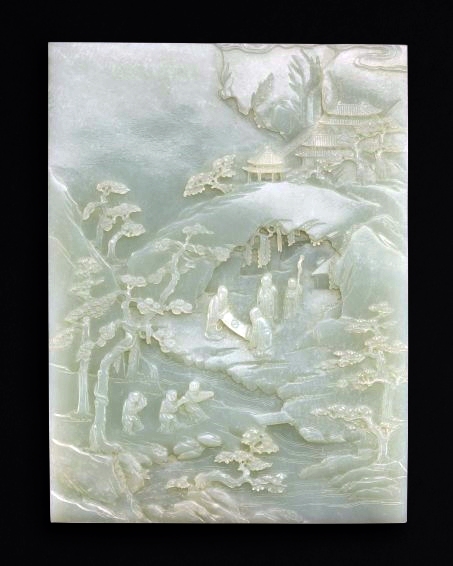
估價600,000 – 800,000 HKD
已售出2,750,000 HKD
参考:春季拍卖会
北京保利十二周年春季拍卖会
宫廷艺术与重要瓷器、玉器、工艺品
5900 清中期 白玉仙人鹿鹤圆形插屏 (一对)

拍品信息
尺寸 直径21cm
估价 750,000-950,000
成交价 RMB 920,000
此对插屏以整块白玉雕琢而成。圆形,扁体,双面以浅浮雕手法雕刻仙人祝寿、鹤鹿同春图。一面仙人祝寿图依山水画之理,仙山云环雾绕,茂林修竹,怪石嶙峋。众仙人手执仙杖灵芝,且行且谈,怡然自得。远处亭台仙阁巍峨高耸,隐隐现于云山之间。又有小童分别抬送寿桃、灵芝等祥瑞之物,伶俐喜人。画面远近高低,疏密有致,层次分明,甚有章法。所雕画面既有云山寒林之高远画意,又有仙瑞云集之盛景,再加之以浮雕手法表现,凹凸有致,立体似实景再现。 插屏另一面雕刻仙鹤与灵鹿为主题纹饰。取山间一隅为景,其上仙鹤引颈顾盼,矫健瑞秀。又有一双仙鹿,悠游于仙山玉泉之中,灵动传神。《淮南子•说林训》中载:“鹤寿千年,以报其游”,以仙鹤为饰,素有“鹤寿万年”之意。仙鹤与灵鹿相互呼应,以表“鹤鹿同春”。
插屏, 案几摆设之一,亦为清宫重要陈设品。乾隆帝爱玉成痴,故其时之玉器生产攀至顶峰。取奇巧之造型,华丽之纹饰,做工细致且取意吉祥者,于当时社会可谓“时样”,颇受推崇与喜爱。此对插屏体量厚重,用料奢侈,玉质温厚柔润,宝光内藴,包浆润泽,色纯而质雅。雕工精细,线条流畅,细劲遒蜿。尺幅之地运筹帷幄,极尽文人寄情山水之意趣,又不失长寿多福之吉祥寓意。玉制插屏下配紫檀圆底座,通体镂空如意云纹,纹饰繁缛,细节打磨光润。放置于案,清雅而不失高洁,实为清代宫廷陈设不可多得之佳作。
备注:美国藏家旧藏
参考:北京大羿拍卖有限公司
2018年秋季拍卖会2018-11-20
中国骨董
LOT号: 0745 清乾隆 白玉仙翁祝寿图插屏
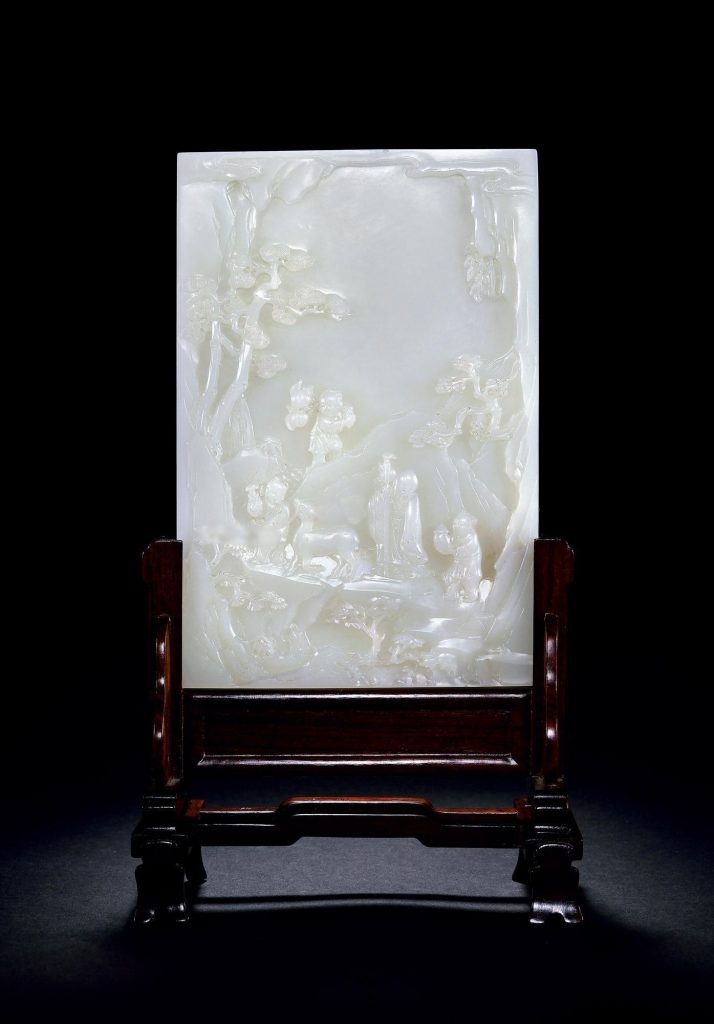
估价 RMB 900,000-1,200,000
成交价 RMB 1,035,000HKD 1,166,855USD 155,250EUR 113,850
说明
记录:纽约苏富比,2013年3月19日,Lot280。
尺寸 带座高28.5cm
来源:Palo Alto旧藏
乾隆朝之前,因玉料匮乏,如此插屏般大而玉质细白温润之玉器非常珍稀。慎选高度净透玉料用作屏面,强化其纹饰雕刻的层次深度。本品以白玉为材,玉质绵密温厚,莹润细腻。全器作长方形,配素面木座。其上以高浮雕手法雕琢寿星童子图。取山间一隅为景,石上松柏灵芝,祥云缭绕,寿星与三小童悠游其间。小童状貌调皮可爱,如同膝下顽孙,赋予这仙家之景几许鲜亮浓郁的生活气息。乾隆帝倡玉插屏、山子须作历代名家画意。据记载,他曾命工匠将其御藏古画,作于玉石之上,如五代山水大家,关仝(907-960)之《关山行旅图》。此件玉屏呈现出硕大山水与人物间的谐和融洽,正为乾隆帝向往之作。
《楚辞·九歌·湘夫人》有云:“白玉兮为镇,疏石兰兮为芳。”此插牌所用白玉质地细腻滋润,纯净温雅,白如割脂,孔子认为“玉温润而泽,仁也;缜密以栗,知也;廉而不刿,义也;垂直如队,礼也;叩之,其声清越悠长,其中诎然,乐也;瑕不掩瑜,瑜不掩瑕,忠也;孚尹旁达,信也;气如白虹,天也;精神见于山川,地也;圭璋特达,德也;天下莫不贵者,道也。” 正是因为孔子以儒家的信条对玉作出了诠释,随之成为后世琢玉、赏玉、佩玉的品评尺衡,极大地激发了玉器的“世俗”生命力,由此以后的两千年间,玉文化在中华大地上薪火相传。相似拍品见香港苏富比2016年10月5日拍过一只乾隆青白玉仙人贺寿插屏(Lot0062),成交价248万港币。
参考:清乾隆 青白玉刻人物纹(携琴访友)桌屏
朝代:清 (公元 1636 年-公元 1912 年)
博物馆:私人收藏
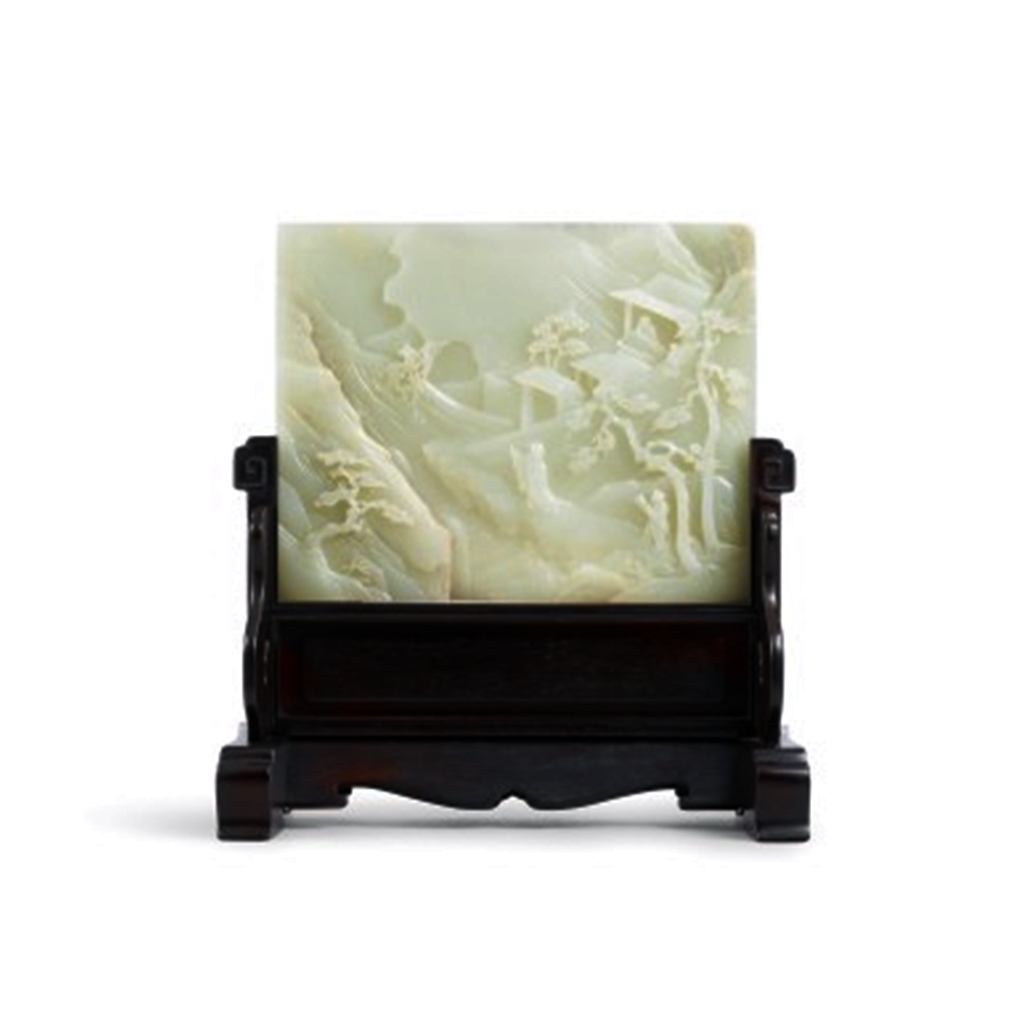


「携琴访友」,以春秋时伯牙与锺子期的故事为蓝本,历代相传,为文人雅士锺爱的题材。伯牙琴技高超,樵夫锺子期善听琴,从伯牙琴声中悟出他的心意,成为知音好友。 桌屏为青白玉雕刻,浮雕园林,青松,流水,浅雕梅竹。山道上有老人,琴童。雕工精细,工艺娴熟流畅。
参考:台湾宇珍國際藝術有限公司
2016春季拍賣重要中國瓷雜工藝精品
2016年04月30日(星期六)
266清 白玉山水人物插屏一對



TWD3,500,000-5,000,000
拍品簡述
對屏呈圓形,白玉質,通體緻密溫潤,色澤瑩亮,局部帶有褐色沁。屏心兩面紋飾採多層浮雕技法琢刻,雙屏正面以得道仙遊的圖案為主題,山勢崎嶇,岩石挺拔嶙峋,松樹枝幹彎曲遒勁,枝葉繁茂,蔚然成峰,二高士於山徑翠柏間論道,旁岩盤上二仙童捧一籃壽桃作歡愉之姿。畫面寧靜優美,呈現山林仙閣間的靜謐恬淡,彷彿置身於仙境,予人深感喜慶祥瑞之氣氛。
對屏背面為雙鹿賀歲及松鶴延年的連續圖案為主題,雕琢山石嶙峋峻峭,蒼松虯立,山澗溪流淙淙,崎嶇山道上,飾以雙鹿,一作回首,一作俯臥之姿;另飾雙鶴,一低空飛翔,一回首仰望之姿。雙屏皆作對視狀,畫面景色安閒靜謐,遠處雲煙重巒,盡收千里之景於尺幅之中。
插屏是種可組裝的屏風,宋代開始出現置於几案上或硯台邊,用以擋蔽風塵和觀賞之器,屬文房用品。至清代,硯屏結構上是屏心與屏座分開、可組合安裝,亦稱為「插屏」,一般為玉屏心,配木邊框和木座。本對插屏取材碩大規正,畫面構圖豐滿,呼應有序,山水布局錯落有致,意境曠遠清雅。下承雙層紅木座,為透雕雲紋及纏枝如意紋足底座,可謂匠心之獨具。
参考:苏富比
2017纽约亚洲艺术周秋季拍卖会
中国艺术珍品
Important Chinese Art /
拍品 42
清十八世紀 碧玉雕老子出關圖插屏

估價 200,000 – 300,000 USD
已售出 250,000 USD
描述
crisply carved to both sides with mountain bluffs hosting pines, waterfalls, and wisps of clouds, one side with a section of the Great Wall spanning a high ravine, the philosopher Laozi riding a water buffalo toward the frontier official Yin Xi, each accompanied by attendants, the reverse with two stags by a pavilion, the stone of deep green in varying tonalities, wood stand (2)
参考:苏富比
纽约亚洲艺术周秋季拍卖会 ——— 中国艺术珍品
2017年9月8日—13日
Important Chinese Art
拍品 37
清乾隆 白玉雕溪山謐閣圖圓插屏
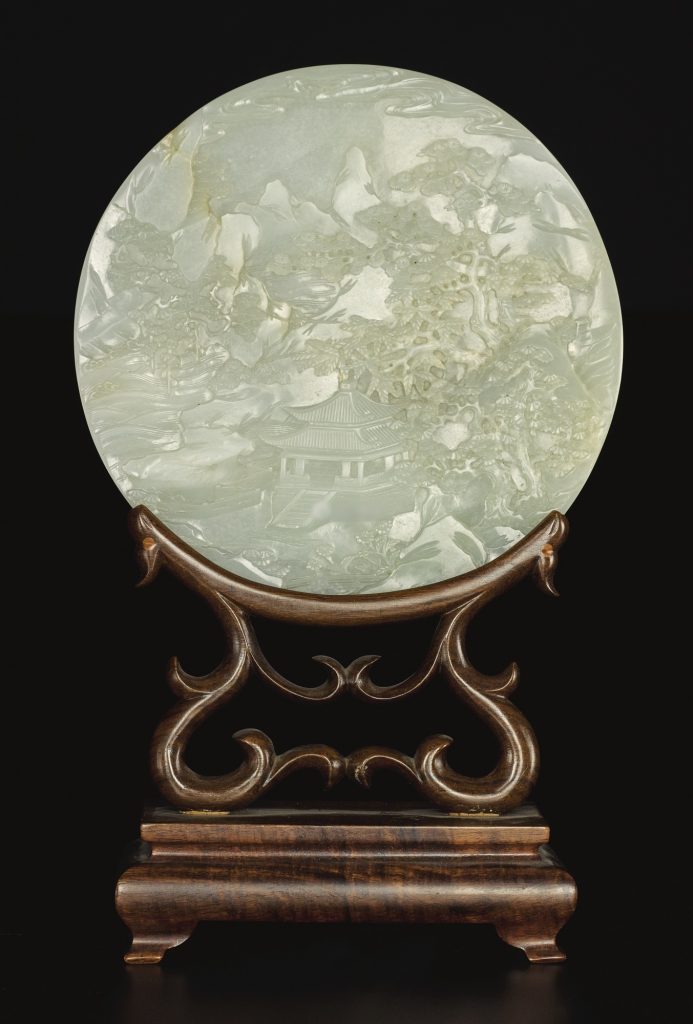


估價 30,000 – 50,000 USD
已售出 68,750 USD
描述
後刻題識:
良玉五寸 遇員成璧 君子之器 無玷無缺
孝廉明經 庭階並列 山水方滋 圭璋特達
玉如三兄大人雅正 弟周蘭銘
印文:伯蓀
参考:苏富比
香港 2018-10-03
香港李国维爵士的重要中国艺术
Lot 102
清乾隆 白玉浮雕群仙祝寿图圆插屏 连掐丝珐琅花卉纹座
A WHITE JADE IMMORTAL TABLE SCREEN WITHITS ORIGINAL CLOISONNE AND CHAMPLEVE ENAMEL STAND
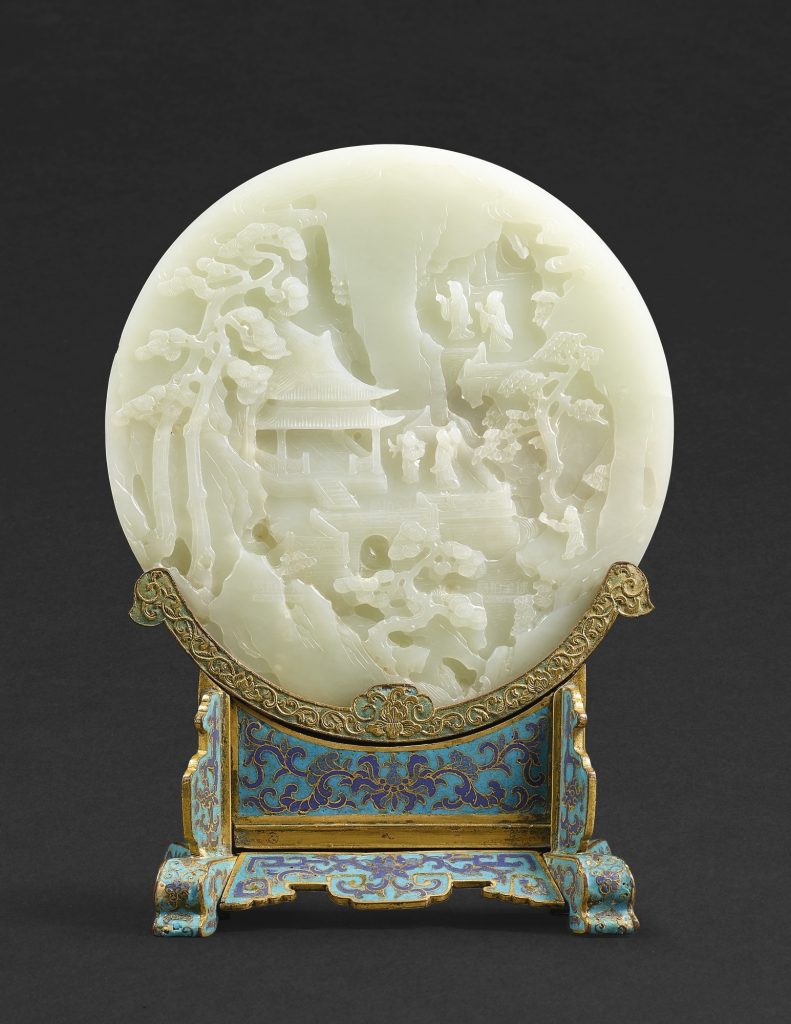

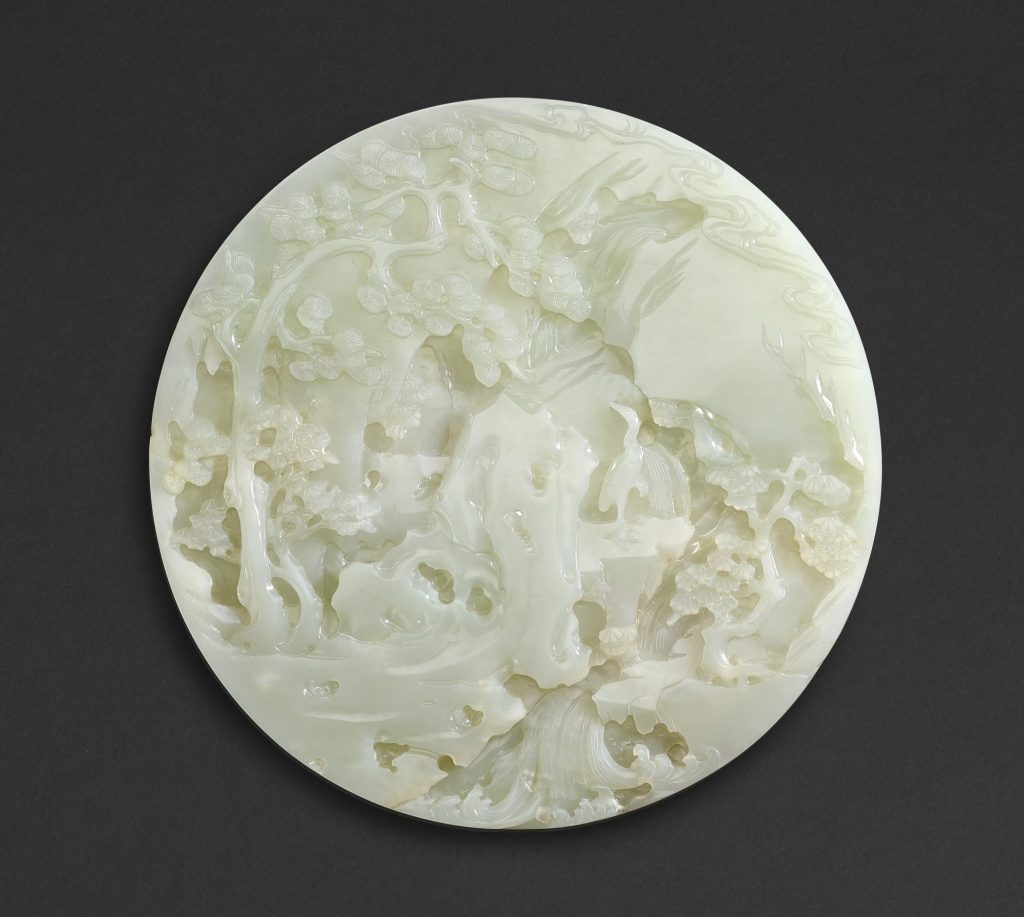
估价 HKD 600,000-800,000
约折合人民币:499,740-666,320
清乾隆 白玉浮雕群仙祝寿图圆插屏 连掐丝珐琅花卉纹座 A WHITE JADE IMMORTAL TABLE SCREEN WITHITS ORIGINAL CLOISONNE AND CHAMPLEVE ENAMEL STAND
屏 19.4 公分,7 5/8 英寸总高 26.3 公分,10 3/8 英寸
白玉质,圆型片状,以深浅浮雕、阴刻等多种技法雕琢纹饰。屏心苍松参天,梧桐映掩,流水淙淙,山石嶙峋,祥云莹绕,仙家童子谈笑风生,游弋于山林仙境之中;背面飞瀑由山上而下,一羽仙鹤挺立其中。纹饰画面彷如展开的画卷,意境平和,令人向往。 乾隆皇帝提倡文化,自视为文人领袖,认为玉制插屏、笔筒、山子等器物,应承传古代名家书画遗风。因此,下旨将多幅御藏书画,雕琢成器,并列陈设,趣意盎然。
of circular form, deftly carved in various levels of relief, one face depicting an immortalholding a peach looking backwards at his attendant carrying a floral spray, before an elaborate pavilion sheltered amongst pine trees in a rocky landscape by a flowing river, opposite two further immortals in a fenced garden on the right, above another attendant holding a ruyi sceptre on a rocky ledge under a wutong tree, the reverse depicting a crane with its head turned sharply backwards, standing on cragged rocks in a landscape with pine, wutong and a waterfall, the stone of an even white tone, the cloisonné and champlevé enamel stand decorated with stylised blue lotus sprays flanked by kui dragons against a turquoise groundscreen 19.4 cm, 7 5/8 in.overall h. 26.3 cm, 10 3/8 in.
The present white jade circular table screen is finely carved in various levels of relief. Depicted on one side arethreeimmortals andan attendant conversing under a large overhanging pine, in a rural landscape replete with wutong trees and a stream, all within rocks and clouds around the edges; centred on the reverse is a crane standing in a cascading waterfall. Such idyllic scenes, as if unfolding like a painting, transport the viewer to a state of tranquillity and harmony, and provide a momentary escape from mundane, daily duties. Considering himself a great patron and connoisseur of the arts, the Qianlong Emperor advocated that jade carved panels, brushpots and mountains should carry the spirit of paintings by famous past masters. It is recorded that a number of classical paintings from the Emperors own collection was ordered to be reproduced in jade. The sense of harmony between the figures and the vast landscape in this screen is an exemplary demonstration of the Emperors vision.
参考:佳士得
28 5月 2019 | 现场拍卖 18336
浮生闲趣
拍品 3039 清十八世紀 白玉賀壽圖圓屏
THE PROPERTY OF A LADY
A WHITE JADE CIRCULAR SCREEN
QING DYNASTY, 18TH CENTURY

QING DYNASTY, 18TH CENTURY

QING DYNASTY, 18TH CENTURY

QING DYNASTY, 18TH CENTURY
成交价HKD 1,375,000
估价HKD 1,000,000 – HKD 1,500,000
细节
A WHITE JADE CIRCULAR SCREEN
QING DYNASTY, 18TH CENTURY
前面饰刻博意雕山水风景图,两位学仕在梧桐树下对话,不远处两位小童旁立,并击磬助兴。
背面饰刻鹿鹤山水松石,峻岭高山。
The screen is exquisitely carved to one side in shallow relief with a landscape scene, detailed with two scholars in conversation under wutong trees, in the mid-distance with a young attendant observing his companion striking a musical stone that is suspended from an arched frame. The reverse is decorated with a pair of deer and a crane amongst pine in a landscape of jagged rocks and tall mountains.
8 ½ in. (22 cm.) diam., rosewood stand
来源
Sold at Christie’s Hong Kong, 27 May 2008, lot 1971
状况报告
-整體品相良好,邊角有些許微磕,屬正常現象
参考:佳士得
28 5月 2019 | 现场拍卖 18336
浮生闲趣 郭克禮珍藏
拍品 3016
清乾隆 青白玉描金御題詩竹林山泉圖插屏 「乾隆御筆」篆書款
PROPERTY FROM THE QUEK KIOK LEE COLLECTION
AN IMPERIALLY INSCRIBED AND GILT PALE CELADON JADE TABLE SCREEN
QIANLONG PERIOD (1736-1796)
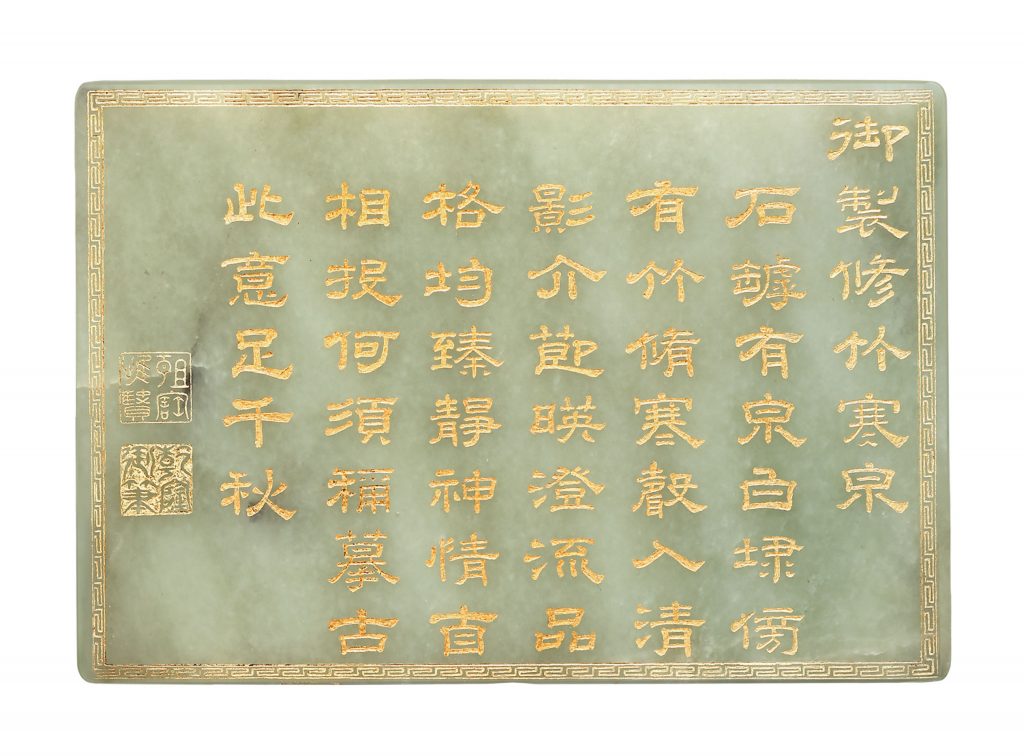
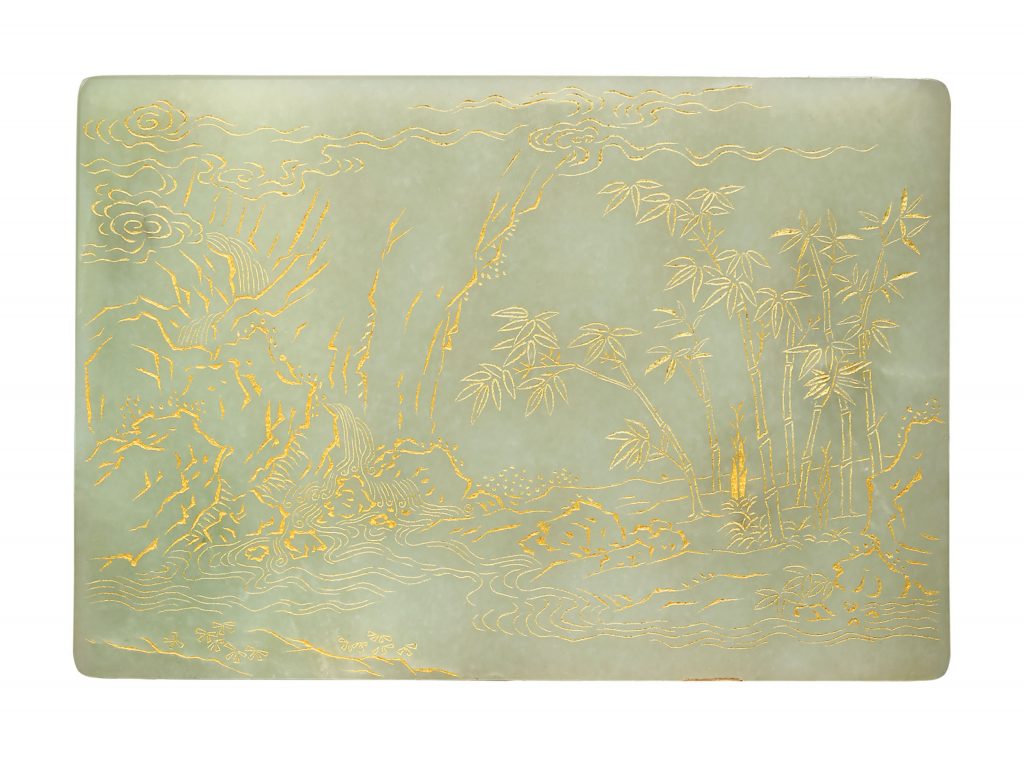
成交价HKD 1,000,000
估价HKD 400,000 – HKD 600,000
清乾隆 青白玉描金御題詩竹林山泉圖插屏
AN IMPERIALLY INSCRIBED AND GILT PALE CELADON JADE TABLE SCREEN
QIANLONG PERIOD (1736-1796)
「乾隆御筆」篆書款
細節
玉屏一面陰刻描金題詩,詩云:「石罅有泉白,埭傍有竹修;寒聲入清影,介節暎澄流。品格均臻靜,神情自相投;何須稱摹古,此意足千秋。」出自《乾隆御製鑒賞名畫題詩錄·卷九十三·題王翬摹古十二幀·修竹寒泉》。末端鈐印:「所寶惟賢」及「乾隆御筆」。
The plaque is incised and gilt-decorated on one side with a stream running through a bamboo grove. The reverse is inscribed and gilt with an Imperial poem bearing the title, Yuti zhulin shanquan tu, ‘Inscribed by Imperial Command, bamboo grove by a river’, followed by the seals Suobao Weixian, ‘To recognise these as treasures of a wise man’, and Qianlong Yubi, ‘Imperially inscribed by the Qianlong Emperor’. All are framed within key-fret borders. The stone is of pale celadon tone with areas of inclusions, some of which are cleverly utilized to depict water ripples.
Jade plaque: 6 1/8 x 4 ¼ in. (15.7×10.8 cm.) wide
來源
郭克禮珍藏
状况报告
We have sought to record changes in the condition of this piece acquired after its initial manufacture.
-There are minor nicks and chips to the edges and extremities, some are associated with the fissures.
-There is minor wear to the gilding as can be expected.
参考:The Cleveland Museum of Art
Table Screen 1736-1795
Part of a set.
China, Qing dynasty (1644-1911), Qianlong reign
(1736-1795)
Jade



Overall: 15.9 cm (6 1/4 in.)
Anonymous Memorial Gift 1941.595.2
Collection: China – Qing Dynasty
Department: Chinese Art
Type of artwork: Jade
Medium: Jade
Credit line: Anonymous Memorial Gift
参考:佳士得
25 11月 2014 | 现场拍卖 3371
重要中国瓷器及工艺精品
拍品 3354
Important Chinese Ceramics and Works of Art
A RARE CARVED PALE CELADON JADE CIRCULAR TABLE SCREEN
QING DYNASTY, 18TH-19TH CENTURY
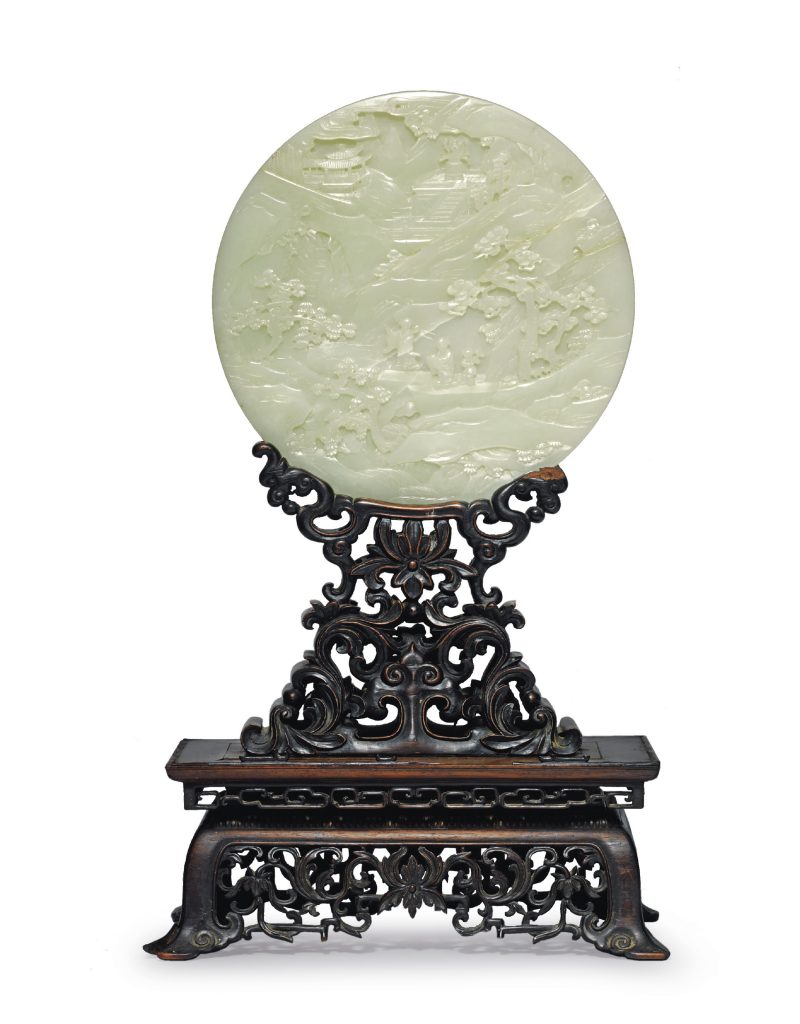
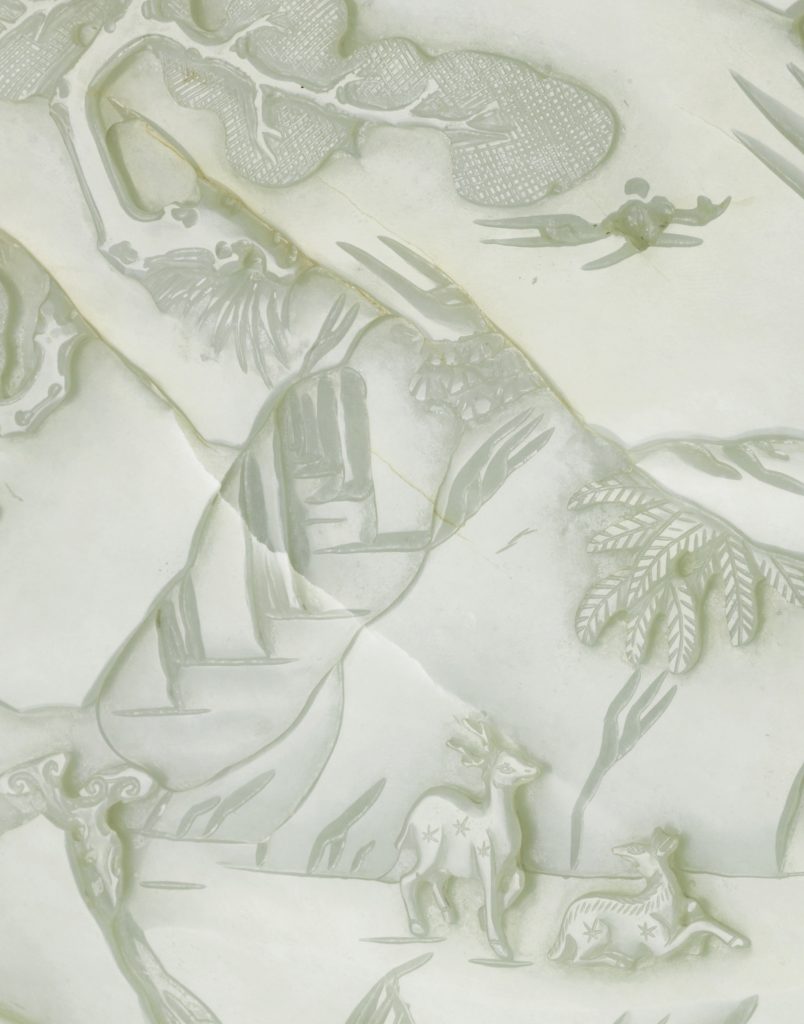
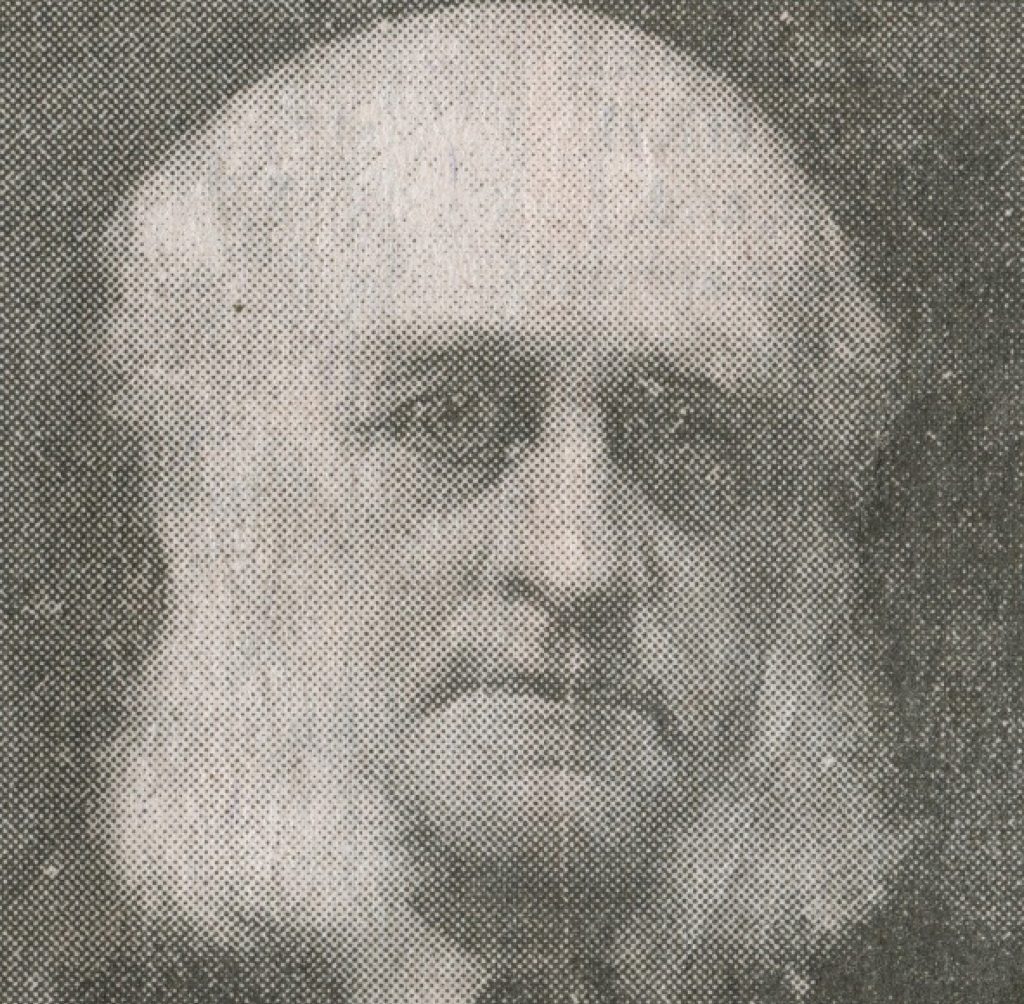
THE CLEVERLY JADE TABLE SCREEN In March 1843, the 24-year-old Charles St George Cleverly (1819-1897), a newly qualified architect and surveyor from County Cork in Ireland, boarded the Emma in Portsmouth and embarked on a five-month-long sea voyage to Hong Kong. Here Cleverly worked as the second Surveyor General of Hong Kong from 1846 to 1865, when he directed the design and construction of many private and public buildings, drainage systems and road structures. Many of these buildings remain as important landmarks in the city today. The most famous monument that was erected under Cleverly’s supervision is perhaps Government House, which took four years to complete starting from 1851. Sir John Bowring, the fourth Governor of Hong Kong (1854-1859), was Government House’s first resident in October 1855. Twenty-five of Hong Kong’s twenty-eight colonial Governors lived in this building, and it is where the Chief Executive of Hong Kong officially resides today. Apart from Government House, Cleverly also spearheaded the construction of the prominent St. John’s Cathedral in 1849, Zetland Hall in 1853 and Old Stanley Police Station in 1859. As a determined and dedicated leader, Cleverly fought tirelessly for government funds for his projects and never compromised on quality when the budget was tight. He learnt Cantonese in order to communicate better with his Chinese workforce, and paid his men out of his own pocket when their wages were not given to them on time. The current magnificent jade screen was acquired by Cleverly during his stay in Hong Kong, probably gifted to him as a token of appreciation for all his outstanding contributions to the island. On May 17, 1997, the Weekend Telegraph published a memoir dedicated to him, written by Cleverly’s great-grandson Charles Peter Cleverly, entitled ‘My Ancestor Built Hong Kong’. ‘Cleverly Street’ in Sheung Wan, Hong Kong, is still named after this remarkable architect.
Price realised HKD 4,600,000
Estimate HKD 1,000,000 – HKD 1,500,000
Details
A RARE CARVED PALE CELADON JADE CIRCULAR TABLE SCREEN
QING DYNASTY, 18TH-19TH CENTURY
The front of the table screen is exquisitely carved with a mythical rocky landscape scene, depicting two bearded immortals accompanied by a young boy attendant walking through tall pine and wutong trees to reach a pavilion visible in the far distance. The reverse is decorated with two deer resting in a grotto beside a lingzhi spray and above a flowing river. The stone is of a pale celadon tone with some lighter inclusions.
9 1/2 in. (24 cm.) diam., wood stand
Provenance
Charles St. George Cleverly (1819-1897), thence by descent to the current owners
Condition report
We have sought to record changes in the condition of this piece acquired after its initial manufacture.
– In good overall condition, with the exception of a few minute nicks to the rims and extremities of the relief carving as can be expected.
Lot Essay
The present circular jade plaque is impressive for its large size as well as the thickness of the material, which measures just over 1 cm. The lapidary artist skillfully created idealistic landscape scenes from the natural stone, transporting the viewer into a tranquil place with flowing rivers, craggy rocks and tall trees. Table screens were important decorative objects for the scholar’s studio during the Qing dynasty, with the more precious ones matched with elaborate wood frames or stands. During the Qianlong period (1736-1795), the emperor encouraged jade craftsmen to obtain inspiration from famous classical paintings. It is known that a number of paintings from the Emperor’s own collection were ordered to be reproduced in jades, such as the famous painting entitled, Travellers in the Mountain, by the eminent painter Guan Tong of the Five Dynasties (AD 907-960). The Qianlong Emperor particularly favoured jade landscape carvings of this type. In one of his imperial poems, as discussed in an essay by Yang Boda, cf. Arts of Asia, ‘Jade: Emperor Ch’ien Lung’s collection in the Palace Museum, Peking’, March-April 1992, the Emperor noted in reference to a jade panel:
‘This piece of precious jade slab is carved into a panel with the scene of “A Riverside City on a Spring Morning”. Imagination is exerted to turn the natural undulation or ruggedness into an appropriate landscape… It takes ten days to carve a tiny bit of water and five days to shape a piece of rock. The crafting is indeed very time-consuming’.
Compare the current lot to a white jade table screen of similar size, dated to the Qianlong period and carved with a mountainous landscape scene with scholars by a pavilion, sold at Christie’s Hong Kong, 1 December 2010, lot 3006.
参考:佳士得
2010 | 现场拍卖 2832
重要中國瓷器及工藝精品
拍品 3006
A MAGNIFICENT WHITE JADE CIRCULAR TABLE SCREEN
THE PROPERTY OF A HONG KONG PRIVATE COLLECTOR
A MAGNIFICENT WHITE JADE CIRCULAR TABLE SCREEN
QIANLONG PERIOD (1736-1795)

成交价 HKD 11,860,000
估价 HKD 6,000,000 – HKD 8,000,000
A MAGNIFICENT WHITE JADE CIRCULAR TABLE SCREEN
QIANLONG PERIOD (1736-1795)
Finely and deeply carved on one side with a mountainous landscape scene of scholars approaching a pavilion situated amidst pine trees, their attendants playing musical stones, the reverse with deer at rest under trees, both scenes framed by tall mountains and wreathed with scrolling clouds, the stone of semi-translucent even white tone
9 1/2 in. (24.1 cm.) diam., box, wood stand
来源
Previously sold at Christie’s Hong Kong, The Imperial Sale, 30 April 2000, lot 534
出版
Christie’s 20 Years in Hong Kong, Chinese Ceramics and Works of Art Highlights, Hong Kong, 2006, p. 370
状况报告
– In excellent condition except for very minor extremity nicks, two on the circular rim, and a small number to the clouds, rockwork and the pavilion, but they are all not obtrusive to the overall design.
拍品专文
The present circular plaque is one of the finest white jade carvings of the 18th century Qianlong period. The attractive material is finely polished to a soft, glossy sheen. Jade was admired for its tactile quality and as early as the 9th century and Tang dynasty, scholars wrote poems praising its clarity and purity, and allegorizing these qualities with the aspirations of men.
One of the most fascinating aspects of this screen, is not only the large size but also the translucency of the carefully chosen material. Even though the panel measures approximately 1cm. in thickness, when light passes through the stone it enhances the differing depths of the picturesque landscape scene. The viewer is easily transported into a tranquil place of rivers, flowing alongside lofty mountains, and the subtle wispy clouds above that form the frame-like border. The lapidary artist has masterfully captured an ethereal vignette where minute figures are seen to be in deep conversations against a backdrop of a vast and idyllic landscape.
Emperor Qianlong particularly advocated that jade mountains and carved panels should carry the spirit of paintings by famous past masters. It is recorded that a number of classical paintings from the Emperor’s own collection were ordered to be reproduced in jades such as the well-known painting entitled, Travellers in the Mountain, by the eminent painter Guan Tong of the Five Dynasties (AD 907-960). Jade landscape carvings of this type were particularly favoured by the Emperor. In one of Qianlong’s poems, as discussed in an essay by Yang Boda, cf. Arts of Asia, ‘Jade: Emperor Ch’ien Lung’s collection in the Palace Museum, Peking’, March-April 1992, the Emperor noted in reference to a jade panel:
‘This piece of precious jade slab is from Khotan. It is unsuitable for making vessels such as the dragon hu and animal Lei. In order to fully utilise it, it is carved into a panel with the scene of “A Riverside City on a Spring Morning”. Imagination is exerted to turn the natural undulation or ruggedness into an appropriate landscape… It takes ten days to carve with a tiny bit of water and five days to shape a piece of rock. The crafting is indeed very time-consuming’.
The circular panel is mounted on an elaborate wood stand and would have been placed to decorate the side or main tables in the Qing dynasty imperial halls.
A pair of white jade screens of similar size and depicting very similar scenes, almost certainly from the same series and probably by the same group of craftsmen was sold at Christie’s Hong Kong, Important Chinese Jades from the Personal Collection of Alan and Simone Hartman, Part II, 27 November 2007, lot 1511.
参考:佳士得
2011 | 现场拍卖 6178
拍品 33
AN IMPERIALLY-INSCRIBED CIRCULAR WHITE JADE TABLE SCREEN
QIANLONG PERIOD (1736-1795)

成交价 GBP 145,250
估价 GBP 50,000 – GBP 80,000
细节
AN IMPERIALLY-INSCRIBED CIRCULAR WHITE JADE TABLE SCREEN
QIANLONG PERIOD (1736-1795)
Finely carved to the front in shallow to medium relief depicting a figure fishing beside a tall tree, with a mountainous landscape visible in the background beneath an inscribed Imperial poem, the reverse delicately incised with the ‘Three Friends of Winter’, prunus, bamboo and pine, the stone of an attractive white tone with paler snowy inclusions
5½ in. (14 cm.) diam., wood stand
状况报告
There is a minute chip to the hat of the fisherman, otherwise in overall good condition.
拍品专文
The poem may be translated as:
‘Imperial Poem – Fishing on a Tranquil Precipice
Dropping the bait into the water from the precipice
It does not matter that the hook is straight
If one were to inquire the gentleman’s name
The answer would be either Jiang or Yan, should it not be Lu’
The individuals mentioned in the poem probably refer to Jiang Taigong (circa 1128-1015BC), Yan Ziling (dates unknown, but believed to have lived during the Han dynasty, 206BC-AD220) and Lu Buwei (circa 292-235BC), three famous political figures who have all been linked to stories related to fishing. The poem mentions fishing with a straight hook, suggesting that the true meaning of fishing lies not in the superficial sense of capturing fish, but in the meditative aspect of putting one’s mind at rest and gaining a sense of peace and tranquility.
参考:佳士得
現場拍賣 3371
重要中國瓷器及工藝精品
lot 193, a Chinese jade circular table screen
Qianlong period (1736-1795)
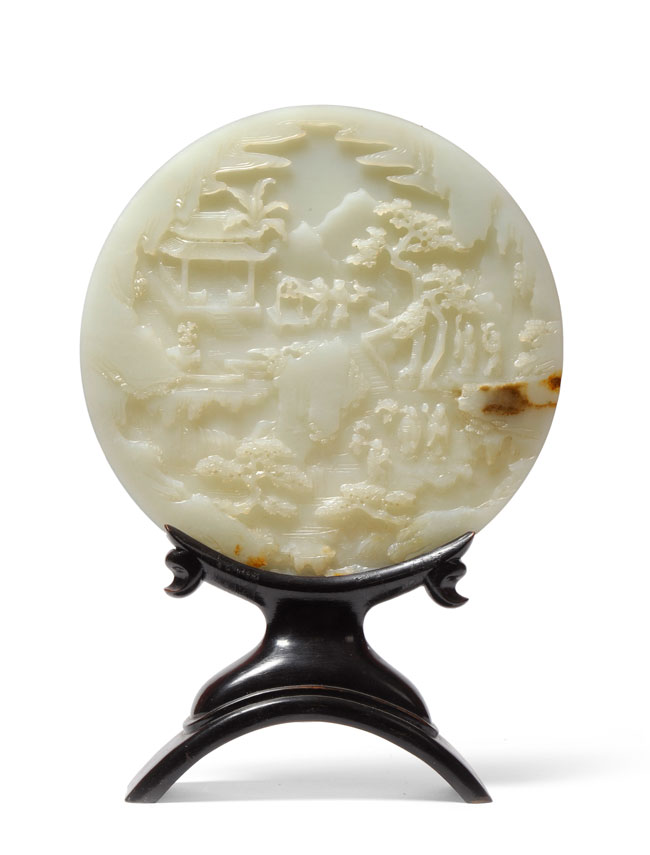
sold for £300,000 to an internet bidder
A plaque measuring just 8 inches across was found in an elderly woman’s retirement flat after her death. Her grandchildren had asked for the property to be cleared, and the work was in progress when an auctioneer came across the decorative jade plate. The expert said it was worth between £2,000 and £3,000, so the grandchildren decided to put it up for auction.
The expert was cautious about the price because the plate has a small mark on it. However, he suspected that the price could rise beyond the estimate, because of the level of interest from overseas buyers ahead of the sale. On the day itself they took 11 telephone lines, and bid the selling price up to £300,000. With fees the buyer will pay £360,000. The proceeds will be shared between her three grandchildren.
The plaque was in fact a circular table screen made for the Chinese Emperor Qianlong during the Qing Dynasty in the 18th century.

![[临渊阁]天地一家春](https://www.antiquekeeper.ca/wp-content/uploads/2023/03/cropped-Asian-Art-Wallpaper-Painting3-6-3.jpg)

